2 Volumes
Constitutional Era
American history between the Revolution and the approach of the Civil War, was dominated by the Constitutional Convention in Philadelphia in 1787. Background rumbling was from the French Revolution. The War of 1812 was merely an embarrassment.
Culture: The Flavors of Philadelphia Life
Philadelphia began as a religious colony, a utopia if you will. But all religions were welcome, so Quakerism mainly persists in its effects on others, both locally and in America, in Art, clubs, and the way of life.
Franklin Inn Club
Hidden in a back alley near the theaters, this little club is the center of the City's literary circle. It enjoys outstanding food in surroundings which suggest Samuel Johnson's club in London.
The Franklin Inn
 Founded by S. Weir Mitchell as a literary society, this little club hidden on Camac Street has been the center of Philadelphia's literary life. 
|
Camac Street is a little alley running parallel to 12th and 13th Streets, and in their day the little houses there have had some pretty colorful occupants. The three blocks between Walnut and Pine Streets became known as the street of clubs, although during Prohibition they had related activities, and before that housed other adventuresome occupations. In a sense, this section of Camac Street is in the heart of the theater district, with the Forrest and Walnut Theaters around the corner on Walnut Street, and several other theaters plus the Academy of Music nearby on Broad Street. On the corner of Camac and Locust was once the Princeton Club, now an elegant French Restaurant, and just across Locust Street from it was once the Celebrity Club. The Celebrity club was once owned by the famous dancer Lillian Reis, about whom much has been written in a circumspect tone, because she once successfully sued the Saturday Evening Post for a million dollars for defaming her good name.
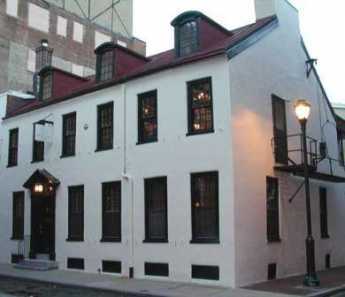
|
| The Franklin Inn |
Camac between Locust and Walnut is paved with wooden blocks instead of cobblestones because horses' hooves make less noise that way. The unpleasant fact of this usage is that horses tend to wet down the street, and in hot weather you know they have been there. Along this section of narrow street, where you can hardly notice it until you are right in front, is the Franklin Inn. The famous architect William Washburn has inspected the basement and bearing walls, and reports that the present Inn building is really a collection of several -- no more than six -- buildings. Inside, it looks like an 18th Century coffee house; most members would be pleased to hear the remark that it looks like Dr. Samuel Johnson's famous conversational club in London. The walls are covered with pictures of famous former members, a great many of the cartoon caricatures by other members. There are also hundreds or even thousands of books in glass bookcases. This is a literary society, over a century old, and its membership committee used to require a prospective member to offer one of his books for inspection, and now merely urges donations of books by the author-members. Since almost any Philadelphia writer of any stature was a member of this club, its library represents a collection of just about everything Philadelphia produced during the 20th Century. Ross & Perry, Publishers has brought out a book containing the entire catalog produced by David Holmes, bound in Ben Franklin's personal colors, which happen to be gold and maroon, just like the club tie.
The club was founded by S. Weir Mitchell, who lived and practiced Medicine nearby. Mitchell had a famous feud with Jefferson Medical College two blocks away, and that probably accounts for his writing a rule that books on medical topics were not acceptable offerings from a prospective member of the club. So there.
The club has daily lunch, with argument, at long tables, and weekly round table discussions with an invited speaker. Once a month there is an evening speaker at a club dinner, with the rule that the speaker must be a member of the club. Once a year, on Benjamin Franklin's birthday, the club holds an annual meeting and formal dinner. At that dinner, the custom has been for members to give toasts to three people, all doctors, including Dr. Franklin, Some sample toasts follow: Benjamin Franklin's formal education ended with the second grade, but he must now be acknowledged as one of the most erudite men of his age. He liked to be called Doctor Franklin, although he had no medical training. He was given an honorary degree of Master of Arts by Harvard and Yale, and honorary doctorates by St.Andrew and Oxford. It is unfortunate that in our day, an honorary degree has degraded to something colleges give to wealthy alumni, or visiting politicians, or some celebrity who will fill the seats at an otherwise boring commencement ceremony. In Franklin's day, an honorary degree was awarded for significant achievements. It was far more prestigious than an earned degree, which merely signified adequate preparation for potential later achievement. And then, there is another subtlety of academic jostling. Physicians generally want to be addressed as Doctor, as a way of emphasizing that theirs is the older of the two learned professions. A good many PhDs respond by rejecting the title, as a way of sniffing they have no need to be impostors. In England, moreover, surgeons deliberately renounce the title, for reasons they will have to explain themselves. Franklin turned this credential foolishness on its head. Having gone no further than the second grade, he invented bifocal glasses. He invented the rubber catheter. He founded the first hospital in the country, the Pennsylvania Hospital, and he donated the books for it to create the first medical library in the country. Until the Civil war, that particular library was the largest medical library in America. Franklin wrote extensively about gout, the causes of lead poisoning and the origins of the common cold. By inventing bar soap, it could be claimed he saved more lives from the infectious disease than antibiotics have. It would be hard to find anyone with either an M.D. degree or a Ph.D. degree, then or now, who displayed such impressive scientific medical credentials, without earning -- any credentials at all. Benjamin Franklin for whom we are named, was after all a club man. In his London years every Thursday he attended the Club of Honest Whigs, and every Monday a coffeehouse called the George and Vulture. His conviviality is part of my theme, but especially his congeniality with women. Scientist and statesman, of course. We nod to bifocals, lightning rod, storage batteries, daylight savings time, less smoky stoves, and a flexible urinary catheter (which he commissioned for his ailing brother from a Philadelphia silversmith). We bow to lending libraries, fire brigades, insurance associations, planned giving, philosophical society, and legislatures. Above all, he helped to design and invent the United States of America, and by example, to inspire the free and mobile society that inhabits our states. But tonight I celebrate his relationships with and his treatment of women. Let me dispose at once of an image of him as young playboy or old lecher. He was always responsible in his relationships. He acknowledged and raised his illegitimate son William (who as royal governor of New Jersey, loyal to the Crown, split with his father). He helped to raise and educate Temple Franklin, the bastard son of his bastard son, who stayed loyal to him as grandfather. His 44-year common law marriage with Deborah Read (an abandoned wife of another man) was a tender and practical bond. She bore two children and managed his print house and bookkeeping. She was half-literate and afraid of the ocean, and so may be thought to have been spared the high politics and intellectual life of England and France. In his duties overseas, Franklin was absent fifteen of the last seventeen years of her life. When she wrote him about rumors of other women, he answered, ".while I have my senses, and God vouchsafe me his protection, I shall do nothing unworthy the character of an honest man, and one that loves his family." His best biographers find nothing to stain his promise to Deborah. That is not to say that he lacked interesting friendships with other women. Four long and intense ones are worth special mention: one American, one English, and two French. Katie Ray was the first of his romantic "but probably never consummated flirtations." When they met, he was 48, she 28. Over the course of their lives, they exchanged more than 40 letters. He "made a few playful advances that [she] gently deflated." Claude-Anne Lopez describes the kind of bond he established, first with Katie, as "somewhat risque, somewhat avuncular, taking a bold step forward and an ironic step backward, implying that he is tempted as a man but respectful as a friend." She uses a French term for this --amitie amoureuse-- a little beyond the platonic, but short of the grand passion." Such a loving friendship he also had with Polly Stevenson. He was 51 when he met her; she, 18. Her intellectual quotient was high, like Katie, and he talked science with her. They exchanged 130 letters. She, as a widow, was at his deathbed 33 years later. Charles Wilson Peale came upon Franklin one day in London, and later sketched what he saw: sitting with a young lady on his knee. She is thought to be Polly. But we should not treat that as a tabloid photo. He was sincere in urging Polly to raise a family rather than pursue more learning. There is nothing as important "as being a good parent, a good child, a good husband, or wife." In Paris, as Ambassador to France, 1776-85, Franklin found two more mistresses of mind and soul. Mme. Anne-Louise Brillon was a famous harpsichordist and a supporter of the American Revolution. When they met, she was 33 and married; he 71 and a widower. In an eight-year relationship, he sent her 29 letters; she to him, 103. She finally turned aside his inquiries about a more corporeal relationship. But she wrote with affection that he demonstrated "a droll roguishness which shows that the wisest of men allows his wisdom to be perpetually broken against the rocks of femininity." Mme. Anne-Catherine Helvetius was a lively and beautiful widow near 60 when she met Franklin at age 73. He eventually went beyond the bounds of his usual dance between sincerity and self-deprecating playfulness. He ardently proposed marriage to her. She found this entreaty a bit wearying. But when in the winter of 1785 he finally departed France, she was there, visiting his home. So was Mme. Brillon; as well as Polly Stevenson and her three children; altogether a splendid "network of good will" with himself at the center. Jefferson, his friend, and successor in Paris noted on his last day before sailing that the ladies were smothering him with embraces. He told Franklin that as well as the duties transferred to him, he wished to have those privileges as well. But Franklin answered: "You are too young a man." Sisters and brothers of the Franklin Inn'let us toast Benjamin Franklin: his constancy with his wife, his well-contained passion, his well-expressed wit, his amitie amoureuse. May his example of loving friendship enfold and inspire the members of our club named for him. -- Theodore Friend At the Annual Dinner of the Franklin Inn Club Philadelphia, 18 January 2008 Based on: Walter Isaacson, Benjamin Franklin: An American Life (New York, 2003) Edmund S. Morgan, Benjamin Franklin (New Haven, 2002) Claude-Anne Lopez, Mon Cher Papa: Franklin and the Ladies of Paris (2nd ed., New Haven, 1990; 1st ed., 1966) JWilliam White left a legacy to the Franklin Inn, the income from which was to pay for an annual dinner, with all the trimmings. Good as its word, the Inn holds the J. William White dinner every year on Benjamin Franklin's birthday, although inflation and fluctuations of the stock market require it to make a modest charge for attendance. White also created the J. William White Professorship in Surgery at the University of Pennsylvania, a chair which was once occupied by Jonathan Rhoads. These trust-fund memorials do little to convey the wild and glamorous image of Bill White. White was a member of the First City Troop and fought the last known honest-to-goodness duel on Philadelphia's field of honor (in the accidental "wedge" of disputed land between Delaware and Pennsylvania). The right and wrong of the argument about wearing the City Troop uniform are in dispute, but the details boiled down to White at the critical moment raising his gun to the sky and firing at the stars. That it was not a meaningless gesture was then brought out by his opponent ( a fellow Trooper named Adams) taking slow and deadly aim -- but missing him. White was an academic in the sense that he was the first, unpaid, Professor of Physical Culture at the University of Pennsylvania. Active in the Mask and Wig Club, he was a chief surgeon at Philadelphia General Hospital, chief surgeon to the Philadelphia Police, and chief surgeon to the Pennsylvania Rail Road. He is the surgeon actually operating in Thomas Eakins' Agnew Clinic, while Agnew himself stands as the "rainmaker", to use a term from legal circles. He was Chairman of the Fairmount Park Commission, and numerous other positions where political contact was more important than surgical skill. When World War I came along, he was off to France with the University of Pennsylvania Hospital Unit, writing two books with Theodore Roosevelt. Although his friendship with Henry James suggests greater literary talent, he was supportive of Adams' transfer of citizenship in protest of America's staying out of World War I; but nonetheless, Roosevelt published more than thirty books. What emerges from the history of Bill White is flamboyance and lots and lots of unfettered energy. He might feel a little out of place at one of his endowed dinners today, but he was probably always a little out of place in any company -- and didn't care a whit. REFERENCES Silas Weir Mitchell lived to be an old man during the Nineteenth Century when it was unusual to get very old. He was an important part of both the Philadelphia medical scene and the literary one. He became known as the Father of American Neurology as a published studies of nerve injuries caused by the Civil War. He published about 150 scientific papers, including famous investigations of the neurological effects of rattlesnake venom. His most famous medical treatment was the "rest cure" for hysteria, while his most enduring scientific discovery was the phenomenon of causalgia. He despised Freud, and psychonanalysis. No doubt the feeling was mutual, but the passage of time has tended to favor Mitchell more than Freud. The central role of sex is the essence of Freud's viewpoint, while Mitchell is summarized in the remark that, "those who do not know sick women, do not know women."Struggling medical students can take heart from the well-documented fact that Mitchell applied to the Pennsylvania Hospital for an internship, and was rejected. Upset by the experience, he toured Europe for a year and applied again. He was again rejected. He later applied for the faculty at Jefferson and was rejected, but his reaction to that was one of rage and vengeance. Just what these two episodes out of Philadelphia medical politics really mean, remains to be clarified by Mitchell's biographers. Mitchell's second career was literary, publishing 12 novels and 5 books of poetry. He is honored as the founder of the Franklin Inn Club, for century home to every important literary figure in Philadelphia. It is striking that he selected Benjamin Franklin as the guiding star of the Inn since Franklin similarly was eminent in both science and culture, and an ornament to conversation and society. In a pacifist Quaker City, both men approved of combat, and his novel about Hugh Wynne stresses that his hero was a "Free Quaker, meaning one who fought in the Revolution. Because of his strong Republican views, he was never made a professor at the local medical school. Mitchell's patient Andrew Carnegie donated the funds to build a new building for the College of Physicians when Mitchell was its President. When Mitchell was president of the Franklin Inn, Carnegie wrote him, asking for suggestions about donating a small sum, say five or ten million, and asking where it should go. That was the Inn's big chance, all right, but somehow it failed the test. Mitchell suggested that the money be given to raise the salaries of college professors, thus perhaps suggesting that this veteran of many academic revolts did eventually soften his views. Who was Dr. J. William White, and why do we drink a toast to him every year at our Annual Meeting? I will answer my second question first: Dr. J. William White died on April 24, 1916, leaving a Will that he finally signed only on March 24 of that year. The Will, drafted by John G. Johnson, the most famous Philadelphia lawyer of that time, runs to 26 pages and disposes of an estate of $868,176.05,--which was real money in 1916. Item 17 of that Will reads as follows: "I give to the Franklin Inn Club of Philadelphia five of its bonds of $100 each to me belonging. IN ADDITION TO THIS, I give to said Club the sum of $5,000 to be invested by the Directors of the Club, with the approval of the majority of the membership, and the income to be expensed in such way as will best subserve the interests of the Club and conduce to its perpetuation. I will be glad if, in doing this, they can assure the occasional remembrance of my name. The Club has been of me the source of so much pleasure and happiness that I feel that I owe it something in return." Well, I have not examined the minutes of our Board to see if it really was discussed and voted upon by a majority of the members, but when I joined in 1968, I was told that Dr. White's bequest had been used for this annual dinner in his memory as long as there was money to pay for it, then only to buy the champagne for the toast to his memory, and then in my time even the champagne money was drunk up. We still talk about him. He was in every sense a "character", a special Philadelphia character. A lot of this information comes from a biography his friend Agnes Repplier published in 1991. J. William White's father James William White Senior was a doctor, the founder of Womens' Maternity Hospital, and President of the S.S. White Dental Supply Company, an extremely successful business which operated until recently from a big building just down there on 12th Street. The Money that flowed from this business enabled our Dr. J. William White to do pretty much what he wanted all of his life. He was a very smart boy, strong, and with a bad temper. He got into fights at school, but he also managed to earn both an MD and Ph.D. from the University of Pennsylvania in 1871, at the age of 21. He maintained a passionate loyalty to Penn all of his life. Directly after graduation, he obtained a job on a U.S. Coastal Survey ship, theHassler on a survey of marine life and ocean bottoms conducted by Professor Louis Aggassiz of Harvard. He was hired as a "Hydrographic Draughtsman" but it turned out he was to be the expedition photographer and film developer because nobody else knew how to do that. Before they sailed, he also wangled a job as correspondent for The New York Herald. They sailed from Boston in December 1871, explored their way around South America and arrived in San Francisco in August of 1872. On his way home by train, young Dr. White stopped in Salt Lake City to hear Bringham Young preach. Bringham Young preached against doctors and lawyers, and told the women in his audience that they should not employ obstetricians, that they and their babies would be better off without them. When Dr. White returned to Philadelphia, he went to work, first as a resident at Philadelphia General Hospital, then a doctor for Eastern State Penitentiary, where he apparently lived for a while, where he took boxing lessons from a giant prisoner. By 1876 he was an Assistant Demonstrator of Practical Surgery at Penn, and a couple of years later he was working under the most prominent Philadelphia surgeon Dr. D. Hayes Agnew. In Thomas Eakins' famous painting "Dr. Agnew in his Clinic" we can see Dr. White doing the actual cutting, while Dr. Agnew is giving the lecture. This picture is also interesting because right there in the middle of the action is a stalwart female, the surgical nurse. By the time of this picture, both Drs White and Agnew were having trouble with the Board of Governors: female students were complaining that they were not allowed into these clinics. Drs Agnew and White replied that "the nature of the diseases and the conditions of the patients made the presence of females undesirable." The doctors offered to quit and the Governors apparently backed down. But what about that nurse? Another famous story: In 1877 Dr. White was elected to the First City Troop . For some reason, this didn't look right for a young doctor, because in these long years between wars, the Troop was known more for parties, banquets, and balls than for national defense. However, he joined, enjoyed the parties and the riding. Previous Troop surgeons had worn regular street clothes; Dr. White put on the fancy Troop uniform. Probably at a party, a Trooper named Adams objected, became loud. Dr. White floored him. Mr. Adams sent a formal challenge to a duel. Sensation! Nobody could remember a duel in Philadelphia, where it was against the law. The newspapers were in an uproar, the New York Herald, for which Dr. White once wrote letters from his voyage around South America, invented a story about a lady who was supposed to be the real cause of the fight. Mr. Adams and Dr. White, accompanied by seconds and a surgeon, crossed the Mason-Dixon Line, took single shots at each, shook hands and went home. Dr. White shot into the air. Years later, Adams confessed that he had aimed at Dr. White, but missed. Eventually, the storm blew over, but it is remembered as the last duel around here -- as far as I Know. As to the City Troop, Dr. White's Will left $5,000 in Trust for a "J. William White Fund, the income to keep remembrance of the facts that I served as Surgeon and was the first incumbent of that position to be directed by the Troop to wear the time-honored full dress uniform." I don't know if the Troop bought champagne to keep remembrance. Although Dr. White became one of the best surgeons here, and wrote several successful textbooks, he is mainly remembered for his passion for athletics. He was made the first Director of Athletics at Penn. He built the first Gymnasium, he built Franklin Field, he arranged for Army-Navy Games to be played here, he got his friend Theodore Roosevelt to attend, he spent every summer either climbing the Rockies or climbing the Alps together with his very sporting and strong wife, Letitia. Letitia was also a better shot than her husband. Perhaps Dr. White's most famous sport was called "Angling for Men". He learned this sport on vacation in Narragansett Bay. The players are in a rowboat, and the contestant jumps into the water, with a strong rope tied around his waist. The Men in the boat try to haul the Swimmer back into the boat, while he resists. When Dr. White was 46 years old it took three of his friends 38 minutes to get him back within 100 feet of the boat, but they never got him in! Dr. White moved in very exalted circles. Among his close friends were Henry James, whom he visited in Rye and who lived with the White's on his visits to Philadelphia: John Singer Sargent, whom Dr. White persuaded to paint his portrait although Sargent had given up portraits; and the famous English doctors Sir Frederick Treves and Sir Joseph Lister, and as I said, President Theodore Roosevelt. In later years, after retiring from regular surgery, Dr. and Mrs. White traveled all over the world, although some patients including John G. Johnson insisted that only Dr, White could do any procedures upon their own bodies! Well, of course, Dr. White had his own problems, and like all men, became a patient himself. In 1906, he developed a hard nodular mass in his left iliac fossa which, I gather, is not good. Probably cancer. He knew what to do. He took a train Rochester, Minn. To his friends the Mayo Brothers. When they decided to operate, three top surgeons from Penn went out to watch. Dr. William J. Mayo operated and successfully removed congenital diverticulitis which had caused a perforation of the bowel. Later: Dr. Mayo: "Well, you're all right." Dr. White "Well, you're a good liar. I've been there myself, and I know." Dr. Mayo: You don't know everything. It's like a bag full of black beans, and one white bean. You pull out the white one. Now get well!" By next summer he was well and traveling again. He received a degree from University of Aberdeen, he met Thomas Hardy, he went to Egypt, next year to China, when the First World War began he was passionately pro-Allies, visited friends in London, visited wounded soldiers at the American Ambulance Hospital in Paris, spent much time there but did not operate, flew over the battlefields in a French military plane, and visited Reims during a German bombardment. He visited the British front, returned to London, involved himself in the issue of Henry James becoming a British citizen because of America's Neutrality, then sailed home across an ocean full of U-Boats. Back in Philadelphia - actually on his estate in Delaware County he raised money for the American Hospital in Paris, and again involved himself in several disputes, about the War, about a Penn faculty member...but now he was dying, we're not clear from what, but it sounds like cancer, after all. He was in great pain and had to be hospitalized. He died in his beloved University Hospital, surrounded by colleagues and friends, on April 24, 1916. I close with a few more words about his Will. As I said, it is 26 legal-size pages, really the story of a life, packed with bequests to every person who was close to him, every organization he belonged to-- and most of them, like the one to us here at the Inn, ask that something be done to remember J. William White, which seems --to me -- little sad. Why were this popular, successful men so afraid of being forgotten? Was it because he and his wife had no children? I don't know, but here, tonight, we remember: I raise my glass-- champagne or not--to the memory of Dr. J. William White, a character if there ever was one! ------given at the Franklin Inn Club on January 14, 2005, by Arthur R. G. Solmssen An address by Arthur Hobson Quinn at the J. William White Dinner on January 17,1952, commemorating the Fiftieth Anniversary of the founding of the Franklin Inn Club. The Founders: Edward W. Bok, Cyrus Townsend Brady, Edward Brooks, Charles Heber Clark, Henry T. Coates, John Hornor Coates, John Habberton, Alfred C. Lambdin, Craige Lippincott, J. Bertram Lippincott, John Luther Long, Lisle De Vaux Matthewman, John K. Mitchell, S. Weir Mitchell, Harrison S. Morris, Ellis Paxson Oberholtzer, Arthur Hobson Quinn, Joseph G. Rosengarten, Charles C. Shoemaker, Solomon Solis-Cohen, Frederick William Unger, Francis Chruchhill Willams, Francis Howard Williams It is a somewhat lonely eminence in which I find myself. That I am the only living founder of the Inn is due simply to the accolade of chronology -I have been able to survive the others! May I take this opportunity to thank the Inn for creating me the first honorary member? My association with it has been purely one of enjoyment; I have never held an Office, and except for membership on Entertainment Committee, I have done little to serve the Inn. It has not been because of any lack of affection. The founding of the Inn was due to some intangible and some concrete impulses. The turn of the century was responsible for many new movements and it is heartbreaking now, to those of us who were young at the time, to remember how we welcomed the dawn of what we were sure would be better days. Centering in Philadelphia, there were at that time an unusual number of men of distinction as creators of literature. Weir Mitchell had written in Hugh Wynnethe greatest novel of the Revolution, and in his Characteristics had created the novel of psychology. Horace Howard Furness, Senior, had won eminence with his Variorum Shakespeare. Henry Charles Lea was producing his histories of the institutions of the Middle Ages. John Bach McMaster had just published the fifth volume of his great History of the People of the United States. John Luther Long had just created the Character of Madame Butterfly, to become a world figure. Langdon Mitchell had won a triumph with his play of Becky Sharp. Owen Wister had scored a popular success with The Virginian, a romance with a theatrical flavor appropriate to the grandson of Fanny Kemble, and while Charles Heber Clark was trying to forget that as Max Adeler he had delighted thousands with his humor, Out of the Hurly-Burly was not forgotten . I can still remember the day when he remarked dryly, "I can not bring myself to read these books written by other people." It should be a matter of pride to us that it was in this creative atmosphere that the Inn was born. All the writers I have mentioned were members of the Inn, and although their participation in our activities varied, their fellowship was an inspiration. I owe to Karl Miller's great statistical ability and keen interest in the Inn some figures which show that of the fifty-one members who joined in 1902, forty-four were then of later listed in Who's Who in America. It was a noteworthy group. As long as I have been selected as the "authority" on the foundation, here is the result of my memories and my research, aided greatly by the labors of the Secretary, William Shepard. For the record, then, the concrete sources were follows: On February 19, 1902, ten men meet at the University Club, drew up a preliminary draft of a constitution and signed a Call for the formation of an "Authors' Club." In our printed booklet of 1950, the statement is made that Dr. Mitchell was present. I see no evidence that he was there, for he did not sign the Call. The account is in the handwriting of Francis Churchill Williams, the first secretary, and it is clear that Dr. Mitchell was elected President in his absence. It is interesting that of the ten signers of the call, J. Bertram Lippincott, John Luther Long, William J. Nicolls, Harrison Morris, and Craige Lippincott remained members of the Inn until their death; that Francis Howard Williams became Vice-President and Churchill Williams was the most active force in the actual organization of the Inn. While Weir Mitchell was not the actual founder, he became the inspiration, the creator of the spirit of the Inn. While he did not belong to any organized preliminary group, his home was the center of gatherings which met there on Saturday evenings after nine o'clock to listen to what he truly described as "the best talk in Philadelphia," and these gatherings were certainly one of the indirect sources of the Inn. Many of his guests joined the Inn, and while I was a guest only after the Inn was founded, I am sure there must have been discussion of such a club. Another concrete source was the Write about Club, a small group of men founded in 1897 and still in existence, who met weekly and read stories and verse for the criticism of their fellows. Among this group were Churchy Williams, who joined it with the idea of turning it into a club such as the Inn became, but found this impracticable; Charles C. Shoemaker, a publisher, for thirty-four years Treasurer of the Inn, needed the money ; Edward Robins, a short story writer; Edward W. Mumford, who became president of the Inn and did great service at the time of temporary low water; Rupert Holland, a director, and still a member of the Inn, and Lawrence Dudley, for many years the active chairman of the Entertainment Committee. The relations of these two clubs were mutual, Dudley and John Haney were first members of the Inn and later joined the Write about Club. Robins, Williams, Shoemaker, and I were first members of the Write about Club and were elected members of the Inn at its foundations. To return to actual meetings of the Inn. Dr. Mitchell did preside at the meeting held at the Art Club on March 4, 1902, when the scope and purpose of the Club were definitely settled. Thirty-two or Thirty-three men were present. The Name of the Club was the subject of heated discussion. Dr. Mitchell objected to the proposed name "Authors' Club." He remarked that the "Authors' Club." in New York was one of the dullest place he has ever visited, and some years later, I was able to confirm his opinion. Another heated discussion as to qualifications was crystallized by the decision that the Club should be founded upon "the book, its creator, its illustrators and its publisher," who made the book available. The undated minutes of the next meeting tells us that the name "Franklin Head" and three for "Authors' Club." I have among my own memorabilia a notice which reads, "A first meeting of the Franklin Inn Club will be held at the Club House, 1218 Chancellor St., at eight, Wednesday evening June 4, 1902." I also find in my scrapbook an invitation reading, "The President of the Franklin Inn Club desires to say that the dinner you have done him the honor to accept will be at the Club House at seven, punctually, on January 6, 1903." It will be noticed that although some of us have made it a point to say "Franklin Inn" without the "Club," the earliest notices were inclusive of that word. The names of the diners are recorded in a framed manuscript, hung on the wall in an inconspicuous place; it should have a more dignified position, for it was the first of these dinners, of which this is the fiftieth. Thirty-six names are immortalized there, signifying the Club's willingness to accept an invitation to good dinner. Dr. Mitchell's presiding was, of course, the feature of any dinner. When he died in 1914 it was impossible to replace him, the resulting election for president tore the Inn in two. I wish to take this opportunity to pay a tribute not only to the first president of the Inn but to the man himself and to the great novelist. He was always willing to help younger writers and great novelist. He was willing to help younger writers, and I owe to his friendship introductions to men like William Dean Howells and others which aided me greatly in my work in American Literature. He was a patrician, as George Meredith recognized when he, in commenting on Dr. Mitchell's Roland Blake, Which he had read three times said, "It has a kind of nobility about it." He imparted this quality to his characters from Hugh Wynne down to Francois, the thief of the French Revolution they too are patricians. They do not argue about caste like the people in the novels of Henry James, who saw his countrymen through a haze of social hopeless. From whatever time or place they come, they are natural gentlefolk, who have seen the best of other civilization, and remained content with their own inheritances of culture. Like all men of spirit, Weir Mitchell had a large capacity for scorn. In his fiction and poetry, this revealed itself in his artistic reticence, springing from the innate refinement of his soul. He knew death in its most horrible forms; he knew life in its most terrible aspects. He had read human minds in the grim emptiness of decay or the frantic activity of the possessed. With his great descriptive power, he could have painted marvelous portraits of the human race in its moments of disgrace. But with a restraint which puts to shame those who today in the name of realism are prostituting their art and exploiting the base or the banal in our national life, the first great neurologist knew the difference between pathology and literature. The scientist knew how bitter life would be for in Roland Blake he said, "if memory were perfect, life unendurable. " But the artist knew that the highest function of literature is to record those lofty moments which make endurable the rest of life. May I appeal with a message from the founders to keep our ideals clear; they would wish me, I know, to remind you that it is not just another club of gentlemen interested in literature. Our Constitution provides for a limited number of distinguished public citizens. But unless the Inn is built around the "Book," it has not kept the spirit and intention of the founders. I realized this is not always easy. Great writers and painters come in clusters. They have come three times to Philadelphia first in the late eighteenth century, when Franklin, Francis Hopkinson, Thomas Godfrey, and Benjamin West established in America the art of the essay, poetry, drama, and painting; second, in the middle of the nineteenth century, when Robert Montgomery Bird and George Henry Baker for the first time challenged the playwrights of England with The Gladiator and Francesca da Rimini, and when Poe spent his six greatest years in Philadelphia; Third, in other group of our founders. Another cluster will arise in Philadelphia and, when that day dawns, may the Franklin Inn keep the light burning to attract them to its fellowship. I believe that ed can be helped by celebrations of the pioneers. I have tried to pay a tribute to them in a bit of verse-. Those days are done. Around the hall
You see the portraits on the wall
Of those who played the founder's part
In this, our friendly home of art,
Whose triumphs we tonight recall. Time runs-He never stoops to crawl-
The veil of memory partly pall
The splendors which the years impart-
Those days are done! Yet when across this evening fall
Clear voices from the past call
The quick blood back along the heart,
We know, by every pulse's start,
That Never, Till the end of all,
Those days are done! -- by: Arthur Hobson Quinn, January 17, 1952 In compliance with the requirements of an Act of the General Assembly of the Commonwealth of Pennsylvania, entitled "An act to provide for the incorporation and regulation of certain corporations," approved the 29th day of April, A.D. 1874, and the supplements thereto, the undersigned, all of whom are citizens of Pennsylvania, having associated themselves together for the purpose hereinafter specified, and desiring that they may be incorporated according to law, do hereby certify: Witness our hands and seals this 17th day of April Anno Domini one thousand nine hundred and two. (signed) S. Weir Mitchell (seal) (signed) J. Bertram Lippincott (seal) (signed) Edward Brooks (seal) (signed) Francis Howard Williams (seal) (signed) William Jasper Nicolls (seal) Commonwealth of Pennsylvania City and County of Philadelphia} ss. Before me, the subscriber, Notary Public for the Commonwealth of Pennsylvania, residing in the City of Philadelphia personally appeared J. Bertram Lippincott, Francis Howard Williams and William Jasper Nicolls, thereof the subscribers to above and foregoing certificate of incorporation of The Franklin Inn Club, and in due form of law acknowledged the same to be their act and deed. Witness my hand and Notarial seal this 17th day of April Anno Domini one thousand nine hundred and two. (signed) Winfield J. Walker, Notary Public In the Court of Common Pleas No 5 of Philadelphia County of March Term, 1902. No. 2657. And now, this 12 day of May A.D. 1902, the above Charter and Certificate of Incorporation having been on file in the office of the Prothonotary of the said Court since the 18th day of April A.D.1902, the day on which publication of notice of intended application was first made, as appears from entry thereon, and due proof of said publication having been therewith presented to me, a law Judge of said County, I do hereby certify that I have perused and examined said instrument and find the same to be in proper form and within the purposes named in the first class of corporation specified in section 2 of the act of the General Assembly of the Commonwealth of Pennsylvania, entitled "An act to provide for the incorporation and regulation of certain corporations," approved April 29th 1874, and the supplements thereto, and that the said purposes are lawful and not injurious to the community. It is, therefore, on motion of William Morris, Esq. on behalf of the petitioners, ordered and decreed that the said Charter be approved, and is hereby approved, and upon the recording of the said Charter and its endorsements and this order in the office of the Recorder of Deeds in and for said County, which is now hereby ordered, the subscribers thereto and their associates shall thenceforth be a corporation for the purpose and upon the terms and under the name therein stated. (signed) Robert Ralston, Judge Recorded in the office for the recording of deeds In and for the County of Philadelphia in Charter Book 27 page 209. Witness my hand and seal of office this 13th day of May Anno Domini One thousand nine hundred and two. (signed) Wm. S. Vare, Recorder January 17, 1706 Born in Boston, the thirteenth child of a candle maker; only went through 2nd Grade, Apprenticed to his brother as a printer, ran away to Philadelphia age 17 . 1725-26 First trip to England. Researched printing equipment, but probably lived a riotous life. 1726-1748 Returned to Philadelphia to found his own print shop and bookstore. Wrote and printed Poor Richard's Almanack organized local tradesmen into the Junto, formed partnerships with sixty printers throughout the colonies, obtained the print business of local governments, became postmaster. Able to retire at the age of 42 by selling his business for 18 annual payments, which offered him comfort and ease for considerably longer than his life expectancy.
------------------------------------------------------------------------------- 1751 Helped found Pennsylvania Hospital. Entered the legislature. 1751-1757 Active in legislature, rising to leadership during the French and Indian War, Pontiac's Rebellion and the uprising of the Paxtang Boys.A Toast to Doctor Franklin
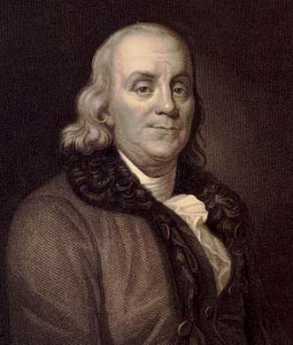
Benjamin Franklin
Toast To Benjamin Franklin

Benjamin Franklin,
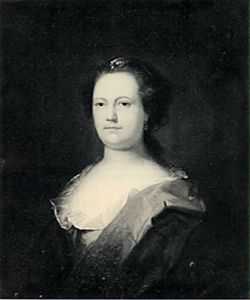
Deborah Read
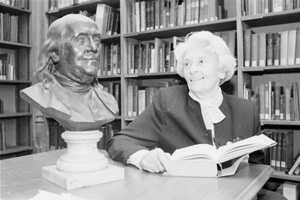
Claude-Anne Lopez
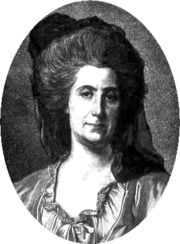
Anne-Catherine Helvetius
A Toast To J. William White, MD
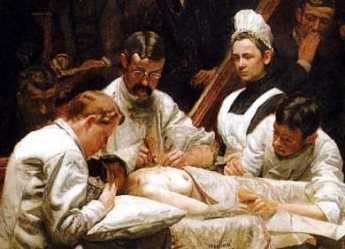
William J White MD
Philadelphia Gentlemen: The Making of a National Upper Class: E. Digby Baltzell ISBN-13: 978-0887387890
Amazon A Toast To Silas Weir Mitchell, MD
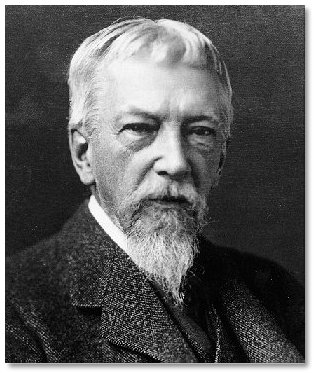
Silas Weir Mitchell

Franklin Inn

College of Physicians
Yet Another Toast to Dr. J. William White

Dr. J. William White
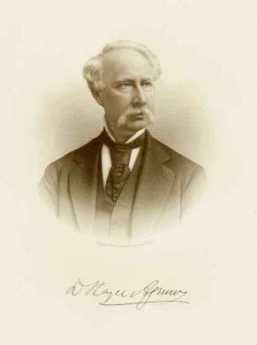
Dr. David Hayes Agnew
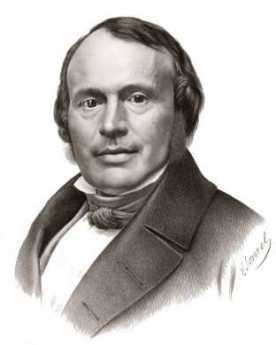
Professor Louis Agassiz
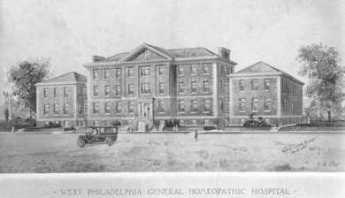
PGH
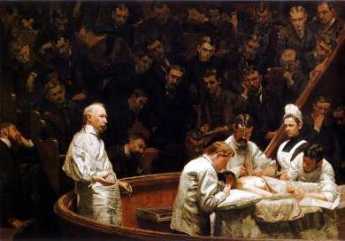
Agnew Clinic
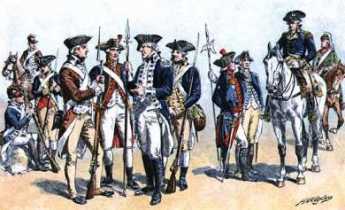
First City Troops
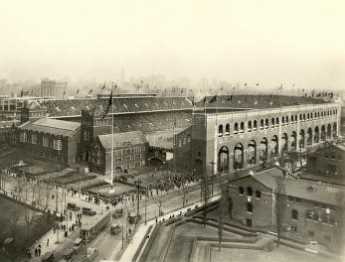
Franklin Field

Army-Navy Games

Narragansett Bay
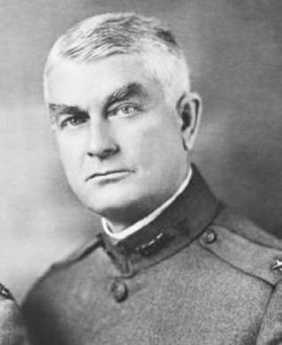
William Mayo
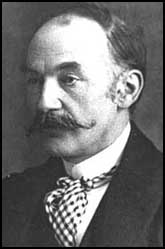
Thomas Hardy
The Founding of The Franklin Inn Club
Charter of Incorporation of Franklin Inn Club (1902)
Benjamin Franklin: Chronology

Ben Franklin on the cover of Time magazine
1723 Arrived in Philadelphia penniless, readily found work as a printer.
1757-1762 Second time in England. Acted as representative of both Pennsylvania and Massachusetts. After his electoral defeat, he returned to England for a total of eighteen years, suggesting hidden British sympathies may have been present. .
1762-1764 Returned to Pennsylvania Legislature, where his unpopular agitation for replacing the Penn Proprietors with direct Royal government led to his electoral defeat and the end of his elective career. The defeated but determined Quaker party sent him to England to lobby against the Penn family and for the rule of Pennsylvania by the King.
1764-1775 Third British visit. Although unsuccessful in his lobbying, his fame as a scientist made him welcome among the famous members of the Enlightenment, like Hume, Adam Smith, Mozart. Meanwhile, the colonies became considerably more rebellious than he was. His blunder with the publication of some letters gave the British Ministry an opportunity to humiliate and disgrace him in public, probably as a warning to the mutinous New England leaders. It irreconcilably alienated Franklin, who sulked, then packed up and joined the Continental Congress the day he arrived back home.
March, 1775-October, 1776 Brief but fateful return to America. Decisions were made in London to put down the colonists by as much force as necessary. Meanwhile, Franklin persuaded the Continental Congress they must declare independence from England if they expected help from the French.
July 4, 1776, Independence is declared within days after the arrival of a massive British fleet in New York harbor. Franklin dispatched to France to secure the assistance he was confident he could get.
1777-1785 France. Franklin served admirably as American ambassador, his wit and charm persuading the French to overextend themselves with ships, supplies, and money, and very likely contributing to the French Revolution by popularizing the American one.
1785-1790 Returning as a national hero for his final five years of life, Franklin loaned his personal influence to the constitutional convention, became President of Pennsylvania, worked for the abolition of slavery.
April 17, 1790 Died, probably of complications associated with kidney stones.
Logan, Franklin, Library
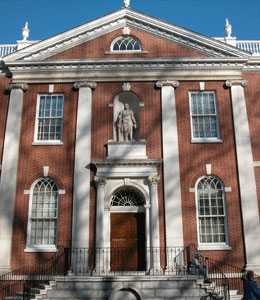
|
| The Library Company of Philadelphia |
Jim Greene is the librarian of the Library Company of Philadelphia, and one of the leading authorities on James Logan, the Penn Proprietors' chief agent in the Colony. Since Logan and Ben Franklin were the main forces in starting the oldest library in America, knowing all about Logan almost comes with the job of Librarian. We are greatly indebted to a speech the other night, given by Greene at the Franklin Inn, a hundred yards away from the Library.
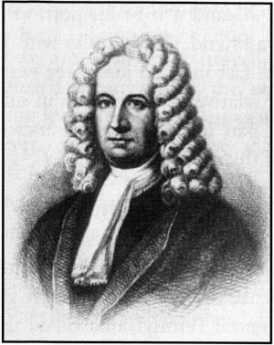
|
| James Logan |
Logan has been described as a crusty old codger, living in his mansion called Stenton and scarcely venturing forth in public. He was known as a fair dealer with the Indians, which was an essential part of William Penn's strategy for selling real estate in a land of peace and prosperity. Unfortunately, Logan was behind the infamous Walking Purchase, which damaged his otherwise considerable reputation. Logan must have been a lonesome person in the frontier days of Philadelphia because he owned the largest private library in North America and was passionate about reading and scholarly matters. When he acquired what was the first edition of Newton's Principia, he read it promptly and wrote a one-page summary. Comparatively few people could do this even today. It's pretty tough reading, and those who have read it would seldom claim to have "devoured" it.
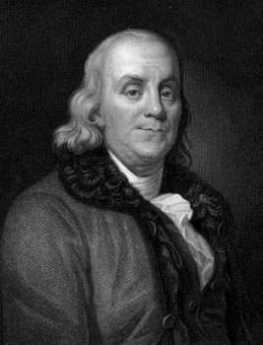
|
| Benjamin Franklin |
Except young Ben Franklin, who never went past second grade in school. The two became fast friends, often engaging in such games as constructing "Magic Squares" of numbers that added up to the same total in various ways. For example, Franklin doodled off a square with the numbers 52,61,4,13,20,29,36,45 (totaling 260) on the top horizontal row, and every vertical row beneath them totaling 260, as for example 52,14,53,11,55,9,50,16, while every horizontal row also totaled 260 as well. The four corner numbers, with the 4 middle numbers, also total 260. Logan constructed his share of similar games, which it is difficult to imagine anyone else in the colonies doing at the time.
Logan and Franklin together conceived the idea of a subscription library, which in time became the Library Company of Philadelphia in 1732. The subscription required of a library member was intended to be forfeited if the borrower failed to return a book. Later on, the public was allowed to borrow books, but only on deposit of enough money to replace the book if unreturned. We are not told whose idea was behind these arrangements, but they certainly sound like Franklin at work. More than a century later, the Philadelphia Free Library was organized under more trusting rules for borrowing which became possible as books became less expensive.
Logan died in 1751, the year Franklin at the age of 42 decided to retire from business -- and devote the remaining 42 years of his life to scholarly and public affairs. He first joined the Assembly at that time, so he and Logan were not forced into direct contention over politics, although they had their differences. How much influence Logan exerted over Franklin's plans and attitudes is not entirely clear; it must have been a great deal.
Madame Butterfly (2)
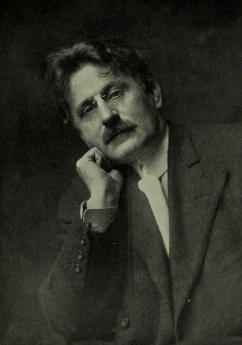
|
| John Luther Long |
There are two ways of looking at the love affair of Pinkerton, the dashing Philadelphia naval officer, and Madame Butterfly, the beautiful Japanese geisha. John Luther Long wrote about it one way, while Puccini somehow portrays it differently, even though Long collaborated on the Libretto of the opera. Puccini, of course, was himself a famous libertine, tending to follow the typical belief of such men that women somehow enjoy being victimized. Long in real life was a Philadelphia lawyer, trained to keep a straight face when people relate what messes they have got into. If you know the story, you can see Long in the person of Sharpless, the consul. Sharpless is definitely meant to be a Philadelphia name.
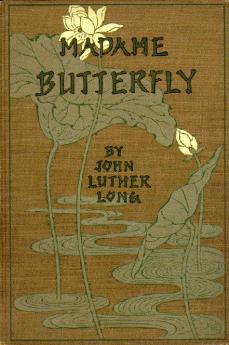
|
| Madame Butterfly |
Long was one of the early members of the Franklin Inn, and it is related he wrote much of his successful play at the tables of the club on Camac Street. David Belasco was the "play doctor" who knew how to make a good story fill theater seats. Even after Belasco's polishing, the play came through as a portrayal of the well-born gentleman who had been trained to regard foreign girls as just what you do when you are away from home. His real girlfriend, the beautiful Philadelphia aristocratic woman in a spotless white dress, was the sort you expected to marry. In just a few sentences of Long's play, this woman comes through as just about as distastefully aloof to foreign women as it is possible to be while remaining rigidly polite about it. Butterfly sees this at a glance, knows it for what it is, and knows it is her death. Her duty immediately is "To die honorably, when one can no longer live with honor".
It is Puccini's genius to take this story of how two nasty Americans destroy an honorable Japanese girl and using that same story with the same words, make it into a romantic woman being destroyed by a hopeless, helpless love affair. The power of the music overwhelms the story and sweeps you along to the ending. Even if you feel like Long/Sharpless, dismayed and disheartened by watching some close acquaintances doing things you know they shouldn't.
When Puccini's opera comes to Philadelphia every year or so, the Franklin Inn has a party for the cast, one of the great events of the Philadelphia intellectual scene. Somehow, the full intent of Luther Long's work never seems to come out.
The Pennsylvania Horticultural Society was founded in 1827, and it organized the first Flower Show in 1829. For a century it was only an amateur display, very similar to the sort of local garden club display found in many towns and villages in England. The timing of such shows is dictated by the booming season of the flowers of the region, so the display depends on the dates of the local flowers, related in turn to soil and weather conditions. In the early part of the Twentieth Century, W. Atlee Burpee became the dominant force in the Philadelphia show. The show established a long tradition of domination by seed companies and nurseries, with elaborate displays which often took a week to set up, preceded by months or years of planning. The central difference in the nature of the Philadelphia show was that plants were forced into bloom, so much of its impact depended on displays which were seemingly entirely out of season. After World War II, Ernesta Ballard became the moving and controlling force, driving The Show into enormous popularity in the new larger quarters at Convention Hall. Considerable revenue was generated and used to beautify Philadelphia. The Show became the biggest, best, most popular and best funded flower show in America. Ernesta was a success.
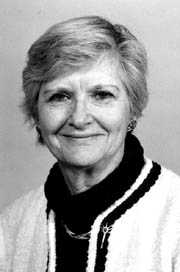
|
| Mrs. Ballard |
Gradually, the most elaborate or dominant displays were put on by florists, using cut flowers. That was not necessarily Mrs. Ballard's original intention, although it might have been. It is the nature of plant nurseries to take away a ball of topsoil when they sell a plant, and that tends to dictate the location of the major nurseries in places where farmers are willing to ruin the land for farming, looking to speculate on suburban development. They thus are usually rural or exurban, because prime farmland is too expensive. Obviously, nurseries are pressed outward from the rim of the expanding city, and may even be forced to locate at a considerable distance away. These realities of the business tend to diminish the local loyalties of the nurseries and the city to each other. Mainly, cut flower arrangements resisted this trend by using greenhouses, but air freight has now made it possible for exhibitors of live plants to come from the Netherlands, Peru, and even Korea. The Flower Show is still held in Philadelphia, but it is much less a product of Philadelphians, especially amateur Philadelphians. When large single exhibits now can cost $100,000 apiece to organize, it is not surprising that the Philadelphians who do exhibit, are members of the upper crust.
And then there are those unions. While upper crust exhibitors can afford to pay full union wages for an electrician to plug in one electrical outlet, they are instantly offended by the whole featherbedding experience of being forced to do it. And since a great many blue collar union members are hostile to any suggestion that these gentleman farmers are in any way their social superiors, they can display what is known as an attitude. Philadelphia is famous for aggressive unions, and the Convention Center is additionally notorious for unions with political clout. Somehow, the politicians in charge of this unfortunate passive-aggressive scene get control of it and are seen to get control of it. After all, snooty exhibitors are occasionally in a position to move whole factories out to the suburbs, to the general injury of the city; moving a flower show wouldn't be too hard to do. The paradox is that 70% of these union members live in the suburbs themselves. The Flower Show cannot run without the enthusiastic help of 3500 volunteers, easily turned off by muscling them. The judging is done by 175 volunteer judges from all over America, coming to Philadelphia at their own expense, for example.
The Flower Show has had memorable moments. There was a time when the Shipley School consistently won most of the prizes. There was a famous episode when the Widener Estate of Linwood had a world-famous Acacia display. When it was broken up, there was an uproar when it was given to Washington DC, instead of staying right here where it belonged. Now, the gossip is about exhibitors from Ukraine, or from Japan, making little laughable mistakes about local geography with many streets named One Way.
The Show goes on and thrives. But just what its future is going to be is unclear. The Convention Center has doubled its space, but whether it can double its business is uncertain. And the management has recently changed from leadership which had a focus on the show and regarded city beautification as something to do with left-over profits, to leadership with a primary interest in the beautification of the city. No business will thrive if it neglects its revenue stream. So, please be careful with our nice Flower Show.
REFERENCES
| Standardized Plant Names: American Joint Committee on Horticultural, Frederick Law Olmsted | Google Books |
Durance Vile

|
| Castle of Ferdinand and Isabella |
Visitors to the royal castle of Ferdinand and Isabella are routinely shown the iron grating beneath the throne, below which is a small dark hole for a couple of prisoners. By contrast, most American cities have prisons containing thousands of prisoners. At the time of the discovery of America, dungeons were places to hold a few important prisoners waiting for execution or ransom. What happened to other criminals is left to the imagination, and ranged from public flogging to public execution, often preceded by torture. Torture was not primarily a method for extracting espionage from a spy, it was a form of punishment, quite explicitly designed to horrify and intimidate others who needed the warning to prevent crime. Imprisonment was too expensive to be justified in the case of ordinary crime; in the Eighteenth Century, it was common to hang people for stealing a loaf of bread. Hanging alone might not be sufficiently awesome; the hanged criminal was often torn apart and the pieces of meat dragged through the streets by horses. In extreme cases, hanging was dispensed with and it was sufficient to draw and quarter the miscreant.
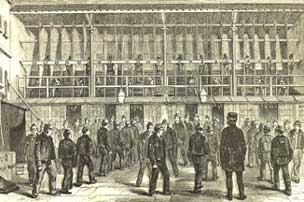
|
| Victorian Era Prison |
Without further unnecessary detail, the point must be made that imprisonment was originally devised as a humane improvement, an enlighted advance. It is nevertheless entirely true that prison conditions in every jurisdiction in every country -- are unspeakably bad. While it is probably true that public officials commonly take the view that if we must have these prisons, it is of some deterrent value to spread rumors that they are worse than they actually are. The central truth is that prisons are more expensive than most people want to spend on deterrence and punishment; so they are characteristically underfunded, and most evils grow out of the pinch-penny management which the taxpayers force on the wardens. Bleak, dank and dirty, usually a century or more old, with disgusting food, cramped quarters, and a pervasive atmosphere of suppressed violence, sometimes inadequately suppressed, these forgotten warehouses confine prisoners and jailers alike in a cloud of well-justified terror of each other. Add to this mess of the Victorian era, the more modern features of HIV, male rape and smuggled drugs, and everyone involved are ready for a new approach. If only someone could devise one.

|
| Allen Hornblum |
At the Franklin Inn recently, Allen Hornblum appalled the literary lights of the city with a description of one of the lesser but nevertheless unnecessary sins of the system, the recruitment of volunteer prisoners for medical experimentation. Forget that the prisoners are all convicted of serious crimes, often as a result of a psychopathic mindset; many of them are illiterate, bored to tears, and desperate for a little spare cash to spend on the prison luxuries of sex, cigarettes, drugs, protection from other prisoners, candy and prestige. The prisons themselves set the monetary exchange rate at $.25 a day for working in the laundry; pharmaceutical firms may be unnecessarily generous in paying a dollar a day for medical volunteers. As described in his two books, Acres of Skin and Sentenced to Science, this Temple professor felt skin experiments were particularly gruesome to behold. When the prisoners were often covered with many Band-aids over their patch tests and biopsies, it gave newcomers an immediate impression that they represented widespread fighting and violence, when of course they were mostly harmless. The language of the streets is magnified in prison, and it infects the speech of the clinical investigators no matter how hard they try to blend in while they do their work.
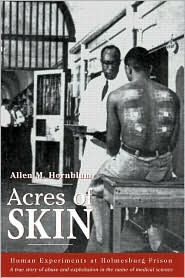
|
| Acres of Skin and Sentenced to Science |
Meanwhile, medical personnel in a prison are neither jailers nor prisoners, and commonly inject a worrisome outside observer status into the submerged civil war. Both prisoners and jailers court the nurses and doctors but occupy a dangerous ground. They can give out medical excuses, drugs, escape opportunities, and more or less impartial testimony if there is an outbreak of violence. Violence by the guards is observed without comment or intervention because the guards are the only hope of protection if the prisoner's riot. Guilty secrets are more or less kept inviolate, but both sides of the war distrust this ethical principle. Everybody, but especially a doctor or nurse, endures constant silent appraisal. Unattractive rumors abound.
Consequently, medical care in prison everywhere is unavoidably substandard. Although the jailhouse lawyers would love to sue somebody for something, it's hard to see what could be accomplished for more than a brief time. There seem to be a number of billionaires who would like to do something to help this situation, but what this problem needs is not more money, but a better idea. Should we really go back to flogging, branding irons and gouging out eyes? It would be cheaper, but if the reformers really want reform, they have to suggest something that would work. So we could all agree to do it.
Franklin's Admirers on TV
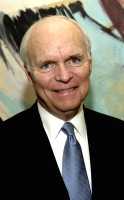
|
| Brian Lamb |
There are now three channels of C-span, continuous cable television programs about the influence of history on current problems. Sessions of Congress and its committees, the speeches of the President, political campaigns, are shown as they happen. But interviews and book reviews are shown in parallel, with an opportunity to go into the archives and organize originally unrelated programs into seminars on a current topic. The editor, Brian Lamb, has a light hand and considerable impartiality. But he's there, all right, organizing blogs into topics just as Philadelphia Reflections tries to do.
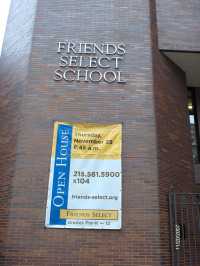
|
| Friends Select School |
This similarity of design had been floating around for some time, but it suddenly came into focus when I recognized myself in the front row of an audience on C-span, listening to Edmond S. Morgan talking at the Friends Select School about his new book on Benjamin Franklin, a few months earlier. Thank goodness I bought a book and had it autographed because the filming had been so unobtrusive I hadn't noticed it at the time. I clearly need to have haircuts more frequently. Professor Morgan's parting words that evening had stayed with me, "Franklin doesn't tell you everything about himself, but what he tells you -- is straight." That's quite a compliment from the editor of 47 volumes of Franklin's work.
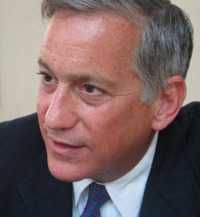
|
| Walter Isaacson |
Grouped with this tv portrayal of me as a groupie were interviews with Walter Isaacson and some other Franklin biographers, taken at other times and placing focus on other aspects. Here again, more insights emerged from quickly considered replies to audience questions than from the prepared speeches. Replies to questions from the audience are more in a class with blogs, anyway. Whenever you get all of the adjectives and qualifications polished, you sometimes don't say what you mean. Perhaps that last comment can be rearranged to say that answering audience questions occasionally leads to blurting out precisely what you mean.
And so, two unrelated audience answers need to be linked. A question about Franklin's love life caused Isaacson to refer to Franklin as a lifelong seducer. From the unknown mother of his illegitimate son William, to the simultaneous flirtations with two famous French ladies that took place when he was an octogenarian, and not overlooking several other affairs with Cathy Green and Polly Stevenson and allusions to others, Franklin was obviously an accomplished seducer in the full meaning of the term. It is thus legitimate to suspect the techniques of seduction at work in many of his public projects, from starting the Library Company to persuading the French to help the Revolution. He discovered late in life what many have discovered about the life of a diplomat, and quickly recognized that he was already pretty good at what that seemed to entail. Let's slide to a slightly different application of that idea.
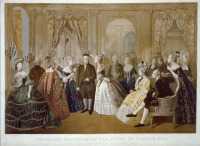
|
| Benjamin Franklin and French Women |
By the accident of hostess seating arrangement, I found myself seated next to two historians from Harvard, and somehow it came out that one of them felt that Franklin loved the French. Simply loved them. Somehow that didn't sound quite right when compared with Franklin's early years of mobilizing Pennsylvania to fight the French, starting the first National Guard militia unit to defend Philadelphia against French raiders, supporting General Braddock's expedition with his own money, urging the British government to sweep the French from Canada, and working most of his life to assemble the colonies and Great Britain into one world-dominating entity. It's true that 18th Century France was at the peak of scientific achievement, and Franklin the inventor of electricity was quickly taken in by the European scientific community, but that's scarcely the same thing as loving France. Louis XVI was in fact quite annoyed by all the attention Franklin was receiving. And so the scholar on TV went on to say that correspondence had been discovered in which Franklin quite casually remarked that during the Continental Congress he had strongly argued that America should stand alone and have no European allies. Congress it seems overruled him, so he dutifully set sail for France to seduce them.
We come to another chance social encounter. On a recent trip to Paris, the GIC had taken along as a speaker, no less than a member of the Open Market Committee of the Federal Reserve, a Governor of a Federal Reserve District, to speak about the threat of inflation and currency crisis. In time, our French hosts invited us to look at some documents of interest, like the Louisiana Purchase. Lying on the table was the original treaty between America and France, signed by B. Franklin. The Federal Reserve governor, making small talk, observed that Franklin sweet-talked the French into loaning America too much money, eventually leading to their bankruptcy. As I recall, my rejoinder was, "Well, just print some more paper money, right?" It was intended to be a jocular remark, but it somehow didn't seem to be taken as such.
Frank Furness,(3) Rush's Lancer
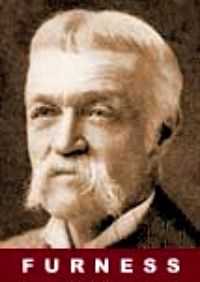
|
| Frank Furness |
Lunch at the Franklin Inn Club was recently enlivened by David Wieck, who not only does the sort of thing you get an MBA degree for but is also a noted authority on the Civil War. His topic was the wartime exploits of Frank Furness, whose name is often mispronounced but whose thumbprints are all over the architecture of 19th Century Philadelphia. Take a look at the Pennsylvania Academy of Fine Arts, Boathouse #13 of the Schuylkill Navy, the Fisher Building of the University of Pennsylvania, and many other surviving structures of the 600 buildings his firm built in 40 years. One of them is the Unitarian Church at 22nd and Chestnut, where his grandfather had been the fire-brand abolitionist minister.
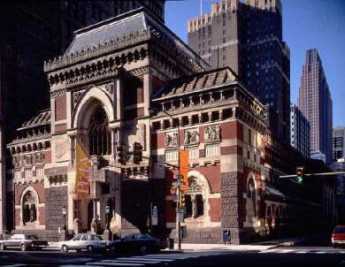
|
| PennsylvaniaAcademy of Fine Arts |
The Civil War seems to have transformed Frank Furness in a number of ways. He had been sort of in the shadow of his older brother Horace, a big man on the campus of Princeton, later the founder of the Shakspere Society, and the Variorum Shakespeare. Frank was quiet, and good at drawing. However, at age 22 he was socially eligible to join Rush's Lancers, the 6th Pennsylvania Cavalry, which contained among other socialites the great-grandson of Robert Morris, and a member of the Biddle Family who put up the money to equip the troop with 7-shot repeating rifles. Cavalry units like this were a vital weapon in the Civil War because they needed young well-equipped expert horsemen with a strong sense of group loyalty. Rifles were considered too expensive for infantry, who were equipped with muskets that took several minutes to reload, and were unwieldy because they were only accurate if they were very long. When bands of daredevils on horseback suddenly attacked with seven-shot repeating rifles, they could be devastating against massed infantry. A flavor of their bravado emerges from their rescue of General Custer's men from a tight spot, later known in the annals of the troop as "Custer's first last stand."
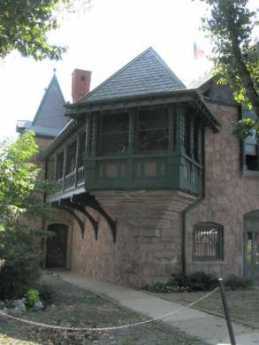
|
| The Undine Barge Club Boathouse #13 of the Schuylkill Navy |
There are two famous stories of the exploits of Frank Furness, first as a second Lieutenant and later as a Captain at Cold Harbor two years later. In the first episode, a wounded Confederate soldier lay on the no man's land of forces only a hundred yards apart. His screams were so heart-rending that Furness ran out to him and put a handkerchief tourniquet around his bleeding thigh. Because the fallen man was a Confederate soldier, the Confederates held their fire and later cheered the Union cavalryman for his kindness. The wounded man called out "
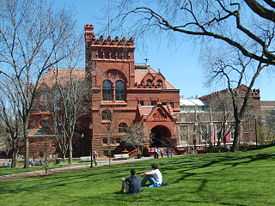
|
| The Fisher Building of the University of Pennsylvania |
In the second episode, the cavalry had spread out too much, leaving some isolated parties trapped and out of ammunition. Furness lifted a hundred-pound box of ammunition to his head and ran through the gunfire with it to the trapped men. For this, he later received the Congressional Medal of Honor. Somehow all of the public attention he received in the war transformed Furness from a younger brother who was good at drawing into a dynamo of energy, much in the model of what law firms call a "rainmaker". He traveled to the Yellowstone area of Wyoming at least six times, bringing back various trophies. He was known to get people's attention by using his service revolver to take pot shots at a stuffed moose head in his office.
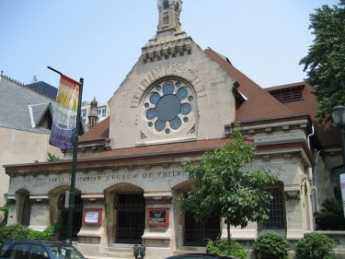
|
| First Unitarian Church 22nd Chestnut Philadelphia |
His final publicity venture was to advertise, forty years later, in Southern newspapers for the whereabouts of the Confederate soldier whose life he had saved. Eventually, a man named Hodge who had later been a sheriff in Virginia, stepped forward to renew his blessings and thanks. Hodge was brought to Philadelphia for a celebrated 6th Cavalry reunion, and a picture of the two former enemies was spread in the newspapers. It was a little embarrassing that Furness and Hodge found they had very little to say to each other for a five-day visit, but Hodge eventually proved able to be one-up in the situation. He outlived Furness by five years.
Although the style of Furness confections seemed and seems a little strange to everyone except Victorian Philadelphians, he did leave a major stamp on American architecture. His most noted student was Louis B. Sullivan, who put an entirely different sort of stamp on Chicago. And Sullivan's best-known student was Frank Lloyd Wright who created a modernist image of architecture for the West. The buildings of these three don't look at all alike, but their rainmaker personalities are all essentially the same.
World Finance, Columbus Day 2008
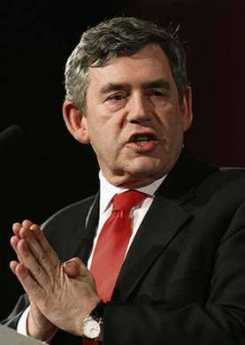
|
| Prime Minister Gordon Brown |
WITH voters watching three weeks before the 2008 American presidential election day, finance ministers and their political masters met to decide a basic question: dare they risk disaster to save the existing system, or play it safe by sacrificing small banks to rescue big ones? That is, guess if the situation is so bad only strong rowers can be allowed in the lifeboat, or whether things are really manageable enough to try to save everybody but at the risk of worse consequences for failure. For example the credit default swap mystery; there are $60 trillion notional value insurance policies in existence to cover $20 trillion of bonds. Is that massive double-counting, or an actual disaster so severe it makes every other consideration trivial? Answer quick, please, the ship looks like it might sink. At first, it seemed strange a Labor government in England would propose saving only the strong until you realize that Prime Minister Brown is protected from his Left, while the Democrats in America want to use a fairness argument to win their election. A Republican lame-duck president must do the deciding, a man who has been shown to be both a tough politician and a fearless gambler; playing things safe is not his style. The Dow Jones average soared a thousand points in a day's trading on the prayer that things were finally under control. But take a look around.
Little Iceland and Switzerland are proud to house some enormous banks. But if those banks approach failure, their homeland treasuries are far too small to bail them out.
On the other hand, little Hungary has a negligible banking system, so Hungarians commonly borrow money from foreign banks. The national currency devalued by half in this crisis, so most Hungarian mortgages doubled in price. Reserve systems based on national governments suddenly look obsolete.
Try another approach. Little Ireland went ahead and guaranteed all deposits in its financial institutions. Money from England and the rest of Europe immediately poured in to enjoy that guarantee, forcing other grumpy nations to match the unwise Irish offer. There's a sense that nations are losing control of their affairs.
Europe consists of 27 nations, of which fifteen are in the Euro zone. There are common currency and a constrained central bank, but can this gaggle of geese possibly agree on concerted action in this crisis? America was once in this situation under the Articles of Confederation, but even after almost losing the Revolutionary War, George Washington was nearly unable to get the colonies to form a union. Even after this experience, the Southern Confederate States later adopted the same system of a central currency without a central government and really did lose their war.
Are we to infer from Prime Minister Brown's attitude toward banks that he might soon suggest ditching little nations in order to save bigger ones?
www.Philadelphia-Reflections.com/blog/1525.htm
For the Good of the Order
Although it has older origins, Roberts Rules of Order provide a place in every meeting for remarks "for the good of the order", suggesting there should always be an opportunity to deviate from strict germaneness to speak about something which is clearly worth talking about. Although meetings for business usually appoint a chairman, speaker or clerk to preserve order and germaneness, the truth is that most meetings which lose the opportunity to introduce something worthwhile which is a little off the subject, do so because of habit and tradition rather than devotion to focus. In recent years, remarks for the good of the Order have become so uncommon that speakers tend to rise on "a point of personal privilege", although provision for this had in mind birthday greetings and the like.
I suggest it might be a useful and entertaining thing to devote some meetings of the Franklin Inn to discussions of ways we could improve the club, and if the club has seemingly already reached perfection, to ways of improving Philadelphia and its Commonwealth.
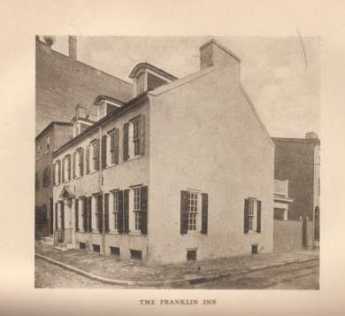
|
| The Franklin Inn |
Such an effort will struggle at first, so it needs a core group to assure hesitating attendees that something worthwhile will be said. That core group may include officers and officials who are charged with running the club, the city or the state, but the opinions of the meeting should carry no enforcement powers other than their intrinsic validity. Admittedly, there is a natural restlessness of independent thinkers that their ideas should go somewhere, so the meetings should maintain minutes, perhaps on a website.
The attendees should pay for their lunches with meal tickets, but should also maintain a book of tickets for invited guests, and sell tickets to uninvited ones. If the present markup for tickets is maintained, an attendance of six regulars would sustain the invited speaker ticket book, and the attendance of six uninvited (no-club members) would make subsidy unnecessary. For the initial year, however, the club itself should subsidize speaker lunches. If there are conflicting meetings the Meetings for the Good of the Order should move to the second floor, and perhaps that is the best place for all of them.
These meetings should not fall into the trap of grieving that their innovative suggestions are not adopted, although they may be forgiven for celebrating the occasions where an idea does get implemented. The goal is to help an idea grow legs, and then watch it travel, ever mindful that much can be accomplished when we disregard who gets credit for it.
Edgar Allan Poe, 1809-1849
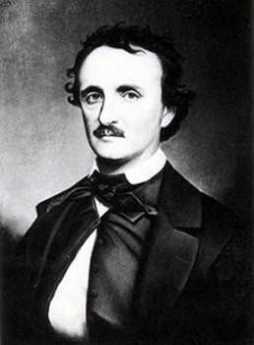
|
| Edger Allan Poe |
Between the Federalist period and the Civil War, Philadelphia quadrupled in population, mostly by Irish and black immigration responding to the urbanization induced by the Industrial Revolution. The social boundaries of this period were established by the U.S. Capital moving away to Washington, and at the other boundary, the constrained urban population was suddenly released to the suburbs by the City-County Consolidation of 1854. During that time, the Northern Liberties on the other side of Callowhillwere very close by, but nearly devoid of law and order. At least along the Delaware River, the scene was like Las Vegas as imagined by Charles Dickens. Within the increasingly congested boundaries of the city itself, tuberculosis, alcoholism, riots and religious revivalism are all mentioned prominently. While it was the time of Nicholas Biddle and the Bank, and the establishment of the Drexel empire, it was a gothic period quite adequately symbolized by Ethan Allan Poe, writing for Graham's Magazine. His father abandoned the family, his mother and later his wife died of tuberculosis, he was definitely an alcoholic and probably manic-depressive. He and Charles Brockton Brown invented the gothic novel, gothic poetry, the modern murder mystery. Poe only lived in Philadelphia for six years but lived in seven different locations, the most famous of which is now part of the National Park Service, even though it is located off Spring Garden Street. Yes, he was born in Boston but lived there only briefly, and yes, he died in Baltimore, by dropping dead in the street while traveling through. He was scarcely a prototypical Philadelphian, but he was certainly a symbol of his age.

|
| Grip the Raven |
There is a big stuffed Raven named Grip in the Free Library which belonged to Charles Dickens and is claimed to be the inspiration for Poe's Raven; it certainly has an ominous look, whatever its provenance. Poe offered his famous poem to Graham, who rejected it but gave him $15 as an act of charity. Another magazine paid him $9 to publish it. This poem was widely included in elementary school anthologies by the Philadelphia book publishing industry, and its simple repetitions with a scary atmosphere continue to be popular with children. The Murders in the Rue Morgue were the beginning of the modern murder mystery, and seem to have started Brockton Brown off on his establishment of the Philadelphia Gothic novel, echoing the whole dark and menacing Poe tradition. From the descriptions, Poe's alcohol problem was not so much related to the volume of consumption as to the violent manias which just a small quantity provoked in him. If your mother and your wife both died of tuberculosis, it's a fair bet you had it, too. At the age of 40, he was gone.
HSP: Philadelphia's Attic
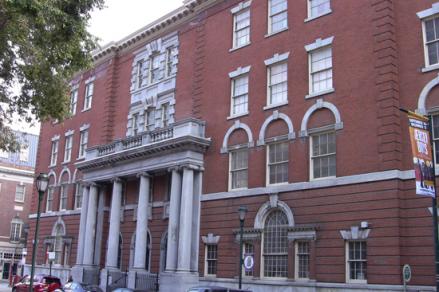
|
| Historical Society of Pennsylvania |
There was a time when the mission of the HSP (Historical Society of Pennsylvania) was clearly and proudly centered on the history of Philadelphia's old families. There generally comes a time in every family when its accumulation of stuff requires facing the fact that many possessions are too valuable to sell and too bulky to store. HSP in time became a place where families contributed these objects of memory and value, at least keeping them out of the hands of antique dealers when dusting and ensuring them became a burden. When many families entered into such a joint venture, the shared goals and experiences created a tradition over time which was reassuring to the donors. The famous lawyer Howard Lewis came to the board of HSP at a time when it was facing up to some of its own problems.
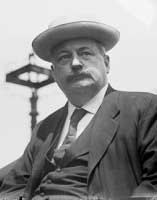
|
| Boies Penrose |
The then Board Chairman Boises Penrose came to the young lawyer one day and told him it was time he joined the board. Well, why? Because your grandfather was once Chairman of the Board; no other explanation was offered. Howard Lewis recounts that it was his introduction to a Philadelphia fact: some board appointments are hereditary. He dutifully joined.
It became apparent that HSP was a museum of immensely interesting artifacts, including decorations used at the Machianza of 1778, a copy of the handwritten originals of the Declaration of Independence and the Constitution, and ten thousand other curious of great interest. It was a place to visit one's family relics, it was a great place to hold a party. It had a three million dollar endowment in 1969. But it had a big problem: essentially no one visited the museum. It isn't hard to imagine the anguish waiting for anyone who stirred up the hornet's nest by pointing out the obvious problem. You can't fire hereditary directors, so hereditary directors don't budge in an argument. You can make hired staff into scapegoats and fire them; that doesn't accomplish much, although it is commonly tried. The Genealogy Society is a natural partner of Philadelphia's attic, but although the two partners were intimately mixed, natural partners who can't be fired add to the scene.
Things went on. Boies Penrose held board meetings which lasted precisely forty-five minutes. He had a train to Devon to catch at 5:15, so meetings ended at 4:45 PM, precisely. Even when a speaker was in mid-sentence, the gavel banged down at 4:45. Eventually this impasse was broken by reaching an agreement with the Atwater Kent Museum to the effect that historical three-dimensional objects would go to the Atwater Kent, freeing up 40% more library space for the two-dimensional papers, maps, and documents which were to become the main focus of the new HSP. More separation between HSP and the Genealogy Society was effected. Much of this was made possible by the extraordinary investment ability of Ralph Kynette, who had run the endowment up to $18 million, in spite of maintaining a spending rule of 9%. There are not many non-profit organizations which can match such a performance.
The reorganized HSP floundered a bit, and then it had the good fortune to enter into a merger with the Balch Institute. The Balch also had a store of valuable papers, but its main mission was educational. The addition of this educational effort to the more static museum and library functions has allowed the recruitment of ambitious staff, and a considerable redirection from Olde Philadelphia to the city as it now is.
In the course of the many reexaminations which all this reorganization stirred up, some familiar issues in non-profit administration had to be faced. The American Museum Association is firm in its principles that no asset in the archives of a museum may ever be sold, except to purchase some other asset which comes closer to the museum's stated mission. The underlying sense of this rule is plain: it would be unfortunate for paid staff to sell artwork for the purpose of sustaining or raising their own salaries. Unfortunately, in a great many instances, collection value has grown more rapidly than the size of the endowment to preserve the collection. That's about the size of the problem at the Barnes Museum, where collections worth many billions cannot be touched to raise money to protect and display them. It is confidently asserted that the Barnes has many objects in its basement which could easily correct its endowment imbalance, but the AMA rule prevents it. The Barnes must now be moved to a new county to overcome this impasse. It all seems like an awkward way to solve one problem by creating another, but the lawyer in Howard Lewis takes it in quite an unexpected direction.
It is his view that locking the museums of the nation in this position creates a constantly shrinking market in the artwork; when a museum acquires a piece of art it forces it to enter a one-way tunnel, never to reappear on the market. A constantly shrinking market of salable art raises prices, and it does so in a way that resembles a violation of the Clayton Antitrust Act, the beneficiaries of which are the art dealers, art collectors and artists of the world. Add to this injury to competition, the tax benefits of creating or holding a constantly appreciating market; and it really is an uncomfortable thing to consider in depth. The American Museum Association ought give serious consideration to finding alternative routes to its legitimate goals. One of the other probably unintentional results of this rule are that the donation of a valuable piece of art to a museum is very likely to lead to its instant sale for cash. The reasoning here is that the donation has not yet been "taken into the collection", and thus it can be sold without violating the Museum Association rule. People who wear wigs while sitting on a bench may consider this a valid interpretation, but when you set about trying to fashion a better museum rule, this rebuttal seems highly contrived.
If we should someday set about to re-examine what we are doing in the legal thicket of museums, we might consider how the principles of non-profit accounting for museums might be fundamentally modified. Since a non-profit is thought to generate no profits, its financial health cannot be measured by the size of its profits. Consequently, it is traditional to account for the finances of a non-profit by measuring whether its assets have grown or declined. However, conducting an annual appraisal of all the artwork in a museum that never sells anything is a monumental expense without any other purpose than to satisfy the accounting rule. Consequently, I'll tell you a little secret. Absolutely everyone ignores the issue, and the annual audits are totally uninformative if not misleading. Who's going to hang the bell on this cat?
Another Toast to S. Weir Mitchell
Proposed to the Annual Dinner of the Franklin Inn Club, 16 January 2009:
p>In the century after Benjamin Franklin, one of the most diversely creative Americans was S. Weir Mitchell. Like Franklin, he was an empirical scientist. But whereas Franklin went in the direction of homely philosophy, diplomacy, and urban institutions, Mitchell shot off into practical and theoretical medicine and was the first president of the American Neurological Association. He wrote several historical novels, some juvenile literature, and 440 pages of collected poems; as well as the penetrating case studies, essays, and books he contributed to medicine.
The year after Mitchell helped found The Franklin Inn Club, 1902, a painting of him was commissioned, by John Singer Sargent. The world’s leading social portraitist was 47; his subject was 74. Sargent fretted over the beard, and muttered, “I mustn’t make him look like a goat.†Mitchell’s thin, silvery beard nonetheless looks like an afterthought, brushed over his clothing. Mitchell’s left-hand rests awkwardly on a book standing vertically, index finger inserted, holding a place. His light blue eyes look watery and accusing as if from eyestrain combined with irritability at keeping still for this arrogant young Englishman. When the painter finished he exclaimed, “At least it is a Sargent.†To which the sitter replied, “Yes, and it is of S. Weir Mitchell.â€
Mitchell’s own fame dated from experience as a surgeon in the Civil War and a book on gunshot wounds, a classic still used by the French in World War I. If he was active today, editorial writers would be quoting Mitchell on whether or not post-traumatic stress disorder should qualify a warrior for the Purple Heart. He also generated monographs on rattlesnake poison, and on relations among nurses, physicians, and patients. Most famously, his “Rest Cure†for depressed patients was adopted in Europe, and some of its features remain in practice today in Japan and China.
We may see Weir Mitchell, then, as one of the great medical figures between the first surgical anesthesia and the eminence of Sigmund Freud. But where exactly fit him? Critics of the Rest Cure might say that he came to embody the title of a short story he wrote during the Civil War 'Autobiography of a Quack. It is easy to concede that he may have been a strange duck; but I should also insist that he was a pioneer in experimental physiology, studying carefully how things happen in the human body and mind.
That said, I wonder about the title of his classic book on the treatment of hysteria and neurasthenia, which went through eight editions before his death in 1914. Its title is Fat and Blood. Something seems wrong there. He believed that neuralgic conditions of all kinds were treatable by managing ratios between blood and fat. His theory figured centrally in the Rest Cure, which required four to eight weeks of seclusion, away from family and intellectual work, in the care of a nurse who bathed, dressed, and massaged the patient, while a doctor occasionally prescribed electricity and dietetics, and studied weight gain, which would be evidence of improvement. (This, after all, was the age of Lillian Russell, no slender beauty; and of William Howard Taft, who at peak weighed 335 pounds.) We may be allowed skepticism regarding features of Mitchell’s treatment: about seclusion, because we are ultra-sociable; about rest and no-use-of-hands, because our age is hyperactive; about massage, which we believe yields only a transient “feel-good†effect; about electricity, which we think useful only in careful shock doses; and about exotic pharmaceuticals such as the glycerin that Mitchell valued, which was specially extracted from bull’s testicles.
If we read the short story by Charlotte Perkins Gilman, The Yellow Wallpaper, we may get an even darker view of the Rest Cure. This utopian feminist and prolific writer suffered postpartum depression after her first daughter was born, and for it, she undertook Mitchell’s treatment. In her story, a secluded woman obsesses with the sickly color and creepy patterns of the wallpaper and imagines them hiding a woman who wants to get out. She goes mad and rips the paper off the wall to let the tortured prisoner free. In reality, Gilman ignored Mitchell’s advice against resuming intellectual activity, and flung herself back into it for the rewards of “joy and growth and service.â€
Perhaps Gilman’s reputation as a feminist contributes to Mitchell’s as a misogynist. But that charge I believe is wrong. He had many woman friends, and many female patients adored him '" all without scandal. He may have erred in treatment, but his very focus on conditions suffered by educated women was novel in his time. Women were subject to hysteria (which in male doctor language appeared to mean restless, bitchy women), and neurasthenia (which implied more docile, pleasing women). Both kinds might endure headaches, fatigue, anxiety, loss of appetite and motivation, and even suicidal thoughts. [Nowadays, simply “depression.â€] But then neurasthenia was taken as ordinary for women, meaning affluent urban women, and certainly not freed slave women. Men, of course, were also subject to such vapors, which they should treat with a stiff upper lip, or to ulcers and heart attacks, which Mitchell also wished to cure and prevent. These stress-produced conditions, as early as 1869, were traced to competitive capitalism. Americans were thought especially prone to neurasthenia, and when William James suffered it, he called it “Americanitis.â€
Weir Mitchell’s advance was to approach the condition experimentally and pragmatically. At that time, mental illness was associated with the madhouse. Instead, he considered it as common and treatable. His chief distorting error, surely, was an excess of empiricism, in trying to base every distress and its cure in bodily function. He nonetheless appreciated psychodynamics, and many anecdotes attest to his high appreciation for women and his sensitivity to them. His net contribution was major: Mitchell domesticated mental illness, so to speak, and laid some of the bases for modern psychosomatic medicine.
For an attentive physician and engaging conversationalist, I wish we could still find Weir Mitchell, a short distance west of our Inn at 1524 Walnut Street. To his office at home came numerous patients, who were admitted by a male servant in a red vest and swallowtail coat. It was an easy walk for Weir, of course, to come here to Camac Street, for the kind of conversations with J. William White and others that he cherished: unpredictable, wide-ranging, based on frontiers of knowledge; open to controversy, and hospitable to disagreement, far beyond the norms of Philadelphia society.
Although we cannot host our founder in fact, let us thank him warmly for starting up the Franklin Inn, and together toast his spirit: to S. Weir Mitchell!
Theodore Friend
Sources:
1. published: Ernest Earnest, S. Weir Mitchell, Novelist and Physician (Philadelphia, University of Pennsylvania Press, 1950)
2. web/Wikipedia/Google/ Google Images:
Charlotte Perkins Gilman
S. Weir Mitchell
Neurasthenia
Rest Cure
John Singer Sargent
Elaine Showalter (selections from The Female Malady)
www.collphyphil.org/WoodHistoricalLibrary/WeirMitchell
B. Franklin, Scientist
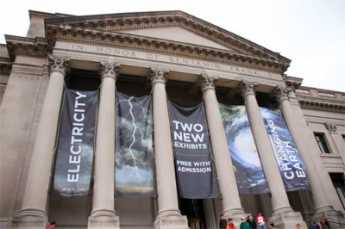
|
| Franklin Institute |
FROM time to time, the Franklin Institute has a display of its own and other museums' collections of the scientific instruments of Benjamin Franklin. It's well worth anybody's visit when it is available because the beauty and craftsmanship of these instruments alone make them remarkable works of art. Franklin was financially able to retire at the age of 42, and it tells you something of the 18th-century culture that Franklin took up scientific experiments in order to be like other independently wealthy gentlemen. Science, or natural philosophy, this seems to have been in a class with getting a coat of arms and having his portrait painted, all of which cheapens our view of Franklin as a scientist.
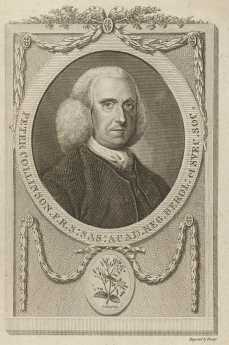
|
| Peter Collinson, F.R.S. |
In fact, Franklin was conducting an active correspondence with other scientists interested in electricity for many years, in particular, one Peter Collinson, F.R.S. in London. Collinson collected thirteen of Franklin's letters about his experiments, the earliest dated 1747, and printed them in 1751 as an 86-page book called Experiments and Observations about Electricity . By 1769, several more letters expanded the book to 150 pages, almost all of them describing reproducible experiments in great detail. The kite and key episode are described, but soberly and sparingly. Without making the point too graphically, an appendix was added describing how lightning had been used to kill some turkeys, so a somewhat increased power would probably be enough to kill a person. Franklin recognized that something was moving from here to there, that it had positive and negative charges, and that it was possible to store it up in a storage battery. He recognized the difference between substances that would conduct electricity and other substances that would act as insulators. Later on, he would discover that the torpedo fish stores and transmits electricity, suggesting that somehow animals made and used electricity as part of life. And of course, he put the discoveries to practical use as lightning rods, which he refused to patent.
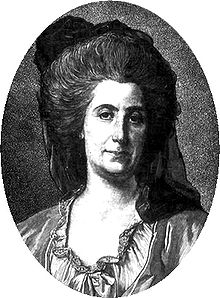
|
| Madame Helvetius |
By the time he went to England and France as a negotiator, his wide acquaintanceship in the scientific world was happy to introduce him to other famous people, like kings, Voltaire, Mozart, and Madame Helvetius the wife of the Swiss philosopher, the only woman to whom he is known to have made a proposal of marriage. When someone mentioned standing before a king, he replied he had stood before five of them. King Louis XVI, for example, appointed Franklin to a four-man committee to investigate hypnotism, then being touted as "animal magnetism" by Franz Mesmer. The other three committee members were unfortunately also destined to become acquainted with the guillotine: Brother Joseph-Ignace Guillotin himself, and two future victims of the invention, Antoine Lavoisier the discoverer of oxygen, and Jean Sylvain Bailly who first calculated the course of Halley's Comet, not to mention Louis XVI himself. It is not easy to think of any other scientist who was able to mix his scientific fame with changing international history, acquiring in the process the sobriquet of the founder of the American diplomatic corps. But then, he was witty as well as smart, and his career is a warning to those who now hope to devote their whole lives to being admitted to a prestige college and then coasting on its reputation. Franklin, it should be remembered, dropped out of school after the second grade.
Barringer Crater in Winslow AZ
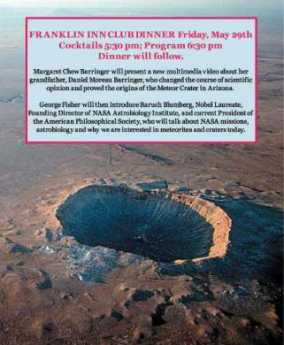
|
| Barringer Crater |
There are several big holes in the ground, clustered fairly close together in the high plains of northern Arizona. One of them is an extinct volcano, one is a sink-hole where the ground collapsed over an empty aquifer, one is the Grand Canyon. And one of them is the Barringer meteorite crater, about a mile wide and half a mile deep. In the summer, environmental temperatures above 105 degrees are fairly common, and as I have reason to know, the crater can be covered with two feet of snow in February. It's near the town of Winslow, and was called the Winslow crater in a popular song, Take it Easy by The Eagles of ten or more years ago, as well as being featured for the last fifteen minutes of a movie called Starman that is still reasonably exciting to watch.
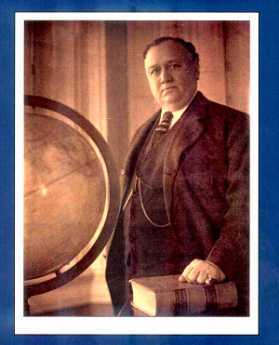
|
| Daniel Moreau Barringer (1860-1929) |
As recently explained by Margot Barringer at a dinner at the Franklin Inn Club last week, the crater was explored, and purchased, by her grandfather, Daniel Moreau Barringer (1860-1929), who had made a fortune in mining discoveries and could afford to buy a big hole in the ground. Daniel Barringer was a Princeton classmate and friend of Woodrow Wilson and Cyrus McCormick, as well as a friend of Theodore Roosevelt. Barringer's young son owned a .22 rifle and amused himself shooting at mud puddles. One day, he exclaimed that the shapes of the bullet holes in the ground were exactly like the shape of the Arizona hole; they all had a circular opening no matter what direction the bullet came from. From that came the idea that the crater was not an extinct volcano as many local natives believed, but the crater of a meteor, since the mouth of the crater would remain roughly circular regardless of the direction of the impact. That shape helps explain the confusion with the mouth of a volcano. While generally accepted today, meteor craters were a comparatively recent idea at that time. Geologists like to argue a lot -- Barringer himself was particularly vocal-- and it took quite a few years before the meteor theory of this particular crater was generally accepted. Poor Barringer became obsessed with the idea that commercial deposits of iron ore could be found if you dug deeply in or around the crater, but it wasn't true, and he essentially lost his fortune trying to dig 28 deep holes there. Sadly, he died of a heart attack very shortly after the scientific world finally agreed with his Theory of the crater's formation. The decline in the family fortune may also have been related to the significant year -- 1929 -- of his death. Two other granddaughters have written an interesting book about this personal and geological struggle.

|
| Baruch Blumberg |
At the Franklin Inn dinner, Baruch Blumberg (who had won a Nobel Prize for the discovery of the hepatitis B virus and its vaccine) then offered a fascinating discussion of meteors and craters. He's President of theAmerican Philosophical Society, but his credentials for this topic come from his second career as Director of the Astrobiology Institute of NASA. He tells us it might be better to call it an asteroid crater since most meteors are circulating asteroids that lose their way and come crashing through our atmosphere. There are quite a few asteroids floating around reasonably close nearby, and more big ones can be expected to drop in on us about once every two thousand years in the future. NASA seems to have given a lot of thought to this topic, including a theory that the moon was once a piece of the earth which got knocked loose by a big asteroid hitting us at some distant time in the past. There's a big crater in Siberia, and it is thought that dinosaurs were exterminated by a huge asteroid hitting the Yucatan. When you look at the surface of the moon, you see that lots and lots of asteroids have been flying about, but most of the evidence has been eroded away.
If there is a serious danger of another big one hitting us, and smart people can calculate its future path, what can we do about it? Well, the people at NASA have given that some serious thought. Attaching an outboard motor to the asteroid doesn't sound very workable, but painting one side of it white might be because white will reflect light and heat and push the asteroid in some different direction. And shooting big bombs at it to change its course might be practical. Right now, all of the asteroids seem to be headed in harmless directions, but it pays to be prepared.
The idea that iron and nickel could be found in the crater comes from knowing, Lord knows how that the center of the earth is molten iron. That creates the theory that asteroids might be mostly made of iron, burying commercial amounts of it underground when they hit. Unfortunately, the size calculations are all wrong, and Barringer's son had it about right that a .22 bullet would kick up a much larger hole than itself. Anyway, some consolation lies in 250,000 paying visitors to the crater every year, and an occasional movie or NASA experiment paying for temporary use. The downside of economics is that Barringer had eight children, and lots of them had lots of children. Fecundity seems to be a characteristic of most Barringers; one member of the clan estimated at least a thousand living relatives at one remove or another, all of them presumably willing to share in the gate receipts if some learned counsel advises an aggressive approach.
So, since it more or less belongs to Philadelphia, more visits to this crater are recommended. Except, perhaps, in February. April, when the desert is in bloom, might be more enjoyable.
REFERENCES
| A Grand Obsession: Daniel Moreau Barringer and His Crater: Nancy Southgate: ASIN: B0006SAYHU | Amazon |
Madeira Party 2009
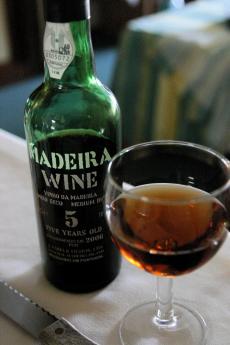
|
| Madeira Wine class= |
The hundred years war, the thirty years war, the seven years war, and other European disagreements made it difficult to import wine to England, turning the wine import trade to Portugal. Port wine was, of course, prominent, but the best wine of all came from the Portuguese colony of Madeira. The island of Madeira is closer to Africa than to Portugal, so the triangular slave trade made it easy to import Madeira wine to the British colonies in America. The eastern seaboard of America had no grape culture of any note, so the beverage trade centered on rum, whiskey, beer, and Madeira. George Washington is widely reported to have had half a bottle of Madeira every day for lunch, for example.

|
| S. Weir Mitchell. Mitchell |
The other evening at the Franklin Inn Club, a traditional Philadelphia Madeira party filled the hall, and the membership was brought up to date on some of the traditions and finer points of the occasion. In the first place, the Franklin Inn was founded by S. Weir Mitchell. Mitchell, in his spare time as Father of Neurology, had written a short story called The Madeira Party which worked in a large number of details about what was what about Madeira, ending with ribald tipsiness. Nathan Steven, a well-known wine authority, instructed the group in the various types of grape and vintage, and other members who have summered in Madeira related current conditions. Because the volcanic island is a favorite place for visitors, particularly Englishmen, real estate is at such a premium that most vineyards have only one or two acres of grapes. The wineries whose names are on the bottles pick up the crop from these local growers and take it on from there. This seems as good as any other explanation for the current high prices of the wine. However, a century ago a disease wiped out the French and Portuguese vineyards, who were forced to beg back some exported grapevines from California to get back in business. So, one wonders about the scarcity claim.
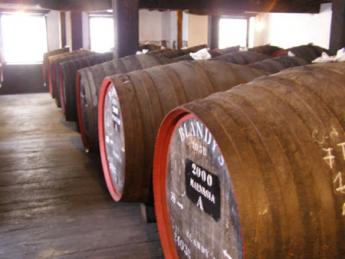
|
| Madeira in a barrels |
It is related that a number of cargoes of Madeira, particularly those of John Hancock of Boston were caught being smuggled to the colonies, and got returned. It was discovered that the taste of the wine was greatly improved by the tumult so that each vintner experimented with various methods of agitating and heating the wine to produce a particular brand. Madeira, like sherry, is a fortified wine, with various proportions of grain alcohol and brandy added in secret formulas. On one point there is general agreement, that if fortified wines are aged for long enough periods, eventually they all taste alike. There thus has emerged a tricky business of aging the wine long enough for the vintage of the wine to match the age or anniversary of the person being honored by the gift. Fifty years is the tricky goal; it's the most popular gift, but perilously close to the point where you can't tell if it is sherry or Madeira. There are four main varieties of Madeira (brand names are something else), getting progressively sweeter, darker colored and more expensive as they age. Malmsey, in a barrel of which Shakspere portrayed the royal princes being drowned, is claimed to be the very best. Some people regard it as too sweet, however. At proper Madeira party, each variety is served with a different course of terrapin or whatever. The President of the Franklin Inn read off the instructions for cooking the traditional first course of jellied boiled boar's head, and the guests agreed that modern tastes called for a substitute. After the reading of Mitchell's short story, the group added a new tradition of singing Flanders and Swann's ribald song, "Have Some Madeira, m'dear".
Chuck Barber, the current President of the Green Tree Insurance Company, added an entirely new historical slant. The Insurance Company is well known for having the best dinner in town at its meetings since directors of insurance companies don't do much. At the dinner in 1799, the news was brought in that George Washington had just died. A member rose to propose what has become an annual toast in Madeira, "To President Washington!" In time, S. Weir Mitchell became a member of the board, and the famous short story was the outcome which firmly fixed the rules of the Philadelphia Madeira Party. Bill Madeira was called on to verify this history, but he protested that his family name was derived from the wine, not the other way around.
It seems appropriate to add another historical note. Benjamin Franklin, after whom the club is named, suffered severely from gout. Although some sort of association with liquor had been mentioned as far back as Hippocrates, Franklin's powers of observation and his fame as a scientist placed him in a position to make it an irrefutable doctrine that gout was a medical penalty for drinking liquor. It was, of course, Madeira that old Ben was drinking, and it was the rule that Madeira was transported in lead-lined kegs. The Green Tree has some of the old kegs if you doubt it. Franklin's observation was acute, but what he was reporting was the effect of the lead poisoning, not of the wine.
Flanders & Swann
WWW.Philadelphia-Reflections.com/blog/1446.htm
The News of Ideas
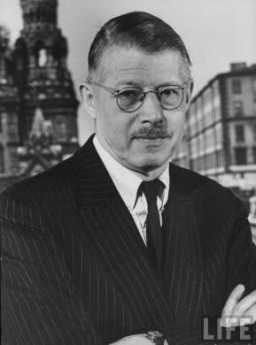
|
| Harrison Salisbury |
Children, if they read a newspaper at all, dive right into the comic pages. Retirees and other older people with time for reflection, go straight to the Op-Ed page. Although columnists and feature writers have occasionally appeared opposite the editorials in the past century, the Op(posite)-Ed(itorial) page as it now has become standardized in metropolitan newspapers, was started in the New York Times in 1970. The leaders of that paper had been wrangling and debating the issue for at least six years, so a great many people now take credit for it. The publisher, Punch Sulzberger, made the final decision to go ahead with it, and Harrison Salisbury as the first editor of the page had a lot to do with shaping it. The most vociferous advocate for the Op-Ed concept was John B. Oakes. The concept would never have succeeded without the enthusiasm of these three men. However, a lot of articulate people sit around the offices of the paper, and the concepts which eventually emerged had a lot to do with the opinions and indirect influence of Scotty Reston and Abe Rosenthal. What in the world was at stake that such a simple idea took so long to emerge?
 The Editorial page and the Op-Ed pages are the heart of a newspaper for senior citizens. 
|
Newspapers generally, and the Times in particular, make a great fuss about keeping the editorial and news departments independent of each other. The news department is supposed to report the facts fairly and without coloration by the writer's opinion. It might well be imagined that these well-informed articulate people are constantly itching to express their deeply held beliefs, and convince the world to change its views; that's forbidden. Things are carried to the point where the authors of news stories are not permitted to write their own headlines; sometimes the headlines and the content appear to conflict with each other. The underlying purpose of this isolation is to discourage advertisers from influencing the coverage of their topic. In small-town newspapers it is often true that the paper will not write a story about a business unless it is accompanied by the order for an ad; not so, at the Times. All the News That's Fit to Print, is their claim; all the news that fits, mutter their competitors.
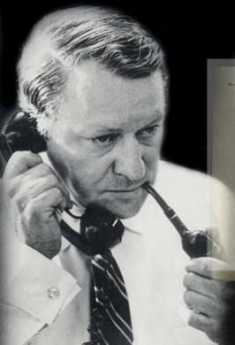
|
| James "Scotty" Reston |
The news department is told that opinions are expressed by the Editorial Department. Send them a memo if you want to get our opinion published, but keep it out of your news reports. The Editorial department is held to following the opinions of the newspaper owner in some papers; the Times asserts it excludes even the owner of the paper from its meetings of the editorial boards, This wrangle, some would say hypocrisy, influences a number of publications to a variable degree. Every editorial candidate is expected to demand that his contract include some reference to editorial autonomy, and is expected to resign in a public huff if the owner sticks his nose where it isn't welcome. In turn, the editor has control of hiring the subordinates and making assignments, prerogatives which the owner must not infringe. But it is clear that someone with expressed views repugnant to the owner is not going to get hired, and they all are careful to be well informed about the degree of the owner's interest in matters. For the most part, owners are too busy with other matters to pay much attention to the editorial slant, but they are certainly always at least to be regarded as sleeping tigers.
With this brief summary, it can be seen that both the news and the editorial departments are to some degree just aching to come right out and publish their unvarnished opinion, and from different angles are always under the constraint to tone it down. So, when the idea of an Op-Ed page comes up, both the news and the editorial groups want very much to control it. In this case, the editorial side won the argument, when Punch Sulzberger awarded it to them; and a number of representatives from the news side of the paper felt their enthusiasm cool. But the mission statement was created by Reston, who convinced people that what was sorely lacking in all newspapers was some discussion of the news of ideas. That's a compromise both sides could live with, and it also happened to be true. Up until that time, there was no established place for discussion of ideas.
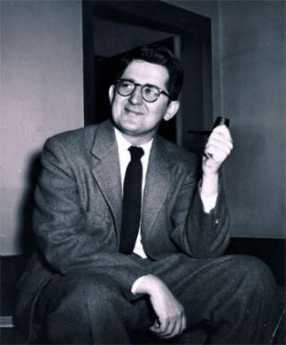
|
| Abe Rosenthal |
It would have to be admitted that the Wall Street Journal comes closer to fulfilling that mission than the paper which originated it. The reason can be surmised to originate in the hiring policies. As space in the paper becomes constrained by economics, the Times has tended to hang on to its full-time employees, or others who have long-term contracts. No matter how big your payroll or how large your staff, this tends to narrow the range of opinion. In fact, with constrained space but a large staff, it makes things worse. By either intent or financial necessity, other papers have sought out many more occasional opinions from stringers and specialists in the topic of the day. The Wall Street Journal has carried this idea farthest. They appear to hunt up Nobel Prize winners, Presidential cabinet members, corporation chairmen, prominent jurists, and others who would have to be acknowledged as experts in a particular topic. True, there are a couple of regular columnists, and it's also true that the Times is starting to tend in that direction. It would look as though Democrat administrations feed articles to the Times while Republican administrations try to use the voice of the Journal to announce their positions. And from time to time, the parties switch papers, in a bipartisan way, as the expression goes. But the Journal is going further, faster; they now print three pages of editorials, while the Times stays with two. Pages without ads cost money, but that makes them an ideal way to flaunt success with readers.
And back in the 1960s when all this was being debated, very little was expressed in just this way. At that time, the Times had the quaint custom of printing the obituaries opposite the editorials. The two battling contenders to present the news of ideas spent most of their time refusing to move the obits.
Pot Belly
In a love song written by T.S. Eliot, the character named J. Alfred Prufrock complains that as he grows old, he wears the bottom of his trousers rolled. College freshmen who encounter this line are apt to glide over it, uncomprehending, but the allusion will eventually grow clearer. The old man tends to find his legs have apparently grown shorter because he has to roll up his pants to keep them from dragging on the ground. Although the cartilages in his knees, hips and the lower spine may have compressed a little, the shortened legs are more apparent than real. The pants seem longer because his belt line has dropped. Dropped below his pot belly, that is.
No medical textbook that I know contains much discussion of pot bellies, even though they are almost universal, and universally noticed. The muscles of the belly wall relax, allowing the guts to bulge forward over the pubic bone.
 Even doctors don't know enough about this disorder of old age 
|
The aging lungs tend to enlarge, pushing the guts downward. The spine bends forward, and of course, the fat tends to increase inside the abdominal cavity. If there has not been too much weight gain, the pot belly tends to flatten out when its owner lies down on his back; if the weight has been gained, the pot sticks up like a pregnancy, obscuring the lower edge of the rib cage, bulging out at the sides. Normally, a young person's abdomen is described as "scaphoid" or hollowed out like the inside of a rowboat. A skinny young woman has wider flaring hip bones, exaggerating this scaphoid appearance, and making the waist narrower by allowing the guts to drop down into the larger pelvic cavity. Younger people are more active, with more muscle tone holding things together somewhat better.
Anyway, when the older person rolls over in bed, the innards of the belly cavity get squashed against the mattress. The old man's prostate leads to a fuller bladder, which means he gets up earlier when he rolls over it and gets up a lot earlier if he is overweight and has more pot belly. Or it may be the upper stomach that gets squashed, forcing the acid stomach contents up the esophagus and resulting in heartburn, burping, and even cough or hoarseness if the acid gets up into the throat and back down the windpipe. With weight gain, the pressure of lying prone can press against the main leg veins as they cross the brim of the pelvis, resulting in swollen ankles. Since the large intestines are coiled and kinked, external pressure against them causes a minor degree of obstruction which can be experienced as constipation or sometimes bowel urgency. Since the bowels contain a fair amount of gas, pressure on them causes small gas bubbles to merge into larger bubbles, with resulting flatulence which can reach startling proportions in the early morning hours. For all these reasons, people with pot bellies tend to sleep on their backs, causing a lot of snoring. If they snort and waken, they may have night time insomnia, daytime drowsiness. One sure sign of this is that the bed partner flees to a separate bedroom.
Victims of this affliction may, if they choose, imitate Scarlett O'Hara in that famous scene in Gone With the Wind with the slave girls pulling a tight corset even more painfully tight, but corsets are currently out of fashion. Or they can take purple pills to correct the heartburn, or regular laxatives for some of the other problems. In general, however, leg-lifting exercises strengthen the belly wall muscles (abs, I believe they are called), and losing weight by eating less does the rest. Losing weight is never easy, but in this case, a few pounds can make big differences in belly circumference, as measured by the belt size. Nothing will shrink the enlarged lungs pushing down, however, and arthritis of the spine may maintain the forward stoop. Very few older people are complete without some signs of this common affliction. Even so athletic a person as the ramrod-straight George Washington developed just a little pot. And Benjamin Franklin, of course, had a hopeless case.
Gazela Primeiro
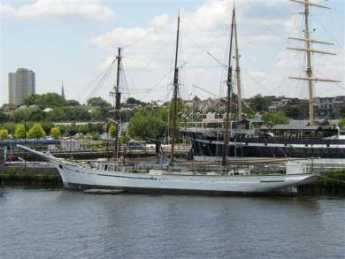
|
| The Gazela Primeiro |
The Portuguese sailing ship Gazelo Primeiro is parked at the foot of Market Street, where it can be reached by going down 45 steps of a winding staircase. It would be well to remember that you will have to climb 45 steps to get home if you go that way, and so there are attractions to parking your car on the lot which is right next to the ship. No one seems to be sure why it is the Primeiro, but the best guess is that there were several issues of this model, and this was the first. If you overlook the history of the ship largely carrying a cargo of dead fish in its commercial days, it's a beautiful tall ship, with a cheerful helpful crew.
The Franklin Inn Club held its 2009 annual summer picnic aboard, and everybody dressed suitably nautical, the food was good, the breeze was steady, and the weather generally outstanding.
Harvard Progressives in Philadelphia
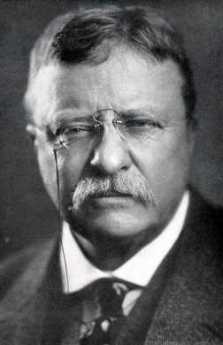
|
| Theodore Roosevelt |
The Progressive movement of the early 20th century is most concisely viewed as a futile social reaction to the vast changes in America caused by urbanization and industrialization after the Civil War. The transcontinental railroad threatened to destroy the wild, wild West, but the enduring environmental movement had overtones of even greater hostility toward industrialization, the cause of it all. In this sense, it joined forces with socialist and labor reform movements, in hating the newly rich, the spoilers, the Robber Barons. It briefly shared sympathies with anti-immigrant groups, while simultaneously expressing great sympathy with the decisions of the people, as opposed to corrupt politicians. There was a strong Calvinist streak in Progressivism, linked back to New England and Harvard its intellectual center. Regardless of any other contradiction, it reflected the viewpoint of Theodore Roosevelt. Teddy Roosevelt, "that damned cowboy" in the view of conservatives, did not invent the ideas of Progressivism, but he surely personified them, illustrated them in action. This confused turmoil of resentments was knocked off the front pages by a real threat to European civilization, the First World War. A terrifyingly well organized German war machine took the place of Robber Barons as a symbol of what was wrong with the world. The crash of 1929 and its ensuing long depression finally put an end to older controversies; it pushed the "reset" button.
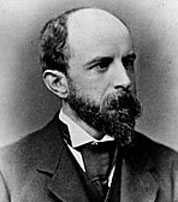
|
| Henry Brooks Adams |
To understand the position of Philadelphia's upper crust during the Progressive era, four or five names need to be fleshed out. Owen Wister and J. William White would be important Philadelphia links to the Bostonians Henry Adams and Henry James. All of them were leading literary figures, and all of them were close friends of Teddy Roosevelt. Roosevelt, it might be recalled, was the author of thirty-four books. This little group of literary giants were members of the leading families of Boston, New York, and Philadelphia; what they said, mattered. Although today Owen Wister is mainly known as the author of The Virginian, the first of the cowboy stories of the Wild West, he was, in fact, an observer of the social climates of not only the West, but the deep South (Lady Baltimore ), and the East Coast ( Romney). Some idea of his political leanings can be gleaned from his presidency of the Immigrant Restriction Society, and the authorship of an article called Shall We Let the Cuckoos Crowd Us From Our Nest . Wister has been called "the best born and bred of all modern writers", referring to his descent
Benjamin Franklin, Prophet
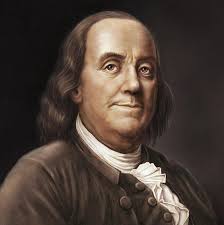
|
| Benjamin Franklin |
Judged by his public and private writings, Franklin was a deist. That is, he believed God sort of wound up the Universe like a clock, then let it run by itself. Furthermore, the Constitution0 which he had a hand in writing, pretty clearly maintains a wide separation between church and state. Nevertheless, historians by the droves have identified a uniquely American culture, apparently based on some fiercely held convictions. We might just as well say America has a secular religion with prophets, and Benjamin Franklin was an early prophet. His enduring message for all time was: Honesty is the best policy.
By this he did not mean, as lawyers do, strict word precision, or as our military academies add, resolute avoidance of half-truths and double-talk. Ol' Ben never admitted who the mother of his illegitimate son was, and positively chortled at hoodwinking the Pennsylvania Assembly into matching private contributions for the nation's first hospital, which he secretly knew he already had in hand. Late in life, he set enduring standards for the American diplomatic service, which some have defined as a profession dedicated to lying for your Country. Not only was Franklin rather sly, he gleefully projected the image of slyness. In recent years, some historians have proposed his adventures with many women were just acting out a playful pose. Frankly, this suggestion is hard to accept.
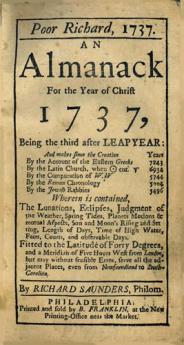
|
| Poor Richard Almanack |
The author of Poor Richard's Almanack, aged 26 at the first edition, was a young man totally consumed with advancing himself in the world; at that stage, he defined himself as a businessman. Like J. Pierpont Morgan, who could thunder "I will never do business with a man I don't trust", Franklin had one set of principles for business and another for love. Or, if you please, one set for men, and another for women, who were thought to play by their own set of rules. Historians have struggled with this paradox or hypocrisy, but it would have seemed strange even to comment on it in Franklin's era, and a conflict is not suggested in eighty volumes of his life writings. Lord Byron, another famous philanderer of the day, stated the matter delicately as "Man's love is to man's life a thing apart; 'this woman's whole existence." And that was just the way it was, in their view.
Franklin, who as an escaped apprentice might well have been punished like a felon in Boston, came to the big town to make his fortune, found himself ina culture of Quakers. Boston Puritans might well have punished him severely, or at least stood by approvingly while his brother beat the daylights out of him. The Dutch in New York were well known as rough customers; just to the south in Delaware, the inhabitants were to maintain a whipping post for two hundred more years. But in Philadelphia, non-violence was eventually carried to the extreme of confining miscreants to solitude until they spontaneously perceived it really was better to behave. Poor Richard's little motto about the best policy was in fact just the Golden Rule, applied to business. Even today, anyone starting a business soon finds a discouraging number of people ready to cheat the businessman; it was even truer in colonial America. Somehow, if you enter the business world, it is to be assumed you are ready to defend yourself. Competitors have little respect if you fail to conduct business warily; even less if you complain and wiper. Although many women have conducted successful businesses, it is so to speak a man's world. Little Benny Franklin, fresh off the boat from Boston, watched with amazement as Quaker merchants and vendors conducted trade on the assumption the counterparty was honest, refused to bargain an openly set price, and avoided violence when cheated. At the same time, Franklin could not fail to notice that Philadelphia was prospering much more rapidly than Boston. After a business trip to England, he could see that London worked at the same disadvantage as Boston. Honesty, it would appear, makes you rich; cheating may sometimes work, but fairness gets you ahead more steadily.
In later years, Franklin shared rooms with John Adams, who became positively livid at the suggestion a person should be honest for any other motive than to be taken into Heaven. It was degrading, even dishonest, to be honest in order to get rich. There is no evidence that Franklin's reaction to this sermon was anything but contempt for the other man's intelligence. Although probably not directly related to this exchange, Franklin's assessment of Adams was "always an honest man, often a wise one, but sometimes and in some things, absolutely out of his senses." Ben Franklin was born in Puritan Boston, fled from it as soon as he could, and thereafter seldom regarded Puritans as having two feet on the ground.
It thus emerges that Benjamin Franklin who was certainly no pacifist, greatly admired Quakers. On the one hand, in desperation he organized Pennsylvania's first militia when in 1730 the Quaker Pennsylvania government refused to act against French and Spanish marauders in Delaware Bay, and in 1752 took the lead again in assisting the British against Fort Deliquesce during the French and Indian War while Quakers resigned from government rather than defend the state. He even volunteered to go to London to lobby against the Penn family. None the less, Franklin was completely converted to Quaker principles of doing business, perceiving a deep underlying truth to them. Honesty, as suggested by the Golden Rule, or fair trade as they say in commerce, is the key to prosperity. Honesty is not just good advice for a young man, it is a principle which brings prosperity to a whole nation, while readily suggesting a clear simple explanation of why it should. Don't you want to be rich? Plenty of other people want to be rich.
Unfortunately, many kings, barons, confidence men, bullies, cheaters, and tough guys have also become rich. Generations of immigrants have come to our shores with the idea that life is a zero-sum game. The way to get money is to take it from someone else. The way to lose money is to give a sucker an even break. But gradually, one generation after another learns the truth, as enunciated by Poor Richard, that everybody is better off if almost everybody tries to be honest.
Surely it is not too much to say that American adventurism in the rest of the world reflects exasperation that the rest don't get the point. Certain parts of Europe, and all of the Mideast, really doubt it will work for them. The Far East does seem to grasp the rudiments, although with inscrutability and all it's hard to be certain. It isn't even true that all Americans get the point, but we have a containment policy for them, based on the fragile belief that here we outnumber the zero-summers. You must be firm, but you must also be fair. The crippled old Franklin hobbled out the door of Independence Hall after the Constitutional Convention. A woman calling to him asked what sort of government had been given us. "A republic," he answered. "If you can keep it."
The University City
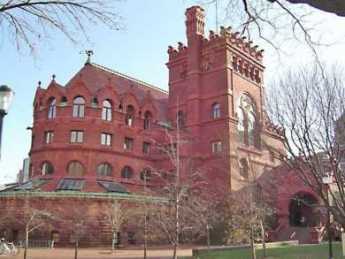
|
| University of Pennsylvania |
In 1920, the University of Pennsylvania graduated 34 students with B.A. degrees, and 134 with M.D. degrees. Today, the campus is a little self-contained city of 50,000 inhabitants. The transformation of the campus during that period is an outward expression of revolutionary expansion of the student body, involving demolitions, restorations, new construction. And the nearly constant shortage of parking space.
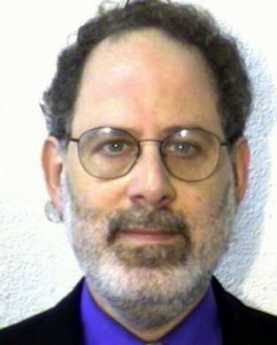
|
| David Hollenberg |
David Hollenberg, the University Architect, recently gave the Franklin Inn Club an interesting description of the University from the point of view of bricks and mortar. Since almost every building on the campus is undergoing or plans to undergo a major building project, he had a lot of material to cover. The disappearance of the railroad-based industrial area of West Philadelphia has been an economic problem for the city, but of course, this abundance of vacant land has created a major opportunity for the University of Pennsylvania. One reflection of this abundance is the opportunity to become the developer for much of the whole region around the campus, working with private developers who wish to be in the University area, and are therefore willing to coordinate their plans with those of the University. It's a remarkable opportunity. Since it comes at the time of a major economic downturn, one can only hope that the University does not impoverish itself taking advantage of this good luck.
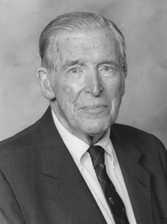
|
| Jonathan E. Rhoads |
As the graduation statistics illustrate, not so long ago the University was largely a medical school, with appendages. There are rumors of considerable friction from time to time, between the President of the University and the Dean of the Medical School as to who was boss; it is easy to imagine the trustees swinging from one side to the other. The most notable Provost of the University in modern times was Jonathan Rhoads, who also happened to be Professor of Surgery. If you know Quakers, you know that disputes were seldom rancorous. And if you know Jonathan, you know he almost always won the disputes.

|
| Cira Center |
While today, the dominant change is caused by the Cira Center buildings and the acquisition of the former Post Office building, it is well to keep in mind that the new Cancer Center is a billion-dollar project. A great deal of the medical school expansion is centered on burgeoning research, particularly in molecular biology, largely financed by the National Institutes of Health. While the leaders of the NIH have long struggled with Congress to keep politics out of both the administration and the substance of research, it seems to old-timers that the politicians are slowly winning. Senator Specter's seniority on the Appropriations Committee may have had as much to do with the prosperity of West Philadelphia, as the quality of research, however eminent. We are about to find out, and if things go hard with us in favor of say Chicago, it could be a wrenching experience. Most of those research buildings cost more to heat, air-condition, insure and clean than the entire tuition base of the students; and they wouldn't be good for much if you tried to sell them.
The University is almost unique in being located on contiguous land, near existing public transportation, and occupying substantial old structures capable of renovation to new purposes. Mr. Hollenberg was asked whether it was cheaper to grow like this within a city, or whether it is cheaper to plant a totally new university in several open corn fields, as we often see happen. While this is a hard question to answer, and depends to some extent on the type of architect in charge, it is his view that big-city restoration is a considerably cheaper way to expand than building from scratch on open land, although if you are starting the institution itself from scratch, there isn't much choice but the cornfield.
And then, there is the ancient argument between academics and bricks and mortar. Development officers agree that it is easier to raise donations when you can name a building for the donor; grand visions for new frontiers of teaching are a much harder sell. So a question does hang over this expansion, however exciting, whether the endowment will keep up with the structures, once the excitement of physical expansion dies down. These are definitely things to worry about, but right now you seize the opportunities as they go past, leaving integration to your successors to figure out.
------------------------------------------------------------------------------------------------------------------------Franklin Endorses the Constitution
Monday Sepr. 17, 1787. In Convention (6th and Chestnut, Philadelphia).
The Engrossed Constitution being read, Doctor. Franklin rose with a Speech in his hand, which he had reduced to writing for his own convenience, and which Mr. Wilson read in the words following:
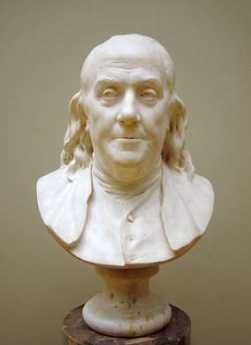
|
| Bust of Benjamin Franklin |
I confess that there are several parts of this constitution which I do not at present approve, but I am not sure I shall never approve them: For having lived long, I have experienced many instances of being obliged by better information or fuller consideration, to change opinions even on important subjects, which I once thought right, but found to be otherwise. It is therefore that the older I grow, then after I am to doubt my own judgment and to pay more respect to the judgment of others. Most men indeed as well as most sects in Religion, think themselves in possession of all truth, and that wherever others differ from them it is so far error. Steele, a Protestant in a Dedication tells the Pope, that the only difference between our Churches in their opinions of the certainty of their doctrines is, the Church of Rome is infallible and the Church of England is never in the wrong. But though many private persons think almost as highly of their own infallibility as of that of their sect, few express it so naturally as a certain French lady, who in a dispute with her sister, said, "I don't know how it happens, Sister, but I meet with nobody but myself, that's always in the right"- "Il n'y a que moi quia Toujours reason."
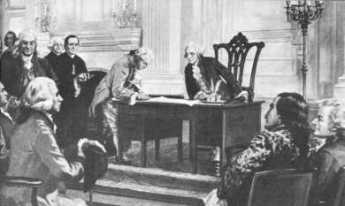
|
| The signing of the Constitution |
In these sentiments, Sir, I agree to this Constitution with all its faults, if they are such; because I think a general Government necessary for us, and there is no form of Government but what may be a blessing to the people if well administered, and believe farther that this is likely to be well administered for a course of years, and can only end in Despotism, as other forms have done before it, when the people shall become so corrupted as to need despotic Government, being incapable of any other. I doubt too whether any other Convention we can obtain may be able to make a better Constitution. For when you assemble a number of men to have the advantage of their joint wisdom, you inevitably assemble with those men, all their prejudices, their passions, their errors of opinion, their local interests, and their selfish views. From such an Assembly can a perfect production be expected? It, therefore, astonishes me, Sir, to find this system approaching so near to perfection as it does; and I think it will astonish our enemies, who are waiting with confidence to hear that our councils are confounded like those of the Builders of Babel; and that our States are on the point of separation, only to meet hereafter for the purpose of cutting one another's throats. Thus I consent, Sir, to this Constitution because I expect no better, and because I am not sure, that it is not the best. The opinions I have had of its error, I sacrifice to the public good--I have never whispered a syllable of them abroad-- Within these walls they were born, and here they shall die--If every one of us in returning to our Constituents were to report the objections he has had to it, and endeavor to gain partisans in support of them, we might prevent it is being generally received, and thereby lose all the salutary effects and great advantages resulting naturally in our favor among foreign Nations as well as among ourselves, from our real or apparent unanimity. Much of the strength and efficiency of any Government in procuring and securing happiness to the people, depends, on opinion, on the general opinion of the goodness of the Government, as well as of the wisdom and integrity of its Governors. I hope therefore that for our own sakes as a part of the people and for the sake of our posterity, we shall act heartily and unanimously in recommending this Constitution (if approved by Congress and confirmed by the Conventions) wherever our influence may extend, and turn our future thoughts and endeavors to the means of having it well administered.
On the whole, Sir, I cannot help expressing a wish that every member of the Convention who may still have objections to it, would with me, on this occasion doubt a little of his own infallibility--and to make manifest our unanimity, put his name to this instrument.
He then moved that the Constitution be signed.
When the last members were signing it, Doctor Franklin looking towards the President's Chair, at the back of which a rising sun happened to be painted, observed to a few members near him, that Painters had found it difficult to distinguish in their art a rising from a setting sun. I have, said he, often and often in the course of the Session, and the vicissitudes of my hopes and fears as to its issues, looked at that behind the President without being able to tell whether it was rising or setting: But now at length I have the happiness to know that it is a rising and not a setting Sun.
TOAST TO E. DIGBY BALTZELL (1915-1996)
A TOAST TO E. DIGBY BALTZELL (1915-1996)
The Franklin Inn Club, Philadelphia
Annual Dinner, 15 January 2010
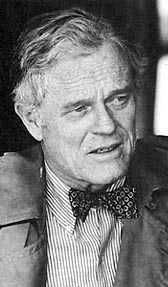
|
| E. Digby Baltzell |
I am grateful that our President, Deborah Goldstein, and the Board have given me this opportunity to make precedent -- tonight to strengthen the tradition of the Franklin Inn Club by raising a new toast, following our 18th century icon, Benjamin Franklin, and the 19th century men who founded the Inn, with a 20th century member. We are, after all well into the 21st century. It is my original privilege to honor a member and author who contributed strongly to American social thinking: E. Digby Baltzell.
Digby and WASPS Let me right away make two statements about Digby and WASPS. His name is associated with that acronym because it appeared in his book of 1964, THE PROTESTANT ESTABLISHMENT; ARISTOCRACY AND CASTE IN AMERICA. But contrary to a popular misconception, Digby did not invent the term WASP. I know, because a Jewish girlfriend from New York City used that term on me critically ("That's what we call people like you") in 1952. And there is good evidence that the term was in use as a put-down, like other American ethnoreligious slurs, two decades before Digby gave his term for White Anglo-Saxon Protestants scholarly standing in his book.
Secondly: however dear his idea was to him, Baltzell gave up on WASP aristocracy before his death. His subtitle had contained his aim: "Aristocracy and Caste in America." He was inspired by Tocqueville's attempt to save the French aristocracy from its own destruction by writing "Democracy in America" during the presidency of Andrew Jackson. Baltzell was concerned about his own aristocratic class. These were prep school and Ivy League educated people with family lineage, trust funds, and above all, what might be called Rooseveltian motivation. Either TR, Republican, or FDR, Democrat, party did not matter. Both Roosevelts had the aristocratic drive to excel: not only to lead but to assimilate other talents into leadership. That was the key to the matter: for a responsible aristocracy perpetuates itself by absorbing into ruling power new immigrant energy and multi-class talents, such as, in the 1930s, Fiorello LaGuardia, mayor of New York City, and Sidney Weinberg of Goldman Sachs.
An aristocracy is irresponsible, however, when it merely replicates its own ethnic and religious features. By protecting itself with clubbishness it ceases to be an aristocracy and rigidifies into a caste. Baltzell, 1964, feared that WASPS in the USA would let that happen, and wrote in the strong hope that they would not. But it was already happening. Looking back, we can see that the game was almost over.
Digby and Me Who was Digby Baltzell? He was born in Rittenhouse Square and grew up in Chestnut Hill to what he called an "impecuniously genteel" family. They sent him off to St. Paul's School in New Hampshire, an exclusive Episcopalian* boarding school formed in an English tradition. In his senior year, his alcoholic father was fired from his insurance company, and soon after died of a heart attack. For college, Digby could not afford Harvard, Yale, or Princeton, where all his classmates went but settled for the University of Pennsylvania. There he got himself through on scholarship, with various jobs such as ticket-taker, usher, and parking lot attendant at Franklin Field. He went on to get a Ph.D. at Columbia and came back to Penn, where he taught for the rest of his employed career.
I never met Digby personally because he died in 1996, the year that I joined the Inn. Yet I identify with the man I just described in some distinct ways. My own alcoholic father, a mellow, dear, and vulnerable man, lost his job as a stockbroker while I was in college. There, at Williams, I was a member of the same hard-drinking fraternity, St. Anthony Hall, as Baltzell had been at Penn. I'm not Episcopalian, but being a Scotch-Irish Presbyterian makes me categorically WASP. I feel like Digby did, that I have been a marginal member of the elite. I became an academic to try to figure out what the hell was going on around me. I have, like him, "an insider's heart and an outsider's mind." That has qualified me not to make a fortune, but to write books.
Digby and Us We all live in a time of social phenomena Digby never reckoned with -- of Bill Clinton as a white trash national leader; of John Kerry, a Catholic agnostic from St. Paul's School who lost the election of 2004 to G.W. Bush, a retrograde pseudo-Texan who had renounced his father's waspismo. Personalities that Baltzell might barely have imagined: Oprah Winfrey, a multicultural pop icon who is incidentally black; and the Afro-Saxon lawyer-intellectual whom we have chosen President of the United States, Barack Obama.
Baltzell finally gave up the attempt to invigorate his idea of a responsible ethnoreligious elite. He realized, and said, "what the Jews have done since World War II is the great untold story." And when he died he was preparing to undertake a book on the end of the Protestant establishment. He recognized that it had been replaced by a meritocracy based on professional performance, which, I think, is far more congruent to American social dynamics. I conclude that Baltzell's last and never completed project was an admission that his three books on the WASP establishment were a failed effort to firm up a transient power structure. I believe that Baltzell had been trying to implant in America a British notion of ruling class flavored with Tocquevillean nostalgia for a lost French aristocracy. Our nation has wholly different components from those, and he was bound to fail. Even as he struggled to make the point, he acknowledged the multi-cultural society around him, while expressing a vivid fear that multi-culturalism enshrined meant moral relativism, which would, in turn, mean an unworkable political system. On that last, he may yet prove correct. And he was surely astute in recognizing the importance in America of a professional meritocracy. If any of us, nonetheless, still yearns for an aristocracy of some kind, I would recommend Jefferson's idea of "a natural aristocracy based on talent and virtue."
Digby, although a connoisseur of clubs noted in the Social Register, never joined one, although often invited to do so. He criticized, among others, the Duquesne Club in Pittsburgh, the Links Club in New York, and the Philadelphia Club here for their obtuse and pointless exclusiveness.** But he chose to be a member of The Franklin Inn Club, and in his later years often came from home on Delancey Street to lunch among members. Our cultural, artistic, and literary atmosphere, we may dare feel, was comfortable for him. What he found here was perhaps an aristocracy without power, but a natural one in its components of talent and virtue. Sisters and brothers: let us toast Digby Baltzell -- an exemplar of our values, and an inspiration to us in the Twenty-First Century.
Theodore Friend
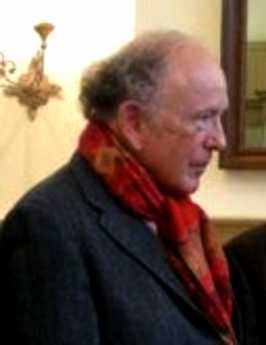
|
| Theodore Friend Sr. |
*To the rumor that Baltzell became a Roman Catholic before he died, a close living relative says no: he very much respected the Catholic Church, was interested in healing the breach with Episcopalians and may have attended some Catholic services. But nothing more.
**A Jewish friend, responding to my inquiries, tells me that he was admitted to The Union League in 1967, and about twenty years later became chair of the Admissions Committee. What percentage of members now are Jewish? He estimates five percent.
Sources:
Baltzell, THE PROTESTANT ESTABLISHMENT: ARISTOCRACY AND CASTE IN AMERICA , (1964)
PURITAN BOSTON AND QUAKER PHILADELPHIA, (1979)
THE PROTESTANT ESTABLISHMENT REVISITED, (1991)
Brief conversations with members of the Franklin Inn:
Daniel Hoffman, Nathan Sivin, and Arthur Solmssen.
Cushman Club for Lonesome Actresses
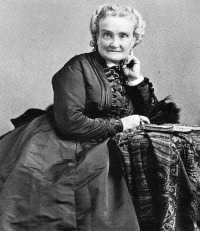 |
| Charolotte Cushman |
Lydia Ellicott Morris was married to another member of the Quaker colonial aristocracy, George Spencer Morris; both of them were active members of many organizations, including the Philadelphia Savings Fund Society, Friends Hospital, and several of the clubs on Camac Street. Their home for many years was located at 225 South Eighth Street. George Morris was a senior partner of Morris and Erskine, Architects. One day, Lydia was riding on a trolley car.
On the trolley, she overheard two young actresses fretting over the problem that traveling actresses were forced to live in hotels and boarding houses along with traveling salesmen. This circumstance forced them to experience much-unwanted attention and made being an actress a difficult occupation for respectable women. Lydia promptly got off the trolley and formed an organization raising funds to create in 1907 a boarding home to provide safe, respectable, inexpensive lodgings for actresses in traveling shows, playing in Philadelphia. It was named after Charlotte Cushman, the first internationally famous American actress, and located at 1010 Spruce Street. Charlotte Cushman had no connection with the club, but her fame can be appreciated from the fact that in 1874 after her final performance, 15,000 people were reported to have serenaded her outside of New York's Fifth Avenue Hotel. The Ninth Regimental Band played, while fireworks illuminated Madison Square. Ms. Cushman died in 1876.
Another major donor to the club was a Mr. Peterson, otherwise unidentified, who gave them $50,000. Further funds were raised at five annual teas. In 1925, Philadelphia was a major center for the film industry, and much Charlotte Cushman Club early history relates to movie associations. Much of the early endowment was unfortunately lost in the 1929 stock market crash, however, and the club continued only a subdued presence for a number of years. By 1999, it was clear that the original purpose was not really needed, and the club was disbanded. Its possessions, including the last of several clubhouses, the collections, and a rather valuable library, were sold off, and most of its other belongings were donated to the Franklin Inn Club. The club began a new existence as the Charlotte Cushman Foundation, first endowing the Charlotte Cushman Board Room and Exhibit, at the University of the Arts, and then in 2001 began making grants to local nonprofit theatre groups. At present, the Foundation dispenses an income of about $45,000 yearly among 43 non-profit theatrical societies which continue in Philadelphia. Present dominant activity is to select the Leading Actress in a Play, as part of the annual Barrymore Awards. The rise of the club reflected the vibrant downtown social life of Philadelphia at a time when almost all Philadelphians were residents of the center city. And its decline parallels the loss of civic-minded center city residents following the spread of household automobiles and the continuing wreckage of traditional civic feeling following the 1929 crash.
The Foundations's website is www.charlottecushmanfoundation.org, and its email address is CharlotteCushmanFoundation@gmail.com
Pipe Organs, and Similar
The Franklin Inn Club was pleased to hear a talk about pipe organs the other evening, by one of its members, Wesley Parrott. Wesley has degrees in the subject from the Curtis Institute and Eastman and was accompanied by Riyehee Hong, who has a Ph.D. degree on the subject from the Moore College. Wesley is now the organist at St. Mary's Church on Cathedral Avenue.
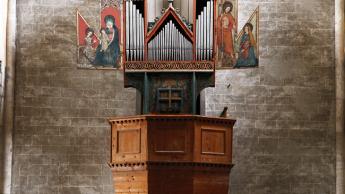
|
| l'Orge de Valere |
The flute is just about the oldest musical instrument if you regard a pipe organ to be essentially a large collection of flutes with a single mechanical air blower, controlled by a console. Bagpipes almost fit that description, too, except a bagpiper first fills the bag with air he blows in by himself, and fingers the holes in the pipes for individual notes, whereas the pipe organist has mechanical assistance to supply the air and control the pipes.
It seems to have been Emperor Charlemagne who decreed the pipe organ would contribute the main music of churches, and to fit this role, pipe organs in France and Italy evolved in the direction of elaborating the overtones and color characteristics of the organ as sort of a soloist in a church. Organs from this distant era are still playable but seem tiny in comparison with later examples. German music, in general, has always emphasized melody over elaborate overtones, and German organs evolved in the direction of distinctive notes in counterpoint. That has been true for centuries, but it was the missionary surgeon Albert Schweitzer who most recently made great steps away from French influences back toward melody and counterpoint, both in musical composition and in mechanical modifications of the instrument to suit that baroque goal. The mechanical underpinning of this distinction lies in the immediacy of response and shortening of tone decay, making the notes crisper. The older French version tends to smear the notes together, like a young person who talks too fast. The whole French language shares that characteristic of slurring words together, and speakers thus seem to be talking a little too fast to be understood. The German language is more staccato, with distinct separate words. In general, pipe organs tend to be either of the French or the German style, but there is a great deal of individual variation, resulting in subtle distinctions lost on most audiences. The design and construction of organs remained essentially unchanged from 1390 when l' Orge de Valere" was published by Guy Bovet, until 1876, when the great modern innovation of the electric organ was displayed in Philadelphia.
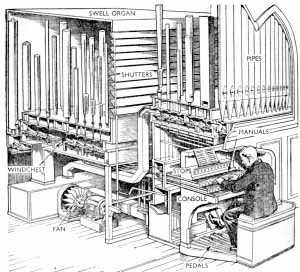
|
| Pipe Organ Sketch |
In fact, two modern changes were heavily American-influenced. The most important change in the mechanics after five hundred years was introduced at the 1876 Centennial Exposition in Philadelphia, by Hilborne L. Roosevelt, a cousin of Teddy, and son of S. Weir Roosevelt. The organ on display was the main organ of the main exposition building and created a sensation. Although he was only 37 years old when he died ten years later, Roosevelt became one of the largest organ manufacturers in America, a friend of Thomas Edison, and was recognized for a number of electrical inventions. Electrical control of the blower and valves greatly expanded the potential for size and complexity of the keyboard console. Up until that time, the keys were pounded with the organist's fists, and organists therefore somewhat resembled blacksmiths, both in musculature and temperament. The application of electricity greatly expanded the complexity and artistic potential of both the German and French styles. Meanwhile, the symphony orchestra was evolving throughout the 19th Century, and now the organ was able to imitate the whole orchestra. This evolution soon developed a mass market in the huge silent movie theaters of the early 20th Century, which in turn generated a pressure to evolve orchestra-like characteristics in the organs installed in the theaters, adding extra pipes and tones to suit that taste, which was exuberant. The advent of sound movies would soon eliminate the need for pipe organs in movie houses, but the instruments were durable and built into the walls. A few of them therefore still remain, largely unused, and probably unusable. The Philadelphia region is unusually rich in pipe organs of various sizes and complexity; students of the subject come here to tour them.
Philadelphia's Kimmel Center has a new pipe organ, with two consoles to suit the two main styles of organ music, solo of the Charlemagne sort, and orchestral music. Wesley feels too much emphasis was placed on maximizing the seating capacity of the Kimmel auditorium, causing the organ to be fitted into a narrow tunnel-like enclosure. The resulting sound of the organ has a uni-directional quality which is unrelated to the organ itself; some people criticize the overall result as "assaulting" the audience, but whether for better or worse the Kimmel Center distinctively has a Kimmel sound.
The electronic organ, as distinguished from the electric organ, doesn't use pipes, it synthesizes sound. It is far cheaper to manufacture, but is undergoing such rapid change in so many directions nowadays that it resembles the home computer; you have to go to the expense of getting a new one every few years. The electronic organ is clearly catching up with the range and quality of pipe organs but has not yet reached parity except in specialized situations. But its rapid and relatively inexpensive adaptability gives it a great advantage when musical tastes are changing. Modern music places much more emphasis on percussion, and modern society is much less attracted to great big hollow churches. Electronic organs thus change direction faster than multimillion dollar organs of the traditional sort, and slowly, slowly, the quality is catching up, too.
Lumpers In Constant Combat With Splitters
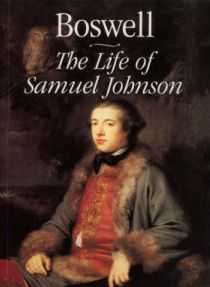
|
| James Boswell's Book |
Some colleges produce managers by teaching management theory, but in certain Ivy League colleges it is thought to be more useful to teach how to dominate a committee, eventually perhaps a board of directors, or a board of trustees. The handbook of instruction is James Boswell's Life of Johnson which is a rather large book of verbatim notes that Boswell took of his many lunches at a London club in the 18th Century. Boswell was a quiet mouse privileged to sit in the company of the great Dr. Samuel Johnson, surrounded by the most eminent intellects of the Enlightenment. Boswell carefully manages the background of each episode, describing the issue and the various arguments, and then -- Sam Johnson's booming voice settles the matter. After he speaks, the meeting is over.
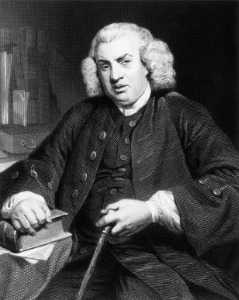
|
| Dr. Samuel Johnson |
"Why, sir", says Johnson, and then look out for the one-liner to follow. We get the impression that Dr. Johnson used that "Sir" signal to indicate he had enough of these dumb arguments, and soon would come the growled epigram that scatters any token resistance. Boswell may have neglected to record instances where the great Johnson was defeated in debate, who knows. We are left with the distinct impression that if you engaged in lunch table conversation with Sam, you were almost certain to lose. So that's what Ivy League students are being taught: how to win a debate at a committee meeting, in the expectation they would spend much of their lives in committees, boards, and even cabinets. That's how the English-speaking world gets its work done and its decisions made. That's what lunches at the Franklin Inn Club, or the club tables of the Union League, are trying to do for the education of neophytes.
As the goggle-eyed student of the great Chauncey Tinker, who gave young Pottle his start in life, it was an awesome performance for me to watch. But the rules of this game never became entirely clear to me, I'm afraid, until the other evening when I listened to Peter Nowell describe in a half-dozen brief paragraphs how he had revolutionized prevailing theories of the cause of cancer. The Franklin Institute then followed the award ceremony by putting on an all-day symposium of notables who run elaborate enterprises in cancer research, essentially funded by the National Institutes of Health, your tax dollars at work again. Last year, the NIH dispensed thirty billion -- you heard me -- dollars in research grants to internationally known research entrepreneurs, and if you can stay awake during their talks, there must be something the matter with you. So far as I could see, they were painstakingly describing every grain of sand on the beach, whereas Peter Nowell made the whole beach electric and clear in ten minutes. Essentially, he was saying that each patient's cancer is caused by a long chain of events, starting with a single mutation within a single cell. All the other cancer cells of a patient are descendants of that first one, which triggered the cascade of chemical events now repeated by the descendants. To stop the process, you probably only have to find a way to break the chain at one vulnerable point. Then you have a cure, without necessarily understanding every other link in the chain.
Peter Nowell described himself as a "lumper", admitting that most scientists are "splitters". A splitter quite reasonably attacks a complex problem by isolating one small piece of it at a time; that's really a pretty good way to address overwhelming complexity when you encounter it. But you can be sure that people of that mindset should not be found in a President's cabinet, deciding how to save the world from impending disaster. Whether by their own genetic predisposition or as a result of peer pressure in their profession, they are habitual splitters. And it suddenly occurred to me why Sam Johnson's one-liners always won the argument; he was a lumper. Usually right, sometimes wrong, never in doubt. Witty as a Frenchman, but as quick as a rattlesnake. Cordial, perhaps, unless you disagreed with him.
We need more lumpers. If they get that way from the likes of Chauncey Tinker, we need to print more copies of The Life of Johnson. If they are born that way, maybe we need a breeding farm for lumpers, which is what the Assembly Ball amounts to. But don't get me wrong, we need more splitters, too. They just have to learn their place at the table.
Reservoir on Reservoir Drive
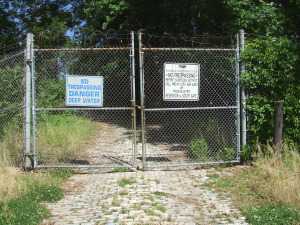
William Penn planned to put his mansion on top of Faire Mount, where the Art Museum now stands. By 1880, long after Penn decided to build Pennsbury Mansion elsewhere, city growth outran the capacity of the new reservoir system which had then been placed on Fairmount. An additional set of storage reservoirs were placed on another hill across East River (Kelly) Drive, behind Robert Morris' showplace mansion now called Lemon Hill (Morris merely called it The Hill); the area was eventually named the East Park Reservoir. In time, trees grew up along the ridge and houses got built; the existence of these reservoirs right in the city was easily forgotten, even though the towers of center city are now plainly visible from them. These particular reservoirs were never used for water purification; that's done in four other locations around town, and the purified water is piped underground to Lemon Hill, for last-minute storage; gravity pushes it through the city pipes as needed.

Now, here's the first surprise. Water use in Philadelphia has markedly declined in the past century. That's because the major water use was by heavy industry, not individual residences, so one outward sign of the switch from a 19th Century industrial economy to a service economy is -- empty old reservoirs. Only one-quarter of the reservoir capacity is in active use, protected by a rubber covering and fed by underground pipes. The rest of the sections of the reservoir are filled by rain and snow, but gradually silting up from the bottom, marshy at the edges. Unplanted trees have grown up in a jungle of second-growth, attracting vast numbers of migratory birds traveling down the Atlantic flyway. Although there are only a hundred acres of water surface here, the dense vegetation closes in around the visitor, giving the impression of limitless wilderness, except for the center city towers peeping through gaps in the forest. It's fenced in and quiet except for the birds. For a few lucky visitors, it's easy to get a feeling for how it must have looked to William Penn, three hundred or more years ago, and Robert Morris, two hundred years ago. In another sense, it demarcates the peak of Philadelphia's industrial age, from 1880 to 1940, because that kind of industrialization uses a lot of water.
The place, in May, is alive with Baltimore Orioles. Or at least their songs fill the air and experienced bird watchers know they are there. Even a beginner can recognize the red-winged blackbirds, flickers, robins, and wrens (they like to nest in lamp posts). The hawks nesting on the windowsills of Logan Circle suddenly makes a lot more sense, because that isn't very far away. In January, flocks of ducks and geese swoop in on the water surface, which by spillways is kept eight feet deep for their favorite food. Just how the fish got there is unclear, perhaps birds of some sort carried them in. The neighborhoods nearby are teeming with little boys who would love to catch those fish, but it's fenced and guarded much more vigorously since 9-11. In fact, you have to sign a formal document in order to be admitted; it says "Witnesseth" in big letters. Lawyers are well known for being timid souls, imagining hobgoblins behind every tree. However, there are some little reminders that evil isn't too far away. Just about once a week, someone shoots a gun into the air in the nearby city. It goes up and then comes down at random, with approximately the same downward velocity when it lands as when it left the muzzle upward. That is, it puts a hole in the rubber canopy over the active reservoir, which then has to be repaired. No doubt, if it hit your head it would leave the same hole. So, sign the document, and bring an umbrella if the odds worry you.
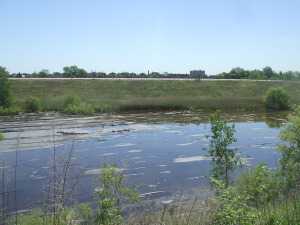
A treasure like this just isn't going to remain as it is, where it is. It's hard to know whether to be most fearful of bootleggers, apartment builders or city councilmen, but somebody is going to do something destructive to our unique treasure, possibly discovering oil shale beneath it for example, unless imaginative civil society takes charge. At present, the great white hope rests with a consortium of Outward Bound and Audubon Pennsylvania, who have an ingenious plan to put up education and administrative center right at the fence, where the city meets the wilderness. That should restrict public entrance to the nature preserve, but allow full views of its interior. Who knows, perhaps urban migration will bring about a rehabilitation of what was once a very elegant residential neighborhood. And push away some of those reckless shooters who now delight in potting at the overhead birds.

This whole topic of waterworks and reservoirs brings up what seems like a Wall Street mystery. Few people seem to grasp the idea, but Philadelphia is the very center of a very large industry of waterworks companies. The tale is told that the yellow fever epidemics around 1800 were the instigation for the first and finest municipal waterworks in the world. There's a very fine exhibit of this remarkable history in the old waterworks beside the Art Museum. But that's a municipal water service; why do we have private equity firms, water conglomerates, hedge funds for water industries, and other concentrations of distinctly private enterprise in the water? One hypothesis offered by a private equity partner was that the success of the municipal water works of Philadelphia stimulated many surrounding suburbs to do the same thing; it was surely better than digging your own well. This concentration of small and fairly inefficient waterworks around the suburban ring of this city might well have created an opportunity for conglomerates to amalgamate them at lower consumer cost. Anyway, it seems to be true that if you want to visit the headquarters of the largest waterworks company in the world, you go about seven miles from city hall and look around a nearby shopping center. If you are looking for the world's acknowledged expert in rivers, you go to the Academy of Natural Sciences of Philadelphia on Logan Square and look around for a lady who is 104 years old. And if you have a light you are trying to hide under a barrel, come to Philadelphia.
Original Intent and the Miranda Decision
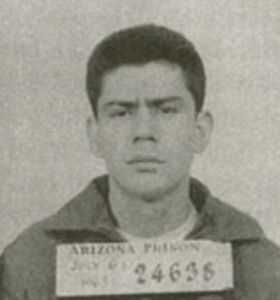
|
| Ernesto Arturo Miranda |
At the lunch table of the Franklin Inn Club recently, the Monday Morning Quarterbacks listened to a debate about Guantanamo Bay, prisoner torture and police brutality; all of which centered on the Supreme Court decision known as Miranda v Arizona. Ernesto Arturo Miranda was convicted without being warned of his right to remain silent, sentenced to 20 to 30 years in prison in 1966. Eventually, the U.S. Supreme Court, with Chief Justice Earl Warren writing a 5-4 decision, overturned the conviction, because Miranda had not been officially warned of his right to remain silent. The case was retried and Miranda was convicted and imprisoned on the basis of other evidence that included no confession.
An important fact about this case was that Congress soon wrote legislation making the reading of "Miranda Rights" unnecessary, but the Supreme Court then declared in the Dickerson case that Congress had no right to overturn a Constitutional right. Some of the subsequent fury about the Miranda case concerned the legal box it came in, with empowering the Supreme Court to create a new right that is not found in the written Constitution. Worse still, declaring it was not even subject to any other challenge by the other branches of government. In the view of some, this was a judicial power grab in a class with Marbury v Madison.
Several lawyers were at the lunch table on Camac Street, seemingly in agreement that Miranda was a good thing because the core of it was not to forbid unwarned interrogation, but rather a desirable refinement of court procedure to prohibit the introduction of such evidence into a trial. The lawyers pointed out the majority of criminal cases simply skirt this sort of evidence, use other sorts of evidence, and the criminals are routinely sent or not sent to jail without much influence from the Miranda issue. Indeed, Miranda himself was subsequently imprisoned on the basis of evidence which excluded his confession. What's all the fuss about?
And then, the agitated non-lawyers at the lunch table proceeded to display how deeper issues have overtaken this little rule of procedure. This Miranda principle prevents police brutality. Answer: It does not; it only prevents the use of testimony obtained by brutality from being introduced at trial. Secondly, Miranda contains an exception for issues of immediate public safety. Answer: What difference does that make, as long as the authorities refrain from using the confession in court? The chances are good that a person visibly endangering public safety is going to be punished without a confession. Further, the detailed procedures within Miranda encourage fugitives to discard evidence before they are officially arrested in a prescribed way. Answer: If the police officer sees guns or illicit drugs being thrown on the ground, do you think he needs a confession? Well, what about Guantanamo Bay? Answer: What about it? We understand the prisoners are there mainly to obtain information about the conspiracy abroad and to keep them from rejoining it. The alternative would likely be their execution, either by our capturing troops or by vengeful co-conspirators they had incriminated.
Somehow, this cross-fire seemed unsatisfying. The Miranda decision was made by a 5-4 majority, meaning a switch of a single vote would have reversed the outcome. The private discussions of the justices are secret, but it seems likely that some Justices were swayed by this edict viewed as a simple improvement in court procedure rather than a constitutional upheaval; Justices with that viewpoint feel they know the original intent and approve of it. Others are apprehensive the decision has already migrated from the original intent, in an alarming way. Everyone who watches much crime television and even many police officials feels that Miranda intends for all suspects to be tried on the basis of total isolation from interrogation from start to finish. More reasoned observers are alarmed that the process of discrediting all interrogation will lead to an ongoing disregard of the opinion of lawyers about court procedure, essentially the process of allowing public misunderstanding to overturn legal standards. Chief Justice William Renquist, no less, poured gasoline on this anxiety by declaring that Miranda has "become part of our culture".
What seems to be on display is the mechanism by which Constitutional interpretation drifts from the original intent. Not so much a matter of "Judicial Activism" which is "legislating from the bench", it is becoming a matter of non-lawyers confusing and stirring up the crowds until the Justices simply give up the argument. Drift is one thing; virtual bonfires and virtual torch-light parades are quite another.
Selection of Constitutional Rights for the Bill of Rights
When the First Congress convened in 1789, it confronted more than a hundred proposed amendments to the Constitution, largely stirred up by supporters of Thomas Jefferson who feared any strong government would be too similar to the monarchy we had just discarded. Essentially, Congress dumped these noisy dissatisfactions into the lap of James Madison who had largely constructed the Constitution, constituting a committee with Madison as its chairman. The first ten amendments emerged together as a package, enabling trade-offs and compromises; all subsequent amendments have been taken up individually, one by one. Since members of the First Congress and the Constitutional Convention were largely the same people, much of the durability of the Constitution can be traced to them. And therefore, the tendency of the nation to feel its way into a new idea, sometimes retreating, sometimes plunging ahead, has migrated into the Supreme Court. This result was probably accidental, but nevertheless, the power of the Supreme Court was greatly strengthened by default; it alone can tip-toe out of a Constitutional tangle created by momentary impulses.
After winnowing out duplicates and half-baked ideas, Madison's committee condensed the wildly disparate proposals into ten amendments, supposedly limited to ten by alluding to Ten Commandments which were sufficient for Moses. Three main principles emerged. The Constitution should be parsimonious in granting divine, or natural, rights because what Nature's God had granted was hard to tell but what the judiciary could enforce had limits. But thirdly, granting even these few self-evident rights to slaves might tear the Union apart.
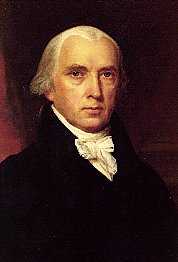
|
| James Madison |
So Madison's committee narrowed the legally enforceable human rights to a handful, selecting only those so self-evident they could withstand the tensions of enforcing them. When contemplating the problem of extending mandated rights to slaves, however, there was no obvious solution at all. That made it easier to limit the Federal Government to enforce a handful of enumerated powers, leaving all unspecified matters to the state legislatures to enforce if they could. The boundary might shift with time, but without saying so, the Bill of Rights kept the Union out of the one main foreseeable problem, of slavery. The unmentioned conflict between universal rights and slavery defaulted to the individual states, or to whomever, but definitely not to the Federal Government.
That tap-dance held together for nearly a century, and then it didn't and we had a Civil War. During all that time, the balance of power was steadily shifting from the confederated states to the centralized federal government, and after the Civil War, it shifted still more. However, the southern confederation may have been defeated, but it was not exactly reconciled, nor were the former slaves exactly equalized. Their current drift toward entitled dependency was particularly unexpected.
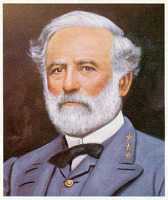
|
| Robert E. Lee |
Many post-war expedients were tested to heal these wounds, some of them useful and some, like forcible Reconstruction, disruptive. Two expedients opened new wounds and distracted the country for a century. The first was the intentional weakening of the quality and effectiveness of state governments, to the point where it can now be asserted that state government is the weakest part of our whole government structure. Those who prized universality and efficiency, or who sought greater international power, regarded state legislatures as a hindrance; just look who got us into a Civil War. Consequently, corruption and ineffectiveness were privately tolerated in state legislatures, because discrediting state governments made them easier to ignore. Repairing the resulting imbalance in our overall system is now growing to be one of our greatest problems. Almost no one remembers this was the price of a ratified Constitution, so increasingly that excuse is futile. In fact, in the thirty-seven more recent states to be admitted to the Union, it is not even accurate.
The second response to a sluggish equalization of racial rights was invented by Madison himself. He felt that the ability to migrate from one state to another would discipline any temptation of a state to misbehave. If your state taxes you unfairly, move. If your state government gets too corrupt, first try to throw the rascals out, but in the last extremity, go somewhere else. This concept has worked magnificently in maintaining national interest rates with appropriate local modifications, and we are about to learn whether it will adequately restrain the half dozen states who have pushed the limits of taxes and borrowing. In the case of former slaves, massive out-migration took a century to happen and then it happened all at once, just after World War II. Wave after wave of slave descendants from the rural South got on buses and came to the heart of Northern cities. Overwhelming the ability of weakened local governments to cope, city institutions disintegrated, particularly the public school and justice systems. The consequence is continuing disarray in Washington DC, Baltimore, Detroit -- and Philadelphia -- together with a host of smaller cities like Reading, Newark, Paterson, Wilkes-Barre, and many others, in all of which the unsustainable wave of immigrants added to local industrial and civic problems which had other causes. So now we have two new problems, weakened state government and disruptive migrations, which in other circumstances tended to mitigate each other, but now increasingly make each other worse. Someone must take hold of the issue that applying Madison's concept of competitive states has created a strong state disincentive to deal with poverty.
It took a century for Madison's scheme to break down into war, and Lyndon Johnson was surely quite right to feel a century was long enough to tolerate the disunity of the Civil War. If he could not make people love one another, at least he could enforce the law. State governments were not doing it, so he whipped the Congress into taking it on as a Federal duty, by passing the Civil Rights Act. Half a century has passed with some progress, but surely not an end to the disunity. State governments have been further weakened, but mass migrations have calmed down. In another half century, the slavery issue and its consequences may fully subside. Meanwhile, the reaction of extending federal power continues, now threatening to extend to the medical profession, the finance industry, the automobile industry, and the Internet. Our Constitution continues to survive more or less intact into its third century, and we grow increasingly wary of tinkering with it as we watch most other nations fail to achieve its essential quality. Which is, it survives. Aside from the Bill of Rights and some technical tweaks, there have only been five amendments of any substance. Meanwhile, new federal statutes and regulations grow by a hundred ponderous volumes a year.
RR Monopoly Self-Destructs
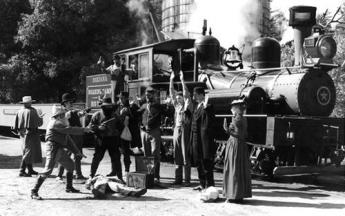
|
| Train Robbery |
A strange part of capitalism is that no company seems to last forever; seventy-five years is a long life for corporations. For this puzzle, partial insight emerges from American railroad history. After overcoming their novelty and growth pains, railroads soon had to confront the accusation their great size was itself a problem, unbalancing the playing field. Too big? Management resists that argument. Getting bigger was always good, especially when dealing with foreign competitors. A vital public treasure? Needing railroads doesn't create ownership rights, building them does. Railroad founders discovered a public need and served it; but the public replied it was their need and so it was their railroad, only temporarily in the hands of managers. Nothing useful was going to come of this faux debate, which structured itself in the 19th Century to reach equilibrium, not agreement. There is some reason to hope the ending of the Cold War a century later may have established more permanent understandings, but even those remain hostage to future history. By 1970 history seemed to be making quite the opposite verdict; at least eight major Northeastern railroads collapsed into helpless bankruptcy. Management blamed the senseless labor union work rules. The unions blamed incompetent management. As is usually the case, there's one lesson here for investors and quite a different one for reformers. All of the debaters need to reflect that possibly the collapse of the railroads was caused by attempting to create institutions which were bigger than they would need to be, fifty years later. Unless a way is provided for them to shrink, some form of shark will eventually eat them alive.
I am greatly indebted to a senior partner of one of Philadelphia's great law firms for insight into the decline of the railroad industry in Philadelphia, which took place during thirteen years of his active law practice on behalf of one of the bankrupt railroads. The insights are his, the opinions are mine.
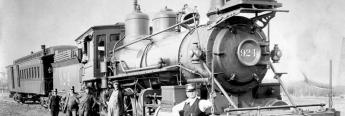
|
| Interstate Commerce Commission Act of 1887 |
A railroad is inherently a monopoly. At first, that isn't obvious, as the railroads snake around to service potential customers. But it soon becomes apparent that it is generally easier to move a factory to an established rail head than to move an established railroad to the factory. Customers who doubt this soon find themselves less competitive than the competitors who recognize facts and respond to them. The location of rivers and raw materials make a difference, quite often enough to move the railroad; but when the railroad moves, it is only a matter of time before the mighty factory has to consider doing the same. That process tends to force everybody to greater efficiency, but it inconveniences many people, who appeal to their unions, who appeal to their politicians. This is a short summary of the origins of the Interstate Commerce Commission Act of 1887, which set the pattern for most later regulation of interstate commerce. The ICC Act, regulating and constraining the activities of railroads, was made law only a decade or so after the transcontinental railroads came into being. Since this had previously been an era of notoriously brutal clashes between the Reading Railroad and the Mollie Maguires, the entire regulatory process has been conducted like a cartoon of that remorseless struggle between one particularly fabled Irish Railroad President and one equally fabled Irish Railroad Union of song and story. The ultimately tragic end of the railroads was declared official by the Railroad Reorganization Act of 1973, which consolidated the freight business into a government-owned company called Conrail. For thirty years before the final demise, just about every president of just about every railroad -- was a lawyer. Others could run the engineering and the finance; in this business, survival itself depended on relations with government.
This description, while accurate in a way, misses a central point: what happens to an industry which was regulated and unionized as a monopoly -- when it develops competition and is no longer a monopoly? It badly needs to downsize, to reduce the overhead which comes from overcapacity, but the unions resist. Unless a way to reduce costs can be found, the company has put its foot on the down-escalator. The stock-market price declines as the profits erode, so borrowing becomes more expensive; the bond markets will sit in judgment on the outcome. A desperate management turns to technology and automation to improve productivity enough to compensate for the bulging overhead; but when improved technology makes even more employees redundant, the union balks and the increasingly obsolete regulations assist them. Competition from the highways and airlines is not going to relent, the unions feel they cannot or need not compromise, and sometimes will not permit productivity improvements. To the extent a company in that situation cannot reduce costs without reducing employment, it is very likely doomed. As the laws are now structured, the only escape is through bankruptcy. A nation's inability to stop this sort of corrosive cycle is one of the main reasons that typical American corporations seldom survive longer than a century. In the opinion of the constructive destruction theorists, that is a good thing for the nation. But it is a painful way to progress, and one does have to hope that a better way can someday be found.
For railroads, the main destructive force of federal regulation grew out of the rather rapid discovery that congressmen would demand a railroad in every state. While it may be hard to imagine a state that could survive the Industrial Revolution without at least one railroad, that wasn't necessarily imperative when new states were created and the land was cheap. And then if the Senate could require at least one railroad, it could also require stops and stations for every hamlet regardless of rational economics. And, if someone got struck by a passing train, it was hard to resist the demand for bridges over the tracks or tunnels under them. if some local developer wanted a grain elevator, the Senator was glad to make one mandatory. In their first fifty years when rail traffic was booming, railroad management was happy to comply. Everybody wanted to see the business get bigger. After 1920, however, the highways were starting to gain on the railroads; it was time to start being cautious. There began to be signs that requiring such excesses as five trainmen for every freight train, limiting the distance they could travel without a replacement, demanding "decent" wages, however, that might be defined, and a whole host of other costly impositions on the railroad -- were soon going to be things the railroads could no longer afford. In one way of looking at it, there was not even a need to be clairvoyant. Railroads were a century old in 1930; it was time to invest in something else. And by the way, it was probably time to look for another line of work.
It is common to hear that railroaders failed to notice they were in the transportation business, not merely the railroad business. That seems too easy to say; they were already in three distinct industries, freight, commuter rail, and long-distance rail. All three divisions were once profitable. The automobile first threatened the commuter rail lines, but then the airlines threatened the long-distance passenger business. And then the freight business was parasitized by the rest of the railroad industries. When too many people climbed into the lifeboat of profitable bulk cargo, it too collapsed from overload and nothing would rescue the whole rail industry except bankruptcy. It now needed suspension of government regulation and union contracts in order to merge, split, reorganize and introduce fifty years of accumulated but stalled productivity enhancements. Only bankruptcy would provide a way to keep the railroads limping along while drastic things were being done to them. Meanwhile, it was business as usual on the rhetoric battlefield; class warfare was never far from the bargaining table.
At this point in the analysis, my lawyer friend paused. In his opinion, the demise of the rail industry was not the main cause of the industrial decline of Philadelphia. The most important labor union struggle, in his opinion, resulted from the far more destructive behavior of the longshoremen's union, because ocean ships can quite easily move to another city where they are better treated; union intransigence very quickly destroys an international port. And to be fair, it isn't just unions that are tempted to treat foreigners badly. Almost all sovereign states have a history of taking what they can from non-citizens in their harbors; in America's case, there was a time when piracy was quite a respectable trade, conducted under the name of privateering. In the long run, exploiting foreign traders is self-defeating, but the temptation to exploit is always there. When intransigence gets out of hand, particularly when it is amplified by religious or class warfare, local poverty becomes quickly evident in maritime trade. Railroads just take a little longer to reach the same point.
Cleaning Up The Railroad Mess 1974
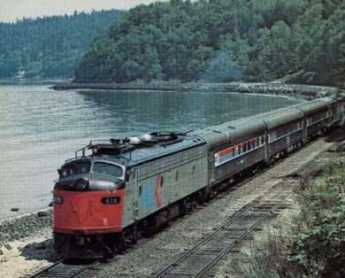
|
| Amtrak, 1971 |
By 1971, it was pretty clear the railroads in the Northeastern quadrant of America were relentlessly losing money and would soon collapse. Bankruptcy provided the only legal method for breaking the burdensome union contracts and huge legal tangles of rationalizing eight Northeastern systems, themselves the product of dozens of earlier mergers. At least in that sense, bankruptcy was a godsend. Getting down to serious reconstruction in 1971, the first step in cleaning things up was to strip off passenger business from the basically profitable freight business. The urban commuter business, hampered by local politics and facing overwhelming automobile competition, was probably the worst burden to profitability, but the decision was made to leave that to regional negotiations. A national long distance passenger system, Amtrak, would service everybody in one nationally subsidized network, with efficiency actually enhanced by national seamlessness. In a few areas like the Northeast corridor and California, long-distance passenger travel was actually still profitable.
Commuter systems, however, had grown up as local creations, differing greatly in local design and importance, and subsidy from the local population. They connected urban regions with suburban ones, and these two regions were often in uncertain economic (hence political) conflict with each other. Such loss-producing operations urgently needed to be stripped off from freight service, but here it seemed expedient to let each region of the country negotiate particularities, with many variations related to local issues. In particular, spreading the source of subsidy was a delicate political problem. If Philadelphia's SEPTA (South Eastern Pennsylvania Transportation Authority) is typical, these local arrangements needed to be more generous to the unions than national opinion would permit; the rest of the country, viewing them at a distance, effectively told the big eastern cities to subsidize unions if they wished, but rural regions would have no part of it. National division of opinion on this issue effectively matches the boundaries of the "Rust Belt". It is debatable how seriously commuter subsidy, net of intangible advantages, still represents an economic drag on each metropolitan economy today; but it is certainly some kind of a drag, with numbers that appear rather large. Meanwhile, public sympathy is steadily drifting away from the unions; the Rust Belt is slowly migrating from liberal-leaning toward undecided.
Long distance passenger traffic was another matter; by insisting on railroads to nowhere, rural America shared equal guilt. Amtrak loses money, lots of it, but with generous subsidies, it has steadily improved service and equipment, usually sufficient to get past annual Congressional complaint sessions. Because of political log-rolling, Amtrak's separation from freight business is not entirely clean. It's responsible for servicing the pensions of all railroad employees, not just passenger employees, for example. Since pension funding delays its true cost for many years, the public is only recently becoming upset about this; the matter may arise again.
Meanwhile, it soon became clear that even freight service was going to sink in spite of jettisoning passenger businesses; this alone was not enough. Even setting profitability aside, there is no economical substitute for rail transport of bulk cargo like coal, oil, wheat, and ore, so interruption of national freight service would be an unimaginable disaster. All eight northeastern railroads were facing certain bankruptcy, which at least had the advantage of permitting courts to break union contracts; but one-quarter of the network could not be closed without closing freight service everywhere. The unions protested their rules were only responsible for minor costs compared with management incompetence, but the blame game was now irrelevant, bankruptcy was inevitable. Strangely, the average American had little idea of the full seriousness of this impending calamity, but the necessary legislation to create Conrail, a nationalized and subsidized Northeastern freight railroad, was cobbled together in the Regional Rail Reorganization Act of 1973. The law mostly restated agreements which had been forged during years of acrimonious negotiation between the parties. Not everyone agreed with everything, however, and a Supreme Court appeal was certain to intervene before the decisions could be final. The trustees of the Penn Central were most resistant to the terms. Investors universally regarded the outlook for a successful outcome as dismal.

|
| Conrail, 1974 |
Essentially, the transaction was to trade Conrail stock for the debt represented by bondholders of the bankrupt railroads; a swap of equity for debt. Hidden in these bankruptcy proceedings was the elimination of many of the union rules that had been so burdensome. For consolation, the unions got a promise of jobs for at least some of their members, and the satisfaction of gloating that the bondholders ("speculators") had been stripped. The bondholders wanted the Tucker Act applied, which is to say the right to sue the U.S. Government later if the true value of the stock had been seriously misjudged. The situation was very bleak. Conrail probably couldn't survive, and its stock would probably prove to be worthless. The Penn Central trustees were particularly dismayed at the possibility that there would be continuing losses after the settlement ("erosion"), which Penn Central bondholders would be forced to cover by further reducing their share of the already miserable residuals. For Congress to force bondholders into such coerced backing of a venture they definitely felt was doomed, amounted to a government seizure of their property without just recompense. It would thus be a violation of the Fifth Amendment of the Constitution which contains a clause prohibiting what are known as "private takings". Meanwhile, the country was approaching an economic train wreck.
The Supreme Court had sympathy for Penn Central's argument and did find that a Tucker appeal should be available, a second bite at the apple, so to speak. Largely unspoken was the recognition that some weakening of union power was essential for even a hope of survival of the freight industry; so some conflicting language in the 1973 Act about Tucker appeals was -- sort of ignored. But later events showed the union work rules really had been critical to getting the railroads into the mess, and so successful agreements were reached at this moment of despair which never would have been agreed to if the true facts had been predicted. Railroad management, of course, contended that the work rules had been crippling them. But that appeared to be self-serving and the stock market largely ignored it.
But some remarkable men were put in charge of Conrail. They moved with remarkable speed to cut the size of train crews and otherwise remove a century of make-work rules. The quantity of freight cargo in 2010 is the same as that moved in 1974, but the workforce is reduced by 75%. Conrail became profitable, further mergers of national freight lines were negotiated, and it turns out that if someone had forced you to accept some Conrail stock in return for near-worthless bonds, you would have been a very lucky person.
Last Will of Benjamin Franklin
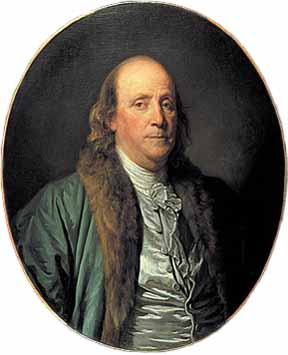
|
| Benjamin Franklin |
The Last Will and Testament of Benjamin Franklin
I, Benjamin Franklin, of Philadelphia, printer, late Minister Plenipotentiary from the United States of America to the Court of France, now President of the State of Pennsylvania, do make and declare my last will and testament as follows:
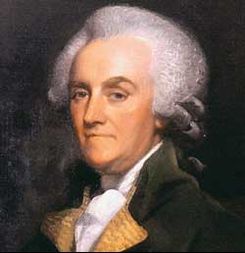
|
| William Franklin |
To my son, William Franklin, late Governor of the Jerseys, I give and devise all the lands I hold or have a right to, in the province of Nova Scotia, to hold to him, his heirs, and assigns forever. I also give to him all my books and papers, which he has in his possession, and all debts standing against him on my account books, willing that no payment for, nor restitution of, the same be required of him, by my executors. The part he acted against me in the late war, which is of public notoriety, will account for my leaving him no more of an estate he endeavored to deprive me of.
Having since my return from France demolished the three houses in Market Street, between Third and Fourth Streets, fronting my dwelling-house, and erected two new and larger ones on the ground, and having also erected another house on the lot which formerly was the passage to my dwelling, and also a printing-office between my dwelling and the front houses; now I do give and devise my said dwelling-house, wherein I now live, my said three new houses, my printing- office and the lots of ground thereto belonging; also my small lot and house in Sixth Street, which I bought off the widow Henmarsh; also my pasture-ground which I have in Hickory Lane, with the buildings thereon; also my house and lot on the North side of Market Street, now occupied by Mary Jacobs, together with two houses and lots behind the same, and fronting on Pewter-Platter Alley; also my lot of ground in Arch Street, opposite the church-burying ground, with the buildings thereon erected; also all my silver plate, pictures, and household goods, of every kind, now in my said dwelling-place, to my daughter, Sarah Bache, and to her husband, Richard Bache, to hold to them for and during their natural lives, and the life of the longest liver of them, and from and after the decease of the survivor of them, I do give, devise, and bequeath to all children already born, or to be born of my said daughter, and to their heirs and assigns forever, as tenants in common, and not as joint tenants.
And, if any or either of them shall happen to die under age, and without issue, the part and share of him, her, or them, so dying, shall go to and be equally divided among the survivors or survivor of them. But my intention is, that, if any or either of them should happen to die under age, leaving issue, such issue shall inherit the part and share that would have passed to his, her, or their parent, had he, she, or they were living.
And, as some of my said devisees may, at the death of the survivor of their father or mother, be of age, and others of them underage, so as that all of them may not be of capacity to make division, I in that case request and authorize the judges of the Supreme Court of Judicature of Pennsylvania for the time being, or any three of them, not personally interested, to appoint by writing, under their hands and seals, three honest, intelligent, impartial men to make the said division, and to assign and allot to each of my devisees their respective share, which division, so made and committed to writing under the hands and seals of the said three men, or any two of them, and confirmed by the said judges, I do hereby declare shall be binding on, and conclusive between the said devisees.
All the lands near the Ohio, and the lots near the centre of Philadelphia, which I lately purchased of the State, I give to my son-in-law, Richard Bache, his heirs and assigns forever; I also give him the bond I have against him, of two thousand and one hundred and seventy-two pounds, five shillings, together with the interest that shall or may accrue thereon, and direct the same to be delivered up to him by my executors, canceled, requesting that, in consideration thereof, he would immediately after my decease manumit and set free his Negro man Bob. I leave to him, also, the money due to me from the State of Virginia for types. I also give to him the bond of William Goddard and his sister, and the counter bond of the late Robert Grace, and the bond and judgment of Francis Childs, if not recovered before my decease, or any other bonds, except the bond due from ----- Killian, of Delaware State, which I give to my grandson, Benjamin Franklin Bache. I also discharge him, my said son-in-law, from all claim and rent of money due to me, on book account or otherwise. I also give him all my musical instruments.
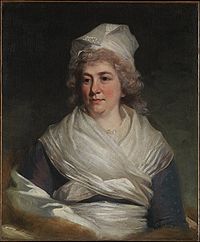
|
| Sarah Bache |
The king of France's picture, set with four hundred and eight diamonds, I give to my daughter, Sarah Bache, requesting , however, that she would not form any of those diamonds into ornaments either for herself or daughters, and thereby introduce or countenance the expensive, vain, and useless fashion of wearing jewels in this country; and those immediately connected with the picture may be preserved with the same.
I give and devise to my dear sister, Jane Mecom, a house and lot I have in Unity Street, Boston, nor or late under the care of Mr. Jonathan Williams, to her and to her heirs and assigns forever. I also give her the yearly sum of fifty pounds sterling, during life, to commence at my death, and to be paid to her annually out of the interests or dividends arising on twelve shares which I have since my arrival at Philadelphia purchased in the Bank of North America, and, at her decease, I give the said twelve shares in the bank to my daughter, Sarah Bache, and her husband, Richard Bache. But it is my express will and desire that, after the payment of the above fifty pounds sterling annually to my said sister, my said daughter be allowed to apply the residue of the interest or dividends on those shares to her sole and separate use, during the life of my said sister, and afterwards the whole of the interest or dividends thereof as her private pocket money.
I give the right I have to take up to three thousand acres of land in the State of Georgia, granted to me by the government of that State, to my grandson, William Temple Franklin, his heirs and assigns forever. I also give to my grandson, William Temple Franklin, the bond and judgment I have against him of four thousand pounds sterling, my right to the same to cease upon the day of his marriage; and if he dies unmarried, my will is, that the same be recovered and divided among my other grandchildren, the children of my daughter, Sarah Bache, in such manner and form as I have herein before given to them the other parts of my estate.
The philosophical instruments I have in Philadelphia I give to my ingenious friend, Francis Hopkinson.
To the children, grandchildren, and great-grandchildren of my brother, Samuel Franklin, that may be living at the time of my decease, I give fifty pounds sterling, to be equally divided among them. To the children, grandchildren, and great-grandchildren of my sister, Anne Harris, that may be living at the time of my decease, I give fifty pounds sterling to be equally divided among them. To the children, grandchildren, and great-grandchildren of my brother James Franklin, that may be living at the time of my decease, I give fifty pounds sterling to be equally divided among them. To the children, grandchildren, and great-grandchildren of my sister, Sarah Davenport, that may be living at the time of my decease, I give fifty pounds sterling to be equally divided among them. To the children, grandchildren, and great-grandchildren of my sister, Lydia Scott, that may be living at the time of my decease, I give fifty pounds sterling to be equally divided among them. To the children, grandchildren, and great-grandchildren of my sister, Jane Mecom, that may be living at the time of my decease, I give fifty pounds sterling to be equally divided among them.
I give to my grandson, Benjamin Franklin Bache, all the types and printing materials, which I now have in Philadelphia, with the complete letter foundry, which, in the whole, I suppose to be worth near one thousand pounds; but if he should die under age, then I do order the same to be sold by my executors, the survivors or survivor of them, and the money be equally divided among all the rest of my said daughter's children, or their representatives, each one on coming of age to take his or her share, and the children of such of them as may die under age to represent and to take the share and proportion of, the parent so dying, each one to receive his or her part of such share as they come of age.
With regard to my books, those I had in France and those I left in Philadelphia, is now assembled together here, and a catalog made of them, it is my intention to dispose of them as follows: My "History of the Academy of Sciences," in sixty or seventy volumes quarto, I give to the Philosophical Society of Philadelphia, of which I have the honor to be President. My collection in a folio of "Les Arts et les Metiers," I give to the American Philosophical Society, established in New England, of which I am a member. My quarto edition of the same, "Arts et Metiers," I give to the Library Company of Philadelphia. Such and so many of my books as I shall mark on my said catalog with the name of my grandson, Benjamin Franklin Bache, I do hereby give to him; and such and so many of my books as I shall mark on the said catalog with the name of my grandson, William Bache, I do hereby give to him; and such as shall be marked with the name of Jonathan Williams, I hereby give to my cousin of that name. The residue and remainder of all my books, manuscripts, and papers, I do give to my grandson, William Temple Franklin. My share in the Library Company of Philadelphia, I give to my grandson, Benjamin Franklin Bache, confiding that he will permit his brothers and sisters to share in the use of it.
I was born in Boston, New England, and owe my first instructions in literature to the free grammar schools established there. I, therefore, give one hundred pounds sterling to my executors, to be by them, the survivors or survivor of them, paid over to the managers or directors of the free schools in my native town of Boston, to be by them, or by those person or persons, who shall have the superintendence and management of the said schools, put out to interest, and so continued at interest forever, which interest annually shall be laid out in silver medals, and given as honorary rewards annually by the directors of the said free schools belonging to the said town, in such manner as to the discretion of the selectmen of the said town shall seem meet.
Out of the salary that may remain due to me as President of the State, I do give the sum of two thousand pounds sterling to my executors, to be by them, the survivors or survivor of them, paid over to such person or persons as the legislature of this State by an act of Assembly shall appoint to receive the same in trust, to be employed for making the river Schuylkill navigable.
And what money of mine shall, at the time of my decease, remain in the hands of my bankers, Messrs. Ferdinand Grand and Son, at Paris, or Messrs. Smith, Wright, and Gray, of London, I will that, after my debts are paid and deducted, with the money legacies of this my will, the same be divided into four equal parts, two of which I give to my dear daughter, Sarah Bache, one to her son Benjamin, and one to my grandson, William Temple Franklin.
During the number of years I was in business as a stationer, printer, and postmaster, a great many small sums became due for books, advertisements, postage of letters, and other matters, which were not collected when, in 1757, I was sent by the Assembly to England as their agent, and by subsequent appointments continued there till 1775, when on my return, I was immediately engaged in the affairs of Congress and sent to France in 1776, where I remained nine years, not returning till 1785, and the said debts, not being demanded in such a length of time, are become in a manner obsolete, yet are nevertheless justly due. These, as they are stated in my great folio ledger E, I bequeath to the contributors to the Pennsylvania Hospital, hoping that those debtors, and the descendants of such as are deceased, who now, as I find, make some difficulty of satisfying such antiquated demands as just debts, may, however, be induced to pay or give them as charity to that excellent institution. I am sensible that much must inevitably be lost, but I hope something considerable may be recovered. It is possible, too, that some of the parties charged may have existing old, unsettled accounts against me; in which case the managers of the said hospital will allow and deduct the amount, or pay the balance if they find it against me.
My debts and legacies being all satisfied and paid, the rest and residue of all my estate, real and personal, not herein expressly disposed of, I do give and bequeath to my son and daughter, Richard and Sarah Bache.
I request my friends, Henry Hill, Esquire, John Jay, Esquire, Francis Hopkinson, Esquire, and Mr. Edward Duffield, of Benfield, in Philadelphia County, to be the executors of this my last will and testament; and I hereby nominate and appoint them for that purpose.
I would have my body buried with as little expense or ceremony as may be. I revoke all former wills by me made, declaring this only to be my last.
In witness whereof, I have hereunto set my hand and seal, this seventeenth day of July, in the year of our Lord, one thousand seven hundred and eighty-eight.
B. Franklin
Signed, sealed, published, and declared by the above named Benjamin Franklin, for and as his last will and testament, in the presence of us.
Abraham Shoemaker, John Jones, George Moore.
CODICIL
I, Benjamin Franklin, in the foregoing or annexed last will and testament named, having further considered the same, do think proper to make and publish the following codicil or addition thereto.
It has long been a fixed political opinion of mine, that in a democratical state there ought to be no offices of profit, for the reasons I had given in an article of my drawing in our constitution, it was my intention when I accepted the office of President, to devote the appointed salary to some public uses. Accordingly, I had already, before I made my will in July last, given large sums of it to colleges, schools, the building of churches, etc.; and in that will I bequeathed two thousand pounds more to the State for the purpose of making the Schuylkill navigable. But understanding since that such a work, and that the project is not likely to be undertaken for many years to come, and having entertained another idea, that I hope may be more extensively useful, I do hereby revoke and annul that bequest, and direct that the certificates I have for what remains due to me of that salary be sold, towards raising the sum of two thousand pounds sterling, to be disposed of as I am now about to order.
It has been an opinion, that he who receives an estate from his ancestors is under some kind of obligation to transmit the same to their posterity. This obligation does not lie on me, who never inherited a shilling from an ancestor or relation. I shall, however, if it is not diminished by some accident before my death, leave a considerable estate among my descendants and relations. The above observation is made as merely as some apology to my family for making bequests that do not appear to have any immediate relation to their advantage.
I was born in Boston, New England, and owe my first instructions in literature to the free grammar schools established there. I have, therefore, already considered these schools in my will. But I am also under obligations to the State of Massachusetts for having, unasked, appointed me formerly their agent in England, with a handsome salary, which continued some years; and although I accidentally lost in their service, by transmitting Governor Hutchinson's letters, much more than the amount of what they gave me, I do not think that ought in the least to diminish my gratitude.
I have considered that, among artisans, good apprentices are most likely to make good citizens, and, having myself been bred to a manual art, printing, in my native town, and afterward assisted to set up my business in Philadelphia by kind loans of money from two friends there, which was the foundation of my fortune, and all the utility in life that may be ascribed to me, I wish to be useful even after my death, if possible, in forming and advancing other young men, that may be serviceable to their country in both these towns. To this end, I devote two thousand pounds sterling, of which I give one thousand thereof to the inhabitants of the town of Boston, in Massachusetts, and the other thousand to the inhabitants of the city of Philadelphia, in trust, to and for the uses, intents, and purposes hereinafter mentioned and declared.
The said sum of one thousand pounds sterling, if accepted by the inhabitants of the town of Boston, shall be managed under the direction of the selectmen, united with the ministers of the oldest Episcopalians, Congregational, and Presbyterian churches in that town, who are to let out the sum upon interest, at five per cent, per annum, to such young married artificers, under the age of twenty-five years, as have served an apprenticeship in the said town, and faithfully fulfilled the duties required in their indentures, so as to obtain a good moral character from at least two respectable citizens, who are willing to become their sureties, in a bond with the applicants, for the repayment of the moneys so lent, with interest, according to the terms hereinafter prescribed; all which bonds are to be taken for Spanish milled dollars, or the value thereof in current gold coin; and the managers shall keep a bound book or books, wherein shall be entered the names of those who shall apply for and receive the benefits of this institution, and of their sureties, together with the sums lent, the dates, and other necessary and proper records respecting the business and concerns of this institution. And as these loans are intended to assist young married artificers in setting up their business, they are to be proportioned by the discretion of the managers, so as not to exceed sixty pounds sterling to one person, nor to be less than fifteen pounds; and if the number of appliers so entitled should be so large as that the sum will not suffice to afford to each as much as might otherwise not be improper, the proportion to each shall be diminished so as to afford to everyone some assistance. These aids may, therefore, be small at first, but, as the capital increases by the accumulated interest, they will be ampler. And in order to serve as many as possible in their turn, as well as to make the repayment of the principal borrowed easier, each borrower shall be obliged to pay, with the yearly interest, one-tenth part of the principal and interest, so paid in, shall be again let out to fresh borrowers.
And, as it is presumed that there will always be found in Boston virtuous and benevolent citizens, willing to bestow a part of their time in doing good to the rising generation, by superintending and managing this institution gratis, it is hoped that no part of the money will at any time be dead, or be diverted to other purposes, but be continually augmenting by the interest; in which case there may, in time, be more than the occasions in Boston shall require, and then some may be spared to the neighboring or other towns in the said State of Massachusetts, who may desire to have it; such towns engaging to pay punctually the interest and the portions of the principal, annually, to the inhabitants of the town of Boston.
If this plan is executed, and succeeds as projected without interruption for one hundred years, the sum will then be one hundred and thirty-one thousand pounds; of which I would have the managers of the donation to the town of Boston then layout, at their discretion, one hundred thousand pounds in public works, which may be judged of most general utility to the inhabitants, such as fortifications, bridges, aqueducts, public buildings, baths, pavements, or whatever may make living in the town more convenient to its people, and render it more agreeable to strangers resorting thither for health or a temporary residence. The remaining thirty-one thousand pounds I would have continued to be let out on interest, in the manner above directed, for another hundred years, as I hope it will have been found that the institution has had a good effect on the conduct of youth, and been of service to many worthy characters and useful citizens. At the end of this second term, if no unfortunate accident has prevented the operation, the sum will be four million and sixty-one thousand pounds sterling, of which I leave one million sixty-one thousand pounds to the disposition of the inhabitants of the town of Boston, and three million to the disposition of the government of the state, not presuming to carry my views farther.
All the directions herein given, respecting the disposition and management of the donation to the inhabitants of Boston, I would have observed respecting that to the inhabitants of Philadelphia, only, as Philadelphia is incorporated, I request the corporation of that city to undertake the management agreeably to the said directions; and I do hereby vest them with full and ample powers for that purpose. And, having considered that the covering a ground plot with buildings and pavements, which carry off most of the rain and prevent its soaking into the Earth and renewing and purifying the Springs, whence the water of wells must gradually grow worse, and in time be unfit for use, as I find has happened in all old cities, I recommend that at the end of the first hundred years, if not done before, the corporation of the city Employ a part of the hundred thousand pounds in bringing, by pipes, the water of Wissahickon Creek into the town, so as to supply the inhabitants, which I apprehend may be done without great difficulty, the level of the creek is much above that of the city, and may be made higher by a dam. I also recommend making the Schuylkill completely navigable. At the end of the second hundred years, I would have the disposition of the four million and sixty-one thousand pounds divided between the inhabitants of the city of Philadelphia and the government of Pennsylvania, in the same manner as herein directed with respect to that of the inhabitants of Boston and the government of Massachusetts.
It is my desire that this institution should take place and begin to operate within one year after my decease, for which purpose due notice should be publicly given previous to the expiration of that year, that those for whose benefit this establishment is intended may make their respective applications. And I hereby direct my executors, the survivors or survivor of them, within six months after my decease, to pay over the sum of two thousand pounds sterling to such persons as shall be duly appointed by the Selectmen of Boston and the corporation of Philadelphia, to receive and take charge of their respective sums, of one thousand pounds each, for the purposes aforesaid.
Considering the accidents to which all human affairs and projects are subject in such a length of time, I have, perhaps, too much flattered myself with a vain fancy that these dispositions, if carried into execution, will be continued without interruption and have the effects proposed. I hope, however, that is the inhabitants of the two cities should not think fit to undertake the execution, they will, at least, accept the offer of these donations as a mark of my good will, a token of my gratitude, and a testimony of my earnest desire to be useful to them after my departure.
I wish, indeed, that they may both undertake to endeavor the execution of the project, because I think that, though unforeseen difficulties may arise, expedients will be found to remove them, and the scheme be found practicable. If one of them accepts the money, with the conditions, and the other refuses, my will then is, that both Sums be given to the inhabitants of the city accepting the whole, to be applied to the same purposes, and under the same regulations directed for the separate parts; and, if both refuse, the money, of course, remains in the mass of my Estate, and is to be disposed of therewith according to my will made the Seventeenth day of July, 1788.
I wish to be buried by the side of my wife, if it may be, and that a marble stone, to be made by Chambers, six feet long, four feet wide, plain, with only a small molding around the upper edge, and this inscription:
Benjamin And Deborah Franklin 178-
to be placed over us both. My fine crab-tree walking stick, with a gold head, curiously wrought in the form of the cap of liberty, I give to my friend, and the friend of mankind, General Washington. If it were a Sceptre, he has merited it and would become it. It was a present to me from that excellent woman, Madame de Forbach, the Dowager Duchess of Deux-Ponts, connected with some verses which should go with it. I give my gold watch to my son-in-law Richard Bache, and also the gold watch chain of the Thirteen United States, which I have not yet worn. My timepiece, that stands in my library, I give to my grandson, William Temple Franklin. I give him also my Chinese gong. To my dear old friend, Mrs. Mary Hewson, I give one of my silver tankards marked for her use during her life, and after her decease, I give it to her daughter Eliza. I give to her son, William Hewson, who is my godson, my new quarto Bible, and also the botanic description of the plants in the Emperor's garden at Vienna, in folio, with colored cuts.
And to her son, Thomas Hewson, I give a set of "Spectators, Tattlers, and Guardians" handsomely bound.
There is an error in my will, where the bond of William Temple Franklin is mentioned as being four thousand pounds sterling, whereas it is but for three thousand five hundred pounds.
I give to my executors, to be divided equally among those that act, the sum of sixty pounds sterling, as some compensation for their trouble in the execution of my will; and I request my friend, Mr. Duffield, to accept moreover my French waywiser, a piece of clockwork in Brass, to be fixed to the wheel of any carriage; and that my friend, Mr. Hill, may also accept my silver cream pot, formerly given to me by the good Doctor Fothergill, with the motto, Keep bright the Chain. My reflecting telescope, made by Short, which was formerly Mr. Canton's, I give to my friend, Mr. David Rittenhouse, for the use of his observatory.
My picture, drawn by Martin, in 1767, I give to the Supreme Executive Council of Pennsylvania, if they shall be pleased to do me the honor of accepting it and placing it in their chamber. Since my will was made I have bought some more city lots, near the center part of the estate of Joseph Dean. I would have them go with the other lots, disposed of in my will, and I do give the same to my Son-in-law, Richard Bache, to his heirs and assigns forever.
In addition to the annuity left to my sister in my will, of fifty pounds sterling during her life, I now add thereto ten pounds sterling more, in order to make the Sum sixty pounds. I give twenty guineas to my good friend and physician, Dr. John Jones.
With regard to the separate bequests made to my daughter Sarah in my will, my intention is, that the same shall be for her sole and separate use, notwithstanding her coverture, or whether she be covert or sole; and I do give my executors so much right and power therein as may be necessary to render my intention effectual in that respect only. This provision for my daughter is not made out of any disrespect I have for her husband.
And lastly, it is my desire that this, my present codicil, be annexed to, and considered as part of, my last will and testament to all intents and purposes.
In witness whereof, I have hereunto set my hand and Seal this twenty-third day of June, Anno Domini one thousand Seven hundred and eighty-nine.
B. Franklin.
Signed, sealed, published, and declared by the above named Benjamin Franklin to be a codicil to his last will and testament, in the presence of us.
Francis Bailey, Thomas Lang, Abraham Shoemaker.
Future Directions for Book Authoring

|
| TSR-80/100 |
Here's some advice for new authors of books: You can't write the first chapter until you have written the last chapter. That is, you have to hit the reader between the eyes in the first chapter, draw him into the argument, making a pauseless transition from a general statement of the author's thesis into a relentless march of evidence toward the conclusion. This general design comes easier with practice and is therefore much harder for beginners to accomplish. But even experienced authors are usually unable to keep the overall design of their message constantly in mind, to be able to sit down and write the book straight through from beginning to end. It's true that Sir Walter Scott was said to turn over the last page of a book, and immediately begin writing the first page of the next one without getting up from his desk. But we aren't talking about pot-boilers, we're talking about serious books. That includes almost all non-fiction and the great majority of serious fiction.
As a matter of fact, the description includes the majority of short articles as well; newspaper editorials would be a good example. Although the style of an editorial is to start with a generality, marshal a description of some recent events, and end up with a short summary, that isn't in fact how it is usually composed. The editorial writer starts with a one-liner, or call to action, organizes some recent events and some historical arguments as a reason to issue such a call, and then ends up by summarizing things in the first paragraph. Having mentally designed the editorial into such a three-step pattern, with experience a professional editorialist can sit down and write the editorial from beginning to end and, after a few touch-ups, it's ready for the printer. He really has gone through the organizational process which a book author needs to go through, but the article is short enough so that reconstruction is performed in his head. In a book, it is generally necessary to write out the chapters in a jumbled way, and later re-organize them. A new author with his first manuscript generally doesn't adequately appreciate the truth of this and has to be muscled by the editor, at least just a little bit. One of my editors summarized his job as follows: you tell every new author to take the first four chapters of his book and throw them away,
That's cruel, of course, and is seldom accepted graciously. The brusqueness is justified by understanding that the fresh new author thinks he's all finished when he isn't. He's silently telling himself he means to tell that editor, "Don't you touch a single comma of it." In the old days, authors were rare and had to be coddled. Book publishers in the Eighteenth century purchased the manuscript in its entirety, either then losing money or making a huge fortune, but leaving the author with only his manuscript price. At that time, publishers called themselves booksellers. As things evolved, booksellers often had to support a starving author while the book was being written, offering an "advance" payment to be deducted from royalties paid after final sales to readers. Author royalties were about ten percent of sales. The royalty system persists today, but advance payments are uncommon and negotiated around the tax code effects. All of these payment evolutions reflect the underlying issue: good authors used to be rare, but now are frequent. Book publishers used to be wealthy, but now are rapidly going bankrupt and extinct. Authors of excellent books have a hard time finding someone to publish them. The advent of the personal computer around 1980 is what caused this.
In 1980 I published a book, writing it on my brand-new Radio Shack TRS-80, Mod I. The editor of the publishing house had never heard of such a notion, scoffed at it, and declared he would never touch such a thing as a computer. In 2010 there were more than 800 million personal computers manufactured and sold, and by this time almost no publisher will accept a manuscript without an accompanying magnetic disc to make revisions cheap and easy, and to shift the costs of key-entry from the publisher to the author. At first, manuscripts were shipped to India for key entry. Now, it is the diskette which is mailed or e-mailed to India, and the editor is often located in India. We are soon approaching a day when the keyboard and author remain at home, sending material to gigantic server computers in China, from which the editor anywhere in the world can retrieve the material and revise it, returning the material to the server computer where the author can comment on the revisions without moving from his desk. After that stage, looms the prospect of the reader paying a fee on his credit card to access the "book" directly from the server, and reading it at home. At that point maybe the book will have been completed, and maybe it will be revised some more. In a sense, a book will never be definitely finished and allowing the public to read it will only be an episode within an unending process of revision. Newspapers, magazines, and books are all struggling to find a way to cope with this unpredictable evolution. Like most revolutions, this one doesn't have a clear idea where it is going.
So let's reflect back on the central process of authoring. In addition to the old maxims of the trade, there is the Euclidian reality that you can't write the last chapter until you somehow write a first one. The original first chapter, the one the author struggled so hard to compose, is destined to be cast off and replaced by a new first one, one that succinctly announces what is about to be said. After that must come a new second chapter, which takes the reader from the initial disconcerting summary back to the origins of the problem now about to be clarified. Followed by a third chapter, probably one shifted forward from the assorted chapters of evidence back into prominence as the key piece of evidence which leads to other confirmatory pieces of evidence; after that marches the parade of confirmatory evidence, ending with one zinger of a conclusion.
Voltaire or some other cynic would probably comment that what has here been outlined is merely an elaborated process of what editorial writers do: start with the conclusion and find slanted facts to fit it. Some may indeed do that. But there is some hope that the inevitable impact of technology on authorship can bring us to a system where many authors will assemble the facts, and only then derive a conclusion from them. If politicians would only adopt that system, maybe we could hope for a perfect world.
Lowering the Taxes on Corporations
In the early years of the 21st Century, Ireland lowered taxes on corporate profits to a 12.5% rate, far lower than neighboring countries. Whatever else it did, it promptly encouraged corporations in Germany, Denmark, the United Kingdom, and other neighbors -- to move headquarters to Ireland where taxes were so low. Ireland is primarily rural, and a housing shortage developed in the cities as workers migrated to take advantage of the new jobs. Home prices went through the roof, mortgage applications overwhelmed local banks, who promptly re-sold mortgages to foreign banks. Sound familiar? It caused a housing bubble and then a horrendous international financial crisis. The European Union is financially and politically strained by the consequences and threatened to break apart over it.
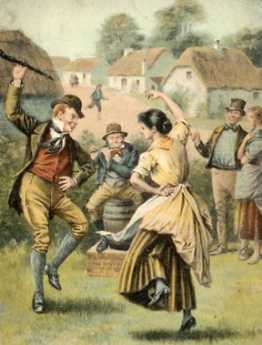
|
| Irish Jig |
That sounds pretty bad and should be a lesson to others. What Canada and a number of the individual United States got out of it was mainly this: if you lower corporation taxes, it causes prosperity. And so it might if politicians would do it gradually and moderately. Gradually and moderately are unfamiliar words in politics. Furthermore, there has long been a fundamental unfairness in taxing corporate profits twice -- once when the profits are made, and a second time when dividends are paid to shareholders. But it is obviously dangerous business, particularly when the governments involved are inexperienced. Canadians started talking about lowering their taxes to 16.5%, and no one could say whether that is a safe level or not. Within weeks, twenty-nine states with Republican governors were sending up trial balloons about joining this movement, and Governor Mitch Daniels of Indiana was much in demand as a consultant, and maybe a Presidential candidate, because Indiana had lowered corporate taxation some time ago, with favorable results.
This was exactly the sort of behavior James Madison had in mind when he designed the United States Constitution; it gave the people a way of disciplining overbearing state governments. Raise our taxes, and we will move. So there are strong arguments that these governors are approaching the right thing, and equally strong indications that everybody had better be plenty careful how this is approached.
The basic idea is good; double taxation should stop, and there is nothing in Madison's Constitution to prevent the Governors from doing what they say they would like to do. So how's this for a suggestion: if this movement gets started, let's take the opportunity to reduce all corporate income tax to zero. If everybody has the same zero rate, the incentive to migrate will disappear, and that's a good thing.
But if a major revenue source for the states disappears, what will take its place? At that moment of what would look like a crisis, it would be time for a national reconsideration and revision of the tax codes. And that would be an even more desirable outcome, provided it is done in an orderly and sensible way.
Foreground: Parliament Irks the Colonial Merchants
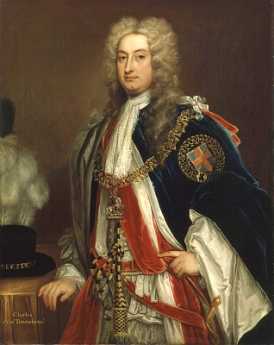
|
| Charles Townshend |
Charles Townshend, Chancellor of the Exchequer under King George III in 1766-67, had a reputation for abrasively witty behavior, in addition to which he did carry a grudge against American colonial legislatures for circumventing his directives when earlier he had been in charge of Colonial Affairs. His most despised action against the Colonies, the Stamp Act, seems to have been only a small part of a political maneuver to frustrate an opposition vote of no confidence. The vote had taken the form of lowering the homeland land tax from four to three shillings (an action understood to be a vote of no confidence because it unbalanced the budget, which he then re-balanced by raising the money in the colonies.) The novelist Tobias Smollett subsequently produced a scathing depiction of Townshend's heedless arrogance in Humphry Clinker, but at least in the case of the Stamp Act, its sting was more in its heedlessness of the colonies than vengeance against them. One can easily imagine the loathing this rich dandy would inspire in sobersides like George Washington and John Adams. After Townshend was elevated in the British cabinet, almost anything became a possibility, but it was a fair guess he might continue to satisfy old scores with the colonies. When King George's mother began urging the young monarch to act like a real king, Townshend was available to help. On the other hand, the Whig party in Parliament had significant sympathy with the colonial position, as a spill-over from their main uproar about John Wilkes which need not concern us here. Vengefulness against the colonies was not widespread in the British government at the time, but colonists could easily believe any Ministry which appointed the likes of Townshend might well abuse power in other ways before such time as the King or a more civilized Ministry could arrive on the scene to set things right. It was vexing that a man so heedless as Townshend could also carry so many grudges. Things did ease when Townshend suddenly died of an "untended fever", in 1767.
Whatever the intent of those Townshend Acts, one clear message did stand out: paper money was forbidden in the colonies. Virginia Cavaliers might be more upset by the 1763 restraints on moving into the Ohio territories, and New England shippers might be most irritated by limits on manufactures in the colonies. But prohibiting paper money seriously damaged all colonial trade. Some merchants protested vigorously, some resorted to smuggling, and others, chiefly Robert Morris, devised clever workarounds for the problems which had been created. Paper currency might be vexingly easy to counterfeit, but it was safer to ship than gold coins. In dangerous ocean voyages, the underlying gold (which the paper money represents) remains in the vaults of the issuer even if the paper representing it is lost at sea. Theft becomes more complicated when money is transported by remittances or promissory notes, so a merchant like Morris would quickly recognize debt paper (essentially, remittance contracts acknowledging the existence of debt) as a way to circumvent such inconveniences. In a few months, we would be at war with England, where adversaries blocking each other's currency would be routine. By that time, Morris had perfected other systems of coping with the money problem. In simplified form, a shipload of flour would be sent abroad and sold, the proceeds of which were then used to buy gunpowder for a return voyage; as long as the two transactions were combined, actual paper money was not needed. Another feature is more sophisticated; by keeping this trade going, short-term loans for one leg of the trip could be transformed into long-term loans for many voyages. Long-term loans pay higher rates of interest than short-term loans; it would nowadays be referred to as "riding the yield curve." This system is currently in wide use for globalized trade, and Lehman Brothers were the main banker for it in 2008. And as a final strategy, having half the round-trip voyage transport innocent cargoes, the merchant could increase personal profits legitimately, while cloaking the existence of the underlying gun running on the opposite leg of the voyage. If the ship is sunk, it can then be difficult to say whether the loss of such a ship was military or commercial, insurable or uninsurable. In the case of a tobacco cargo, the value at the time of departure might well be different from the value later. Robert Morris became known as a genius in this sort of trade manipulation, and later his enemies were never able to prove it was illegal. Ultimately, a ship captain always has the option of moving his cargo to a different port.
Other colonists surely responded to a shortage of currency in similar resourceful ways, including barter and the Quaker system of maintaining individual account books on both sides of the transaction, and "squaring up" the balances later but eliminating many transaction steps. Wooden chairs were also a common substitute as a medium of exchange. But "Old Square-toes," Thomas Willing, experienced in currency difficulties, and his bold, reckless younger partner Morris displayed the greatest readiness to respond to opportunity. Credit and short-term paper were fundamental promises to repay at a certain time, commonly with a front-end discount taking the place of interest payment. The amount of discount varied with the risk, both of disruption by the authorities, and the risk of default by the debtor. This discount system was rough and approximate, but it served. Quite accustomed to borrowing through an intermediary, who would then be directed to repay some foreign creditor, Morris, and Willing added the innovation of issuing promissory notes and selling the contract itself to the public at a profit. Thus, written contracts would effectively serve as money. A cargo of flour or tobacco represented value, but that value need only be transformed into cash when it was safe and convenient to do so.
The Morris-Willing team had already displayed its inventiveness by starting a maritime insurance company, thereby adding to their reputation for meeting extensive obligations; they established an outstanding credit rating. Although primarily in the shipping trade, the firm was also involved in trade with the Indians. There, they invented the entirely novel idea of selling their notes to the public, essentially becoming underwriters for the risk of the notes, quite like the way insurance underwriters assumed the risk of a ship sinking. Their reputation for ingenuity in working around obstacles was growing, as well as their credibility for prompt and reliable repayment. In modern parlance, they established an enviable "track record." A creditor is only interested in whether he will be repaid; satisfied with that, he doesn't care how rich or how poor you are. The profits from complex trading were regularly plowed back into the business; one observer estimated Robert Morris's cash assets at the start of the Revolution were no greater than those of a prosperous blacksmith. It didn't matter; he had credit.
In the event, this prohibition of colonial paper money did not last very long, so profits from it were not immense. But ideas had been tested which seemed to work. Today, transactions devised at Willing and Morris are variously known as commercial credit, financial underwriting, and casualty insurance. In 1776, Robert Morris would be 42 years old.
Power of the Purse
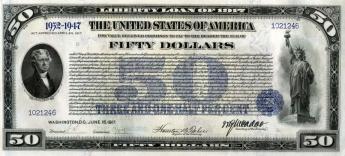
|
| Liberty Bond |
In 1917, Congress passed a law, quite possibly not understanding its full implications. From the founding of the republic until that time, Congress had approved the exact amount of each bond issue as enacted, neither more nor less. With the First Liberty Bond Act of 1917, however, Congress began to allow the administration to issue bonds as it pleased, up to some specified debt limit. Periodically since that time, as the amount in circulation approaches the debt limit, Congress raises the limit. No doubt this procedural change seemed like legislative streamlining, making it unnecessary for Congress to interrupt other activities to respond to a debt level which creeps up on its own time schedule. The overall effect of this change was significantly different, however, and probably unintentionally.
If the authorized debt limit is raised by large enough steps, it effectively amounts to Congress turning over debt decisions to the executive branch. Conversely, raising the limit only a small amount soon triggers a repeat request, which by routine becomes so inconsequential that Congress stops paying attention to it. Regardless of the size of the block grant, bulk authorization of blocks of debt results in the power of debt creation shifting toward the President. That was not what the Constitutional Convention intended.
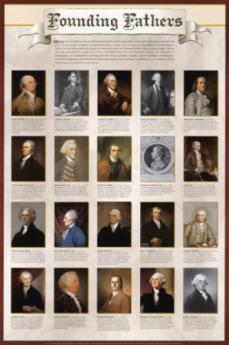
|
| Founding Fathers |
The Founding Fathers remembered taxation as one of the main issues of the revolt from England. Whether by King or President they had no intention of permitting the Executive to tax as he pleased; the issue traced back to the Magna Charta. Nor would they permit unlimited federal borrowing to generate escape hatches which would soon enough transform into higher taxes. Taxes, therefore, must originate in the House of Representatives, and bond issues were approved one by one. Following the 1917 liberalization, it required only fifty years before unrestrained bond limits reached a point where future national debt obligations loomed beyond the easy ability to pay them off. If they were ever pronounced unpayable by the international bond market, interest rates would rise, and eventually, federal bonds would become unsalable. With Greece, Portugal, and Ireland already flirting with bankruptcy, the approaching danger seems quite understandable to the voting public.
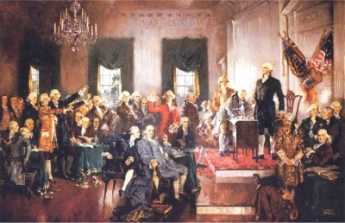
|
| Constitutional Convention |
The issue is constrained by another barrier. The Fourteenth Amendment to the Constitution, Section Four, forbids dishonoring "the validity of the public debt of the United States, authorized by law." Enacted after the Civil War, this Amendment was intended to prevent future states or congresses from reversing the Reconstruction Acts, but it has the additional effect of preventing future Congresses from dishonoring interest and debt repayments on existing debt. The present Congress, therefore, retains the latitude to prohibit the issuance of additional debt but is forbidden from dishonoring existing debt.
This seems like a good principle to re-emphasize, entirely disregarding the merits of the TARP, the Dodd/Frank Act, or Obamacare. Indeed, restating the Constitutional intent for Congress to be chiefly responsible for taxes and debts, seems like a very good thing to do, quite regardless of whether present national debt limits ought to be raised. The 1917 Act was a mistake, probably an unconstitutional one, and should be reversed. Holding conferences in the White House about whether to issue debt raises uncertainty about whose duty it is. The responsibility belongs to the House of Representatives, and should stay there.
The Virginian: A Philadelphian Goes West
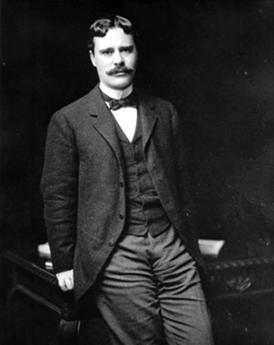
|
| Owen Wister |
Where is the Philadelphia gentleman? According to Owen Wister, that wealthy Philadelphia novelist of the late 19th century, a true gentleman is found on the frontier. He rides horses, brands cattle. He is a cowboy. Wister is credited with creating this great American archetype, now so familiar from hundreds of movies, in his novel, The Virginian: A Horseman of the Plains. Published in 1902, the novel documents the experience of a sensitive young Philadelphian traveling through the still unformed West, where he meets the American nobleman. Wister originally intended this book to be the first of a series of four charactrizations of the types of Americans. A second, about Baltimore, was published, but after that, the fame of his brilliant first novel swept his career in other directions. He seems to have originally intended to describe Virginians more than cowboys, but it's hard to know where his original intention would have carried him.
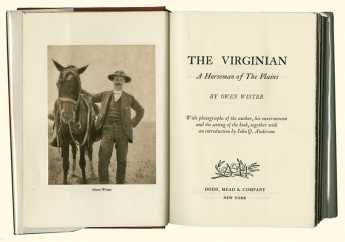
|
| The Virginian: A Horseman of the Plains |
Here is nevertheless a true classic. Using charmingly archaic language, Wister paints a landscape of sky and wild forests. His narrator speaks to the reader with the kind of verbal affection that only flourished in 19th-century literature. With an air of respect and modesty, the narrator introduces the reader to the novel's hero, the "Virginian." A transplant from the American south, this young man is a true Cowboy, a "daydream of glory made flesh" as Wallace Stegner once wrote. Early in the book, he stamps the hero with the line that made it all famous: "When you call me that, smile."
A host of colorful characters swirl around the Virginian as he aspires to social credibility and respect in the West. Western society, as understood through the Virginian's challenges and successes, is run by its own rules and social norms, norms that are heavily based on a largely male code of honor and decency. We learn about the code of the West as our Virginian learns it.
But the West is not only a myth of the American man; Molly Wood, another Easterner adrift in the wilderness, serves as a passionate, complicated love interest for the Virginian. Their relationship serves to contrast the social regulations of the East with the wilderness and abandon of the West. Wister's search for an American gentleman reminds us what it means to go West in search of something pure and new. What he found in the West has resonated throughout American culture for generations.
REFERENCES
| Philadelphia Gentlemen: The Making of a National Upper Class: E. Digby Baltzell ISBN-13: 978-0887387890 | Amazon |
William James and the Progressive Movement
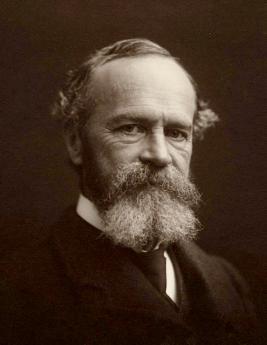
|
| William James |
Howard Callaway, noted historian, recently held forth at a meeting of the Franklin Inn Club about the Progressive Movement of the early 20th Century. His interesting point was that perhaps William James really started it all. The James brothers, William and Henry, were very rich and spent nearly twenty years in Europe. Their ideas may not have originated in Europe, but they certainly had a European tinge to them. Perhaps it is fair to surmise that the Progressives grew out of reaction to the Gilded Age, around 1870, which Howard feels was the last great episode of globalization before the present one.
In spite of the very European origins of Queen Victoria and her family, the British aristocracy has always feared and distrusted Europe. When Britain discovered it couldn't conquer Europe (or America), it turned its attention to developing a great commercial empire by colonizing Africa and East Asia. That led to building a Navy and establishing naval refueling stations at strategic places around the globe. Meanwhile, the Spanish empire was deteriorating, and colonization took on the form of competition between England, France, and Germany for the remnants of the Spanish empire. For background music, the Dreyfus episode led to or was prompted to lead to, an anti-military attitude that had considerable world-wide effect, essentially none of the above. In time, the none of above military attitude fused with Progressivism of the environmental sort which viewed industrialization as the enemy.
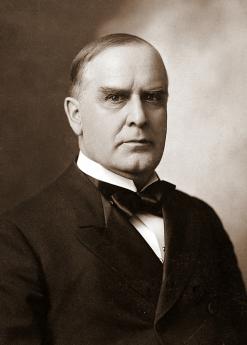
|
| William McKinley |
In a sense, American attitudes were influenced by William McKinley, who managed to convince labor they would be better off by advancing the cause of their bosses. Part of the reaction to this was the Populism of William Jennings Bryan and Robert LaFollette. McKinley's assassination and the promotion of Teddy Roosevelt was an unexpected turning point in American politics. Meanwhile, Admiral Dewey's fleet was stationed in Hong Kong. This association between America and Great Britain, along with secret German attempts to intervene in unobtrusive ways during the Spanish-American War were important factors in the later alliance between Britain and America in World War I. The burgeoning alliance between labor and management which McKinley was well along toward making the dominant force in American politics, was thus precipitously switched toward Progressivism by McKinley's assassination, which revealed he had made the one major blunder of selecting Teddy Roosevelt as his vice president, who in turn made the same blunder in reverse by selecting William Howard Taft as his own successor. The splitting of the Republican party between Roosevelt and Taft made possible the election of Woodrow Wilson, the college professor.
It thus can be concluded that the repeated switching between Conservatism and Progressivism during the Presidencies of McKinley through Wilson was the main source of the present rearranged coalitions we call the Republican and Democratic parties. It only remained for Franklin Roosevelt to complete the process by fitting the South, Catholics, and Jews into the Democratic Alliance, and Richard Nixon to undo it partially with switching the South and the Catholics back into the Republican party. The demography of the parties has changed more than the ideology, which tends more toward a coalition of business and Southerners versus blue-stocking progressives linked with labor union populists. Underlying all of this is the general acknowledgment of the need for a two-party system. Instead of having five or six small parties, the ultimate choice is whether a dissatisfied sub party is disaffected enough to switch parties. The nation is geographically so large and the subgroups so scattered that almost everyone except recent immigrants instinctively respects the two-party imperative.
| Posted by: Ginger Doyle from Schiffer Publishing | Sep 28, 2009 2:37 PM |
YMHOS,
| Posted by: Raymond G. Bush | Oct 23, 2007 9:45 AM |
47 Blogs
The Franklin Inn
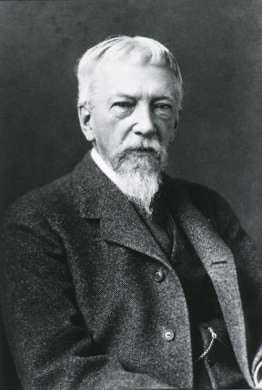 Founded by S. Weir Mitchell as a literary society, this little club hidden on Camac Street has been the center of Philadelphia's literary life for more than a century.
Founded by S. Weir Mitchell as a literary society, this little club hidden on Camac Street has been the center of Philadelphia's literary life for more than a century.
A Toast to Doctor Franklin
 The Franklin Inn annually toasts three doctors. Even though Ben never went past second grade, his medical contributions are the most illustrious of the three. One of the most remarkable men who ever lived.
The Franklin Inn annually toasts three doctors. Even though Ben never went past second grade, his medical contributions are the most illustrious of the three. One of the most remarkable men who ever lived.
Toast To Benjamin Franklin
 Toasts to Ben Franklin continue. This one by a former president of Swarthmore College has its focus on women in Ben's life.
Toasts to Ben Franklin continue. This one by a former president of Swarthmore College has its focus on women in Ben's life.
A Toast To J. William White, MD
 Franklin Inn holds the J. William White dinner every year on Benjamin Franklin's birthday. A surgeon, author, politician, athlete, cavalryman, and duelist, Bill was a real Philadelphia gentleman.
Franklin Inn holds the J. William White dinner every year on Benjamin Franklin's birthday. A surgeon, author, politician, athlete, cavalryman, and duelist, Bill was a real Philadelphia gentleman.
A Toast To Silas Weir Mitchell, MD
 Philadelphia medical scene, and the literary one.
Philadelphia medical scene, and the literary one.
Yet Another Toast to Dr. J. William White
 a great many toasts to J. William White have been given since his death in 1916. This one was proposed by Philadelphia's lawyer-novelist Arthur R. G. Solmssen.
a great many toasts to J. William White have been given since his death in 1916. This one was proposed by Philadelphia's lawyer-novelist Arthur R. G. Solmssen.
The Founding of The Franklin Inn Club
A History of the Franklin Inn, written for the 5oth Anniversary Dinner, by Arthur Hobson Quinn in 1952.
Charter of Incorporation of Franklin Inn Club (1902)
 In 1902, four noted Philadelphia gentlemen appeared before a judge and incorporated the Franklin Inn Club, whose purpose was to promote social intercourse among authors, illustrators, editors, and publishers.
In 1902, four noted Philadelphia gentlemen appeared before a judge and incorporated the Franklin Inn Club, whose purpose was to promote social intercourse among authors, illustrators, editors, and publishers.
Benjamin Franklin: Chronology
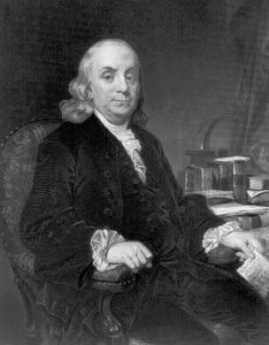 Franklin retired at age 42, and spent the other half of his life in public service. Only fifteen years of that career was spent in America. His timing was good, however; he was here for the French and Indian War, the Declaration of Independence, and the Constitutional Convention.
Franklin retired at age 42, and spent the other half of his life in public service. Only fifteen years of that career was spent in America. His timing was good, however; he was here for the French and Indian War, the Declaration of Independence, and the Constitutional Convention.
Logan, Franklin, Library
 James Logan and Benjamin Franklin were at the opposite ends of the social scale in Colonial Philadelphia and were to adopt strongly differing political views. But each recognized the intellectual power of the other, and they were fast friends.
James Logan and Benjamin Franklin were at the opposite ends of the social scale in Colonial Philadelphia and were to adopt strongly differing political views. But each recognized the intellectual power of the other, and they were fast friends.
Madame Butterfly (2)
 It is Puccini's genius to take this story of two nasty Americans destroying an honorable Japanese girl, and using the same story with the same words, make it into a romantic woman destroyed by a hopeless, helpless love affair. /br>
It is Puccini's genius to take this story of two nasty Americans destroying an honorable Japanese girl, and using the same story with the same words, make it into a romantic woman destroyed by a hopeless, helpless love affair. /br>
The Garden Show Evolves
 Exhibitors at the Philadelphia Garden Show have gradually evolved from amateurs to nurserymen, and from nurserymen to florists.
Exhibitors at the Philadelphia Garden Show have gradually evolved from amateurs to nurserymen, and from nurserymen to florists.
Durance Vile
 Imprisonment is a comparatively recent form of punishment, only marginally better than the alternatives.
Imprisonment is a comparatively recent form of punishment, only marginally better than the alternatives.
Franklin's Admirers on TV
 The author finds himself on television, and wonders whether c-span is a variant of blogging. From that, we go on to question whether Franklin really liked the French.
The author finds himself on television, and wonders whether c-span is a variant of blogging. From that, we go on to question whether Franklin really liked the French.
Frank Furness,(3) Rush's Lancer
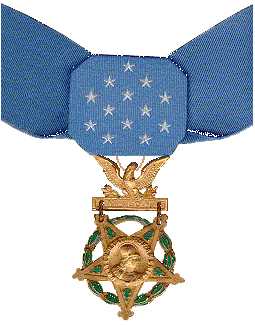 One of Philadelphia's most famous architects had two notable exploits as a Civil War cavalry officer, one of which won him the Congressional Medal of Honor.
One of Philadelphia's most famous architects had two notable exploits as a Civil War cavalry officer, one of which won him the Congressional Medal of Honor.
World Finance, Columbus Day 2008

Edgar Allan Poe, 1809-1849
 Edgar Allan Poe may not have the highest literary esteem of any American, but he is probably our most famous poet. At the 200th anniversary of his birth, his disordered life symbolizes an era.
Edgar Allan Poe may not have the highest literary esteem of any American, but he is probably our most famous poet. At the 200th anniversary of his birth, his disordered life symbolizes an era.
HSP: Philadelphia's Attic
 The Historical Society of Pennsylvania started out in 1824 as a repository of family treasures. Several mergers and changes of direction have given it a new mission.
The Historical Society of Pennsylvania started out in 1824 as a repository of family treasures. Several mergers and changes of direction have given it a new mission.
Another Toast to S. Weir Mitchell
The former President of Swarthmore College tips his hat to the founder of the Franklin Inn Club.
B. Franklin, Scientist
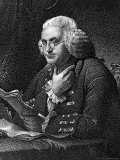 Kites are children's toys; going out in a thunderstorm is deliciously dangerous. We have thus been taught to regard Franklin's science as a lark, when in fact he largely discovered the nature of electricity and was regarded as one of the greatest scientists of his age.
Kites are children's toys; going out in a thunderstorm is deliciously dangerous. We have thus been taught to regard Franklin's science as a lark, when in fact he largely discovered the nature of electricity and was regarded as one of the greatest scientists of his age.
Barringer Crater in Winslow AZ
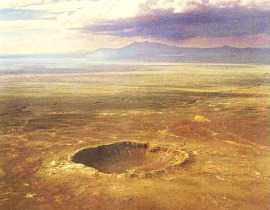
Madeira Party 2009
 In Colonial America, Madeira was what the upper crust drank.
In Colonial America, Madeira was what the upper crust drank.
Flanders & Swann
And who, pray, hasn't heard of this duo?
The News of Ideas
 The op-ed page took its present form in 1970 at the New York Times, after a long struggle between the news department and the editorial editors.
The op-ed page took its present form in 1970 at the New York Times, after a long struggle between the news department and the editorial editors.
Pot Belly
It isn't just your weight that changes as you grow old, it's your shape.
Gazela Primeiro
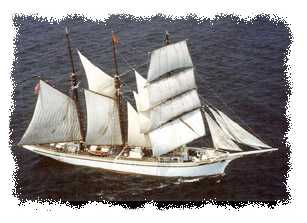 The Gazela Primeiro is a tall sailing ship which has become a regular visitor to the Philadelphia waterfront at the foot of Market Street.
The Gazela Primeiro is a tall sailing ship which has become a regular visitor to the Philadelphia waterfront at the foot of Market Street.
Harvard Progressives in Philadelphia
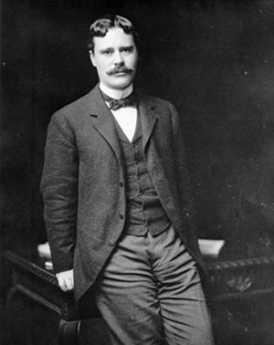 The Progressive movement of the early 20th century was a strange hodge-podge of political reformers, nostalgic aristocrats, would-be socialists, and anti-immigrant. The central figure was Theodore Roosevelt, traveling in strange company like Owen Wister, Robert M. LaFollette, Henry James, and Henry Adams. The Philadelphia link seems to have been through Harvard.
The Progressive movement of the early 20th century was a strange hodge-podge of political reformers, nostalgic aristocrats, would-be socialists, and anti-immigrant. The central figure was Theodore Roosevelt, traveling in strange company like Owen Wister, Robert M. LaFollette, Henry James, and Henry Adams. The Philadelphia link seems to have been through Harvard.
Benjamin Franklin, Prophet
 Ben Franklin was not exactly religious, but for one dominating American theme, Poor Richard is the prophet.
Ben Franklin was not exactly religious, but for one dominating American theme, Poor Richard is the prophet.
The University City
 Ben Franklin would scarcely recognize the college he created. It isn't named for him, but he probably would be concerned about how quickly it is changing.
Ben Franklin would scarcely recognize the college he created. It isn't named for him, but he probably would be concerned about how quickly it is changing.
Franklin Endorses the Constitution
 e3Benjamin Franklin never revealed his contributions to the formation of the U.S. Constitution, whether victories or defeats. When the final vote had been taken, he urged unanimous support by the delegates, in the following words.
e3Benjamin Franklin never revealed his contributions to the formation of the U.S. Constitution, whether victories or defeats. When the final vote had been taken, he urged unanimous support by the delegates, in the following words.
TOAST TO E. DIGBY BALTZELL (1915-1996)
 A toast to E. Digby Baltzell (1915-1996), given by Theodore Friend, Sr. at the Franklin Inn Club annual dinner on Franklin's birthday, where toasts are customary.
A toast to E. Digby Baltzell (1915-1996), given by Theodore Friend, Sr. at the Franklin Inn Club annual dinner on Franklin's birthday, where toasts are customary.
Cushman Club for Lonesome Actresses
 One of the ancient Camac Street clubs has closed its doors, to become a charitable foundation.
One of the ancient Camac Street clubs has closed its doors, to become a charitable foundation.
Pipe Organs, and Similar
 The pipe organ is an astonishingly ancient instrument, usually very expensive and hard to maintain, with many individual variations. The electronic organ is catching up and may surpass the pipe organ in a few decades, but that's guessing.
The pipe organ is an astonishingly ancient instrument, usually very expensive and hard to maintain, with many individual variations. The electronic organ is catching up and may surpass the pipe organ in a few decades, but that's guessing.
Lumpers In Constant Combat With Splitters
 The home dinner table is no longer the place most families teach the rules of conduct to each other, probably because of the invasion of homes by television. But there are places where friendly debate is still conducted and social issues are settled. In Philadelphia, newcomers are still taught what's what, in this manner.
The home dinner table is no longer the place most families teach the rules of conduct to each other, probably because of the invasion of homes by television. But there are places where friendly debate is still conducted and social issues are settled. In Philadelphia, newcomers are still taught what's what, in this manner.
Reservoir on Reservoir Drive

Original Intent and the Miranda Decision
 Right before our eyes, we can watch the Miranda decision migrate away from the original intent.
Right before our eyes, we can watch the Miranda decision migrate away from the original intent.
Selection of Constitutional Rights for the Bill of Rights
 James Madison tried to preserve the Union by allowing states some latitude in enforcing civil rights. Eventually, we got a Civil War, a weakening of state legislatures, massive black migration to northern cities, and the Civil Rights Act. It's all about slavery is hard to eliminate.
James Madison tried to preserve the Union by allowing states some latitude in enforcing civil rights. Eventually, we got a Civil War, a weakening of state legislatures, massive black migration to northern cities, and the Civil Rights Act. It's all about slavery is hard to eliminate.
RR Monopoly Self-Destructs
 Railroads are inherently monopolies. That breeds regulation, and from there on, it's downhill.
Railroads are inherently monopolies. That breeds regulation, and from there on, it's downhill.
Cleaning Up The Railroad Mess 1974
 Bankrupting the nation's freight trains aren't as bad as an atomic explosion, but it's worse than the average catastrophe, and the Supreme Court was faced with fixing it.
Bankrupting the nation's freight trains aren't as bad as an atomic explosion, but it's worse than the average catastrophe, and the Supreme Court was faced with fixing it.
Last Will of Benjamin Franklin
 The Franklin Institute of Philadelphia has reproduced Dr. Franklin's last will and testament on the Internet. It is copied here for reader convenience.
The Franklin Institute of Philadelphia has reproduced Dr. Franklin's last will and testament on the Internet. It is copied here for reader convenience.
Future Directions for Book Authoring
 Personal computers have already revolutionized book authorship by greatly expanding it, and revolutionized book publishing by drowning it in authorship. What comes next?
Personal computers have already revolutionized book authorship by greatly expanding it, and revolutionized book publishing by drowning it in authorship. What comes next?
Lowering the Taxes on Corporations
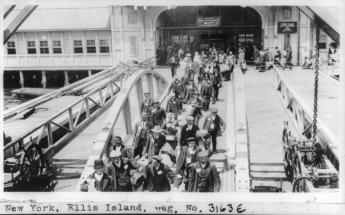 When Ireland lowered corporate taxes, inviting corporate immigration, and then precipitating an international financial crisis, it drew attention from others. Instead of warning them, it encouraged them to imitate Ireland.
When Ireland lowered corporate taxes, inviting corporate immigration, and then precipitating an international financial crisis, it drew attention from others. Instead of warning them, it encouraged them to imitate Ireland.
Foreground: Parliament Irks the Colonial Merchants
 The Townshend Acts, upsetting trade and hated by Americans, bordered on economic warfare. The British tested tea, stamps and manufactures, but the most effective economic pressure points proved to be paper money and gunpowder. The Americans reacted to all this as second-class citizenship.
The Townshend Acts, upsetting trade and hated by Americans, bordered on economic warfare. The British tested tea, stamps and manufactures, but the most effective economic pressure points proved to be paper money and gunpowder. The Americans reacted to all this as second-class citizenship.
Power of the Purse
 Establishing and revising a national debt limit was a mistake in 1917. Its mistakenness becomes progressively more evident as national debt approaches the point where we could not possibly pay it off, and several foreign countries demonstrate what can then happen.
Establishing and revising a national debt limit was a mistake in 1917. Its mistakenness becomes progressively more evident as national debt approaches the point where we could not possibly pay it off, and several foreign countries demonstrate what can then happen.
The Virginian: A Philadelphian Goes West
 Owen Wister, that unchallenged example of the Philadelphia Gentleman, established his literary reputation as creator of the American Cowboy in his first novel.
Owen Wister, that unchallenged example of the Philadelphia Gentleman, established his literary reputation as creator of the American Cowboy in his first novel.
William James and the Progressive Movement
 Did William James start the Progressive Movement?
Did William James start the Progressive Movement?